Circuit-Zone.com - Electronic Projects
Posted on Monday, March 3, 2025 • Category: FM Transmitters

This little 88-108MHz FM transmitter has a range of up to 1 mile in the open. The transmitter consists of three stages. The first stage is an audio pre-amplifier built around 2SC9014 transistor, second stage is an oscillator built using 2SC9018 transistor, and third stage is an RF amplifier built around 2SC9018 transistor. RF amplifier stage increases an output power, range and stability by separating the antenna from the oscillator.
Posted on Friday, June 7, 2024 • Category: FM Radio / Receivers
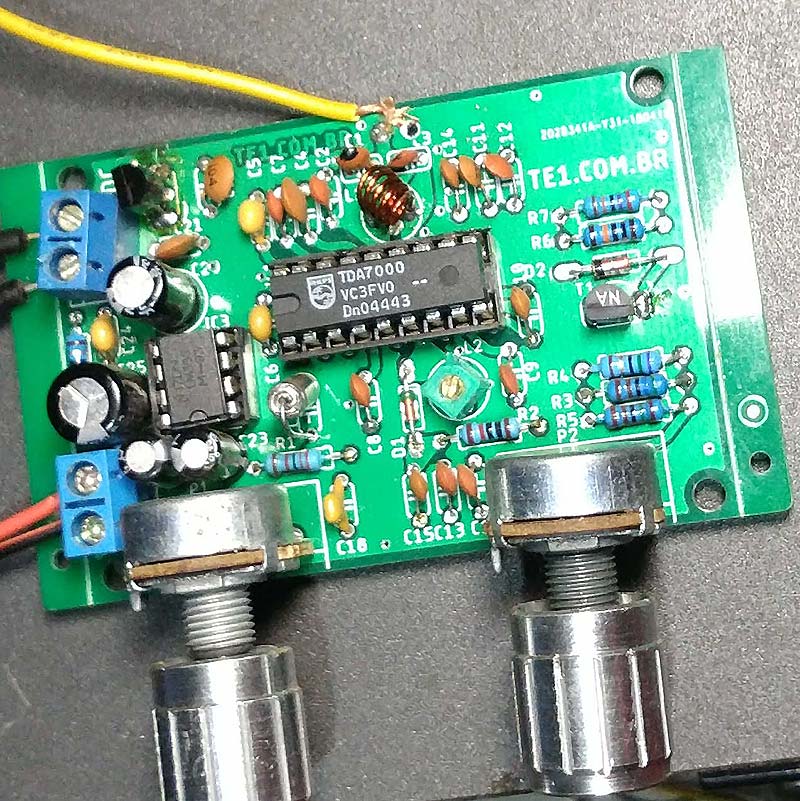 Simple circuit and easy to assemble DIY TDA7000 FM radio receiver with LM386 amplifier chip. Assembling an FM radio is always something interesting to the electronics enthusiast. TDA7000 which integrates a mono FM radio all the way from the aerial input to the audio output. Outside of the TDA7000 IC there is only one tunable LC circuit for the local oscillator, a few inexpensive ceramic capacitors and one resistor. The TDA7000 dramatically reduces assembly and post production alignment costs because only the oscillator circuit needs adjustment during manufacture to set the limits of the tuned frequency band. The complete FM radio can be made small enough to fit inside a calculator, cigarette lighter, key-ring fob or even a slim watch. The TDA7000 can also be used as receiver in equipment such as cordless telephones, CB radios, radio-controlled models, paging systems, the sound channel of a TV set or other FM demodulating systems.
Posted on Monday, February 5, 2024 • Category: FM Transmitters
 Build your own fairly simple high quality stereo FM transmitter circuit as shown in the photo. The circuit is based on the BA1404 chip from ROHM Semiconductors and S9018 amplifier for extending tansmitter's range. BA1404 is a monolithic FM stereo modulator that has built in stereo modulator, FM modulator, RF amplifier circuits. The FM modulator can be operated from 76 to 108MHz and the power supply for the circuit can be anything between 6 to 12 volts.
Posted on Tuesday, December 12, 2023 • Category: Power Supplies
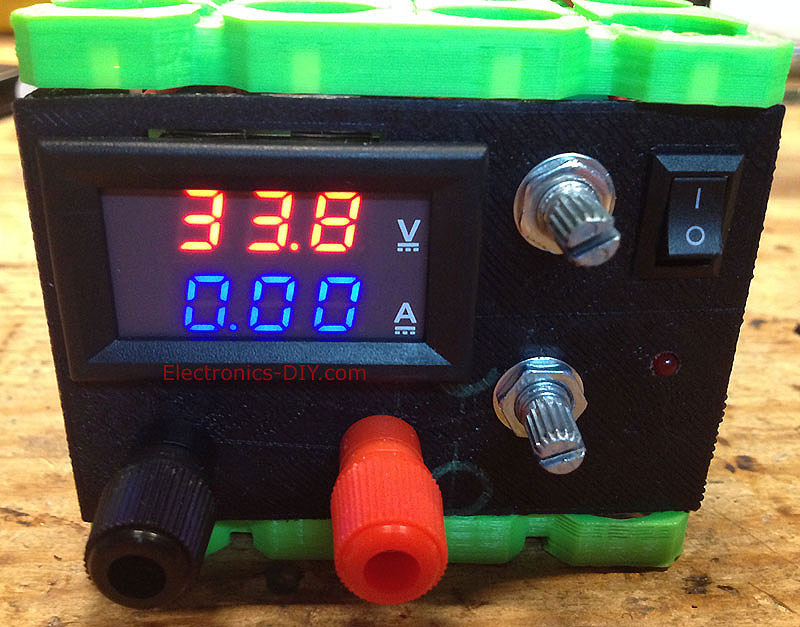 I have gone without a variable lab bench power supply for too long now. The power supply that I have been using to power most of my projects has been shorted out too many times. I have actually killed 2 by accident and needed a replacement. I had many 18650 lipo batteries lying around my workshop so I decided to use them to build a portable variable bench power supply that could be easily moved around and used on the go. The power supply consists of DC-DC step up power module, voltage and current display, a switch, standard size 10K trim pots, XT-60 and a balance connector for charging an array of 8x4 18650 batteries.
Posted on Friday, July 28, 2023 • Category: FM Transmitters
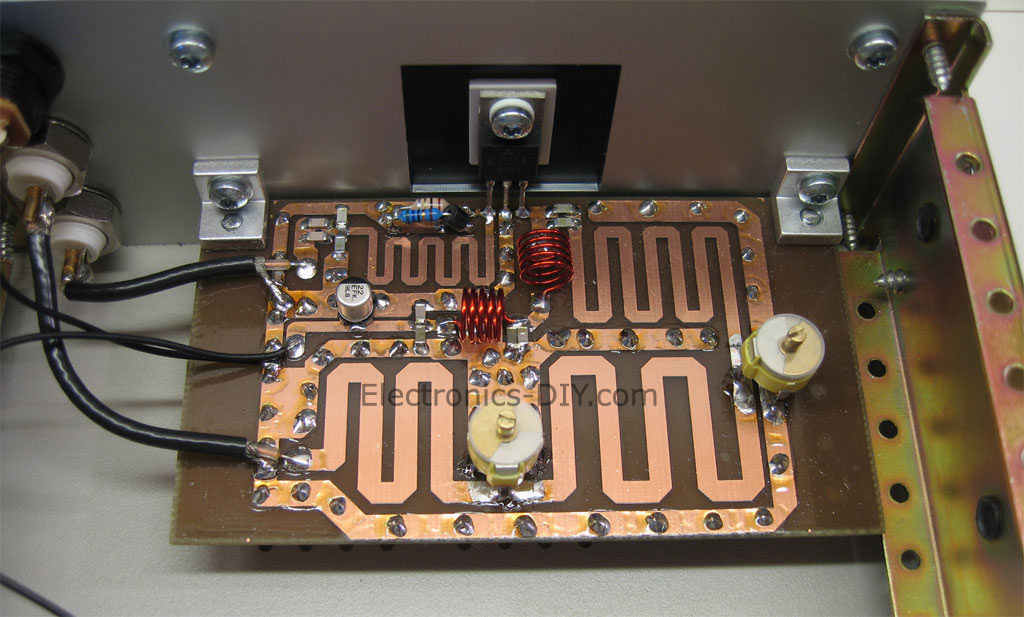 1 Watt FM Transmitter amplifier with a reasonably balanced design specified to boost a RF frequency in the 88 – 108 MHz spectrum. It may be considered a fairly sensitive configuration when used with quality RF power amplifier transistors, trimmers and inductors. It involves a power amplification factor of 9 to 12 dB (9 to 15 times). At an input power of 0.1W the output may be well over 1W. It's advisable to choose T1 transistor on the basis of the input voltage. For 12V voltage it is recommended to use transistors such as 2N4427, KT920A, KT934A, KT904, BLX65, 2SC1970, BLY87. For 18-24V voltage may may want to use transistors such as 2N3866, 2N3553, KT922A, BLY91, BLX92A. You may also consider using 2N2219 with 12V input voltage however that would only produce an output power of around 0.4W.
Posted on Friday, October 14, 2022 • Category: Miscellaneous
 Modern model railroads are digitally controlled using a Digital Command Control (DCC) protocol similar to network packets. These data packets contain device address and instruction set that is embedded in the form of AC voltage and fed to train track to control locomotives. The great advantage of DCC over analog DC control is that you can independently control the speed and direction of many locomotives on the same train track as well as control many other lights and accessories using that same signal and voltage. Commercial DCC decoders are available on the market however their cost can add up pretty quickly if you have a lot of devices to control. Luckily you can build a simple Arduino DCC decoder yourself to decode DCC signal and control up to 17 LEDs / accessories per each DCC decoder.
Posted on Tuesday, February 1, 2022 • Category: FM Radio / Receivers
 This is perhaps one of the simplest and smallest FM receivers for receiving local FM stations. It's simple design makes it ideal for a pocket sized FM receiver. The audio output of the receiver is amplified through LM386 amplifier chip that can drive a small speaker or headphones. The circuit is powered by three AAA or AA battery cells. FM receiver section uses two RF transistors for converting frequency modulated signals to audio. L1 coil and variable capacitor form a tuned tank circuit that is used for tuning to any available FM stations.
Posted on Thursday, January 20, 2022 • Category: FM Transmitters
 This a build of a well known FM transmitter called Veronica. Transmitter was built on two separate boards. The first board (pictured above) is the Veronica transmitter itself with output power of 600mW when powered by 12V voltage or 1W when powered by 16V voltage. The second board is an RF power amplifier that uses 2SC1971 transistor to amplify Veronica's output signal to around 7 Watts. Although transmitter can be powered with 9-16V voltage, it is recommended that both transmitter and amplifier is powered by 12V voltage as 600mW is an upper limit for driving 2SC1971 transistor.
Posted on Tuesday, January 4, 2022 • Category: FM Transmitters
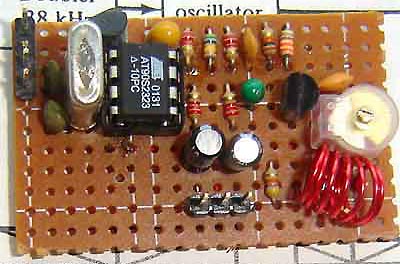 I had been fascinated with the idea of making simple stereo encoder for building Stereo FM Transmitter. Not that stereo means much to me away from the computer. I use an FM broadcast transmitter to relay the output of my computers to FM radios in the kitchen, the bedroom, the driveway, and out in the garden. Under those circumstances, I find that mono is plenty, whether it is music or radio programs from over the internet, since I am primarily occupied with something else anyway. When on my hands and knees in the garden, all the way up to my elbows in planting a bush, the music really does not seem any more sweet when its stereo. But that did not stop me from being fascinated with the idea of making a stereo encoder. Stereo always seemed like a lot of circuitry and bother for the slight benefit that came with it. That is, until a few weeks ago.
Posted on Friday, December 24, 2021 • Category: FM Radio / Receivers
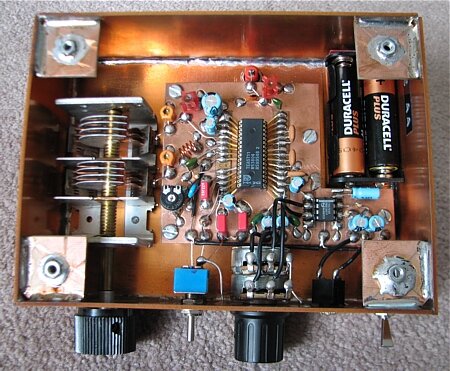 High sensitivity TEA5711 receiver allows the reception of distant stations from over 150 miles (240 km) away. Good selectivity is obtained with narrow bandwidth ceramic filters. AFC automatic frequency control locks on stations for drift-free reception. Stereo separation which depends on signal strength is very apparent on strong signals. And with high quality headphones, the sound is rich with deep base and high treble, for hours of enjoyable stereo music.
Posted on Friday, October 1, 2021 • Category: FM Transmitters
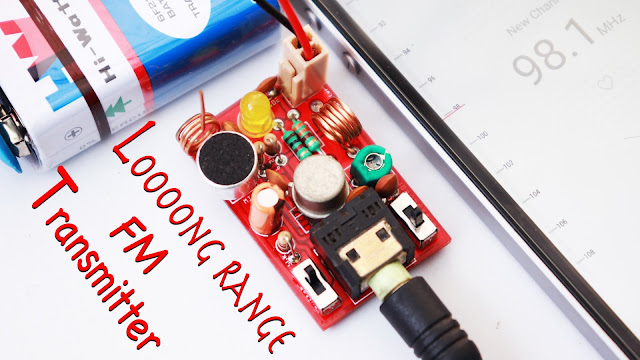 Ever wondered how come you can just simply tune in to your favorite FM Radio Channel. Moreover, ever had the curiosity of making your own FM Station on a specific frequency? Well if the answer is Yes to any of those questions then you are at the right place!. We are going to look into making small FM Transmitter for Hobby Purposes with a really basic component guide and components that are readily available off the shelf.
Posted on Tuesday, August 31, 2021 • Category: Amplifiers
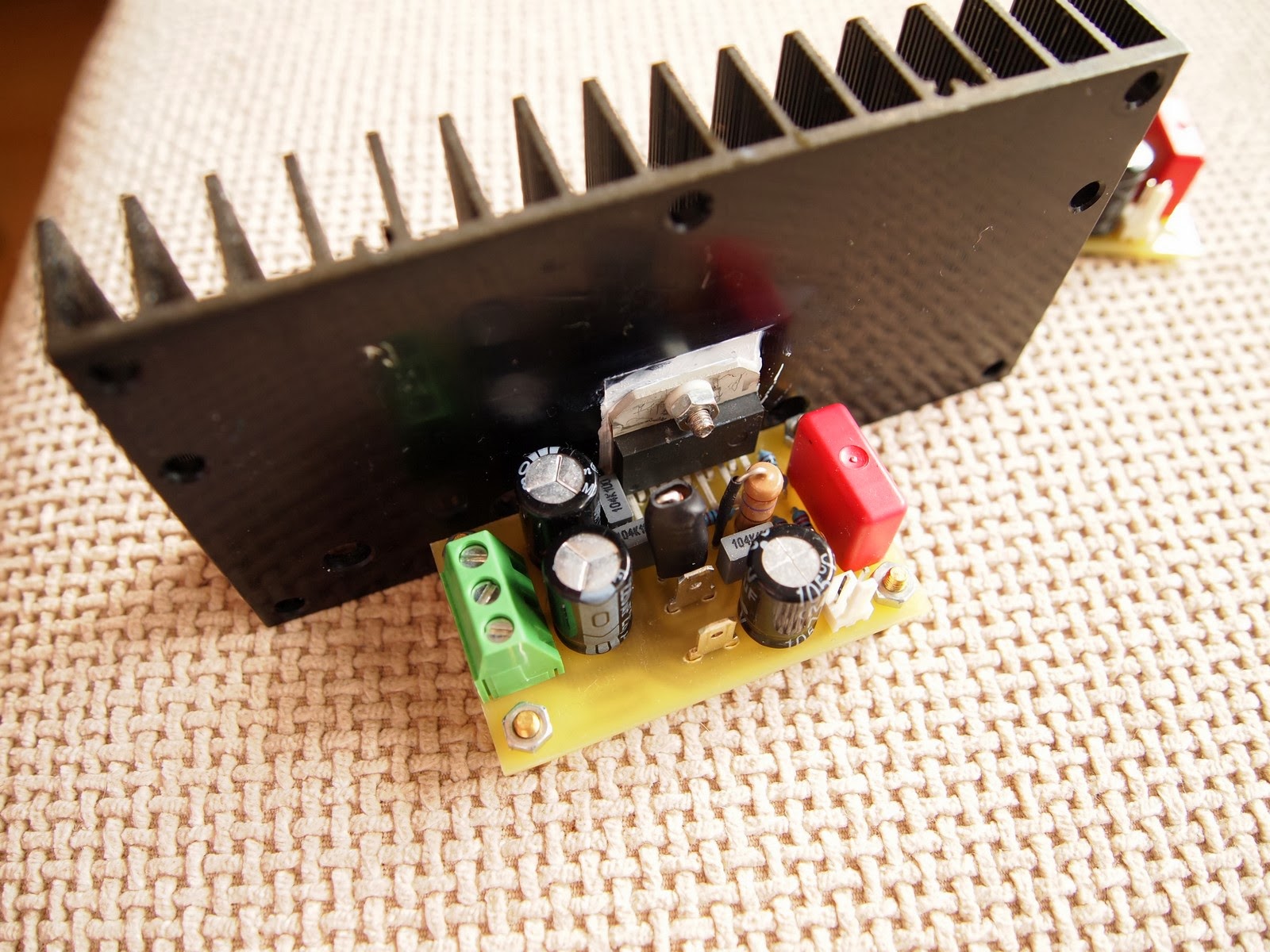 This is my second encounter with LM3886. I was pleased with the sound this chip produced the first time, so I decided to make another amplifier with it. The schematic is based on the schematic in the datasheet of the chip with minor changes. I removed the time delay capacitor connected to MUTE pin, because it’s better to use separate DC protection schematic which has similar functionality. I made the output inductance L1 by winding 15 turns of enameled wire around the resistor R7. The diameter of the wire must be minimum 0.4mm. The whole was wrapped with heat shrink. I used 47uF/63V non polarized capacitor for C2. It can be regular electrolytic capacitor, but it’s better to use non-polarized or bipolar.
Posted on Tuesday, June 29, 2021 • Category: FM Transmitters
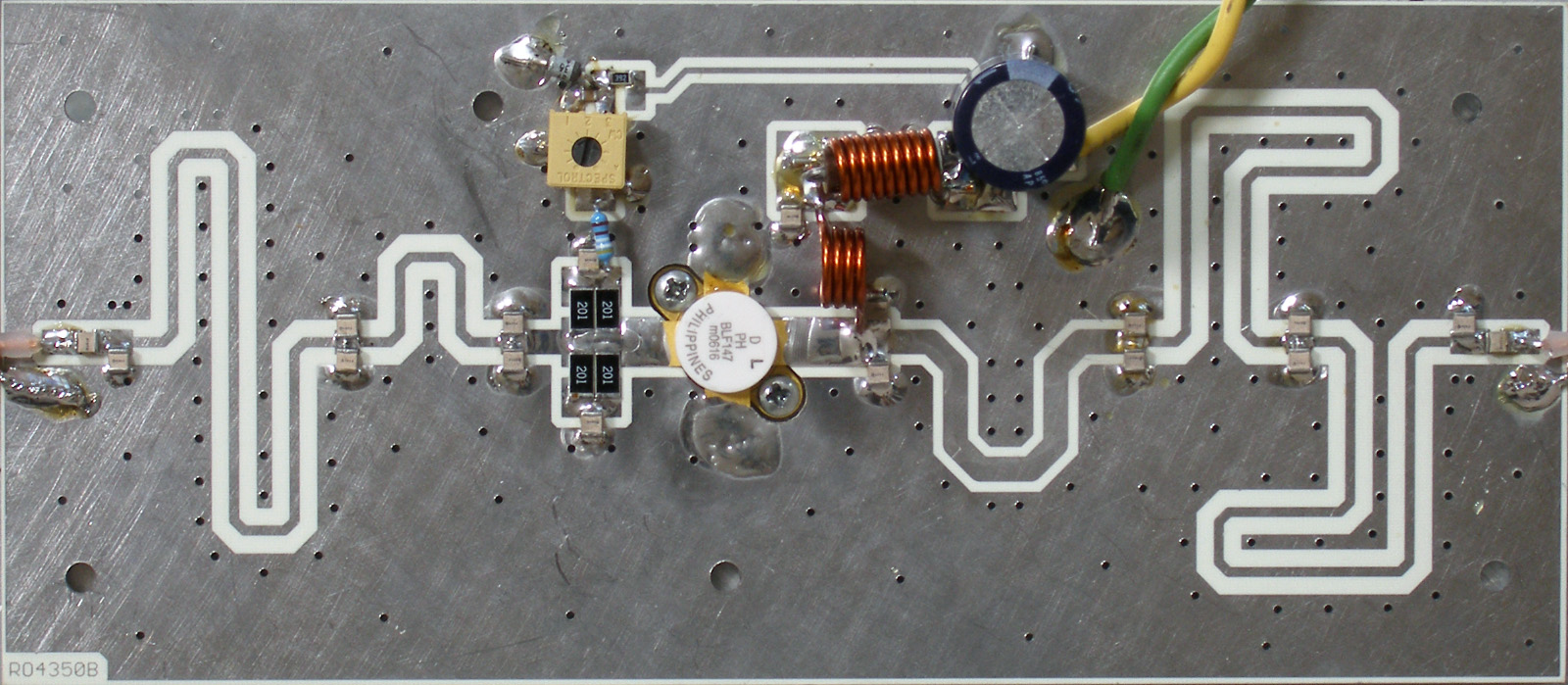 One of the very latest developments here is 150W VHF transmitter amplifier with BLF147 power transistor. Results are very impressive with well over 150W across the band with 10W input and 24 VDC supply. Over 200W is achieved at 28 VDC, and over 250W with a hot bias 4-5A quiescent. PCB is teflon glass board with printed transmission lines and porcelain caps. No external harmonic filter is needed, as the filtering is built into the matching network.
Posted on Wednesday, May 26, 2021 • Category: Power Supplies
 This circuit uses an LM317 regulator, chosen because of its built-in over-current and over-temperature protection. Its output is boosted up to 5A by the MJ2955 transistor. The output voltage is varied by adjusting VR1 potentiometer. Adjustable current limiting from 60mA to 5A is provided by op amp TL071 IC that is used as a comparator which monitors the voltage across the 0.1 Ohm current sensing resistors.
Posted on Monday, April 12, 2021 • Category: FM Transmitters
 There are many applications for an FM transmitter, particularly if it can broadcast in stereo. You can broadcast stereo signals from your CD player or any other source to an FM tuner or radio. This FM Transmitter uses a single BA1404 IC and a few other components. It broadcasts on the 88-108MHz FM band so that it can be received by any standard FM tuner or portable radio. Transmitter runs from a 5V supply and can drive a dipole antenna for improved range.
Posted on Monday, February 22, 2021 • Category: Amplifiers
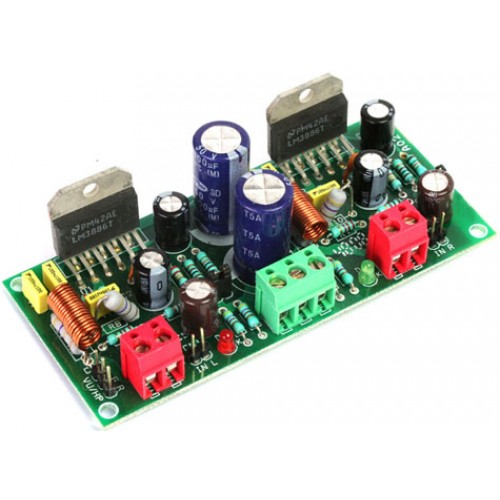 The LM3886 is a high-performance audio power amplifier capable of delivering 68W of continuous average power to a 4? load and 38W into 8? with 0.1% THD+N from 20Hz–20kHz. The performance of the LM3886, utilizing its Self Peak Instantaneous Temperature SPiKe protection circuitry, puts it in a class above discrete and hybrid amplifiers by providing an inherently, dynamically protected Safe Operating Area. SPiKe protection means that these parts are completely safeguarded at the output against over voltage, under voltage, overloads, including shorts to the supplies, thermal runaway, and instantaneous temperature peaks. The LM3886 maintains an excellent signal-to-noise ratio of greater than 92dB. It exhibits extremely low THD+N values of 0.03% at the rated output into the rated load over the audio spectrum, and provides excellent linearity with an IMD typical rating of 0.004%.
Posted on Wednesday, February 10, 2021 • Category: FM Transmitters
 This project is the construction of FM transmitter circuit for commercial radio frequencies between 88 MHz and 108 MHz. The transmitter is easy to build and offers good frequency stability through the usage of UA741 oamp. 1Km range can be achieved when powered by 9V battery with 30cm long telescopic antenna.
Posted on Tuesday, November 24, 2020 • Category: FM Transmitters
 The circuit presented here uses a crystal oscillator and frequency multiplier to generate a highly-stable carrier signal frequency of 96MHz. It can be used to transmit voice or music up to hundred meters. The circuit is built around 9018 transistor, 24MHz crystal, air coil and a few other basic components.
Posted on Wednesday, November 18, 2020 • Category: Miscellaneous
 Build an adjustable auto power On Off delay timer circuit using CD4541 timer. This electronic timer circuit is helpful when you need to power On/Off any AC Appliances after a pre-defined duration. Delay time it can be adjusted from about 2 to 120 seconds.
Posted on Monday, October 5, 2020 • Category: Power Supplies
 Every electronics hobbyist needs at least one bench power supply in his house for tinkering with some weekend projects. This small power supply was built with an old 19V 3A laptop charger and buck-boost converter. Output voltage is continuously adjustable from 1.25V to 33V with up to 3A current. I have been using it for 3 weeks now and have realized that I am using it more than I thought I would.
Posted on Tuesday, June 2, 2020 • Category: FM Transmitters
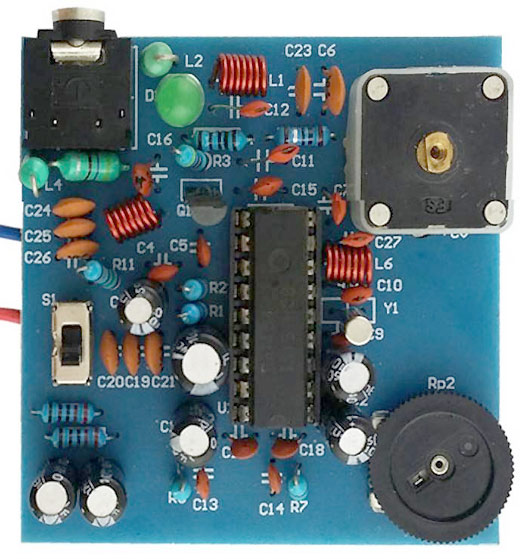 This is a classic low-cost stereo FM transmitter that can send your signal to a FM receiver within 500 meter range. This transmitter uses the famous BA1404 all-in-one chip and operates from 5v power supply. Stereo channel separation is excellent. You can even use this as a front-end stereo RF signal generator for a large FM transmitter setup; by adding step-by-step RF amplifier. A few inch long copper wire can be soldered at the PCB to use as an antenna. The gang-condenser can be used to adjust frequency output. You can use this with your iPod or other audio source, inside your home or car on in an outdoor garden party or wherever you use.
Posted on Monday, May 4, 2020 • Category: Power Supplies
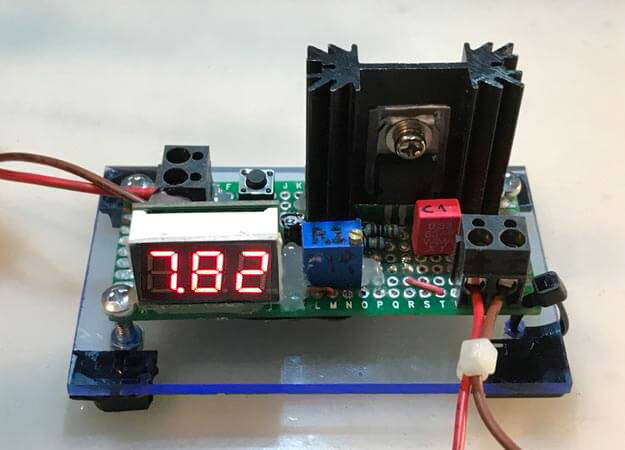 The LM350 is a tried and true 3A adjustable voltage regulator. It accepts an input voltage up to 35V and can deliver an output voltage between 1.25 and 33V. It is rugged beyond belief. Where fairly beefy step-down converters go up in smoke, the LM350 just takes a nap. And a nap is infinitely better than a plume of smoke. LM350 can also be used to limit current though that requires a separate LM350/LM317 in series with our voltage regulator.
Posted on Tuesday, April 14, 2020 • Category: FM Transmitters
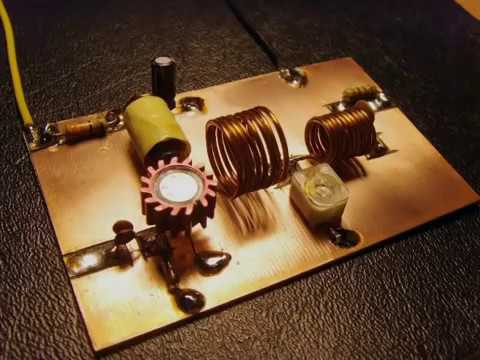 This is 1 Watt FM amplifier with a good design that can be used to amplify RF signal of low power FM Transmitters in the 88 – 108 MHz band. It is very sensitive if you use good RF power amplifier transistors, trimmers and coils. It has a power amplification factor of 9 to 12 dB (9 to 15 times). At an input power of 0.1W the output will be 1W. You must choose T1 depending on applied voltage. If you have a 12V power supply then use transistors like: 2N4427, KT920A, KT934A, KT904, BLX65, 2SC1970, BLY87. At 18 to 24V power supply you must use transistors like: 2N3866, 2N3553, KT922A, BLY91, BLX92A. You may use 2N2219 at 12V but you will get maximum output power of 0.4W.
Posted on Monday, March 23, 2020 • Category: Amplifiers
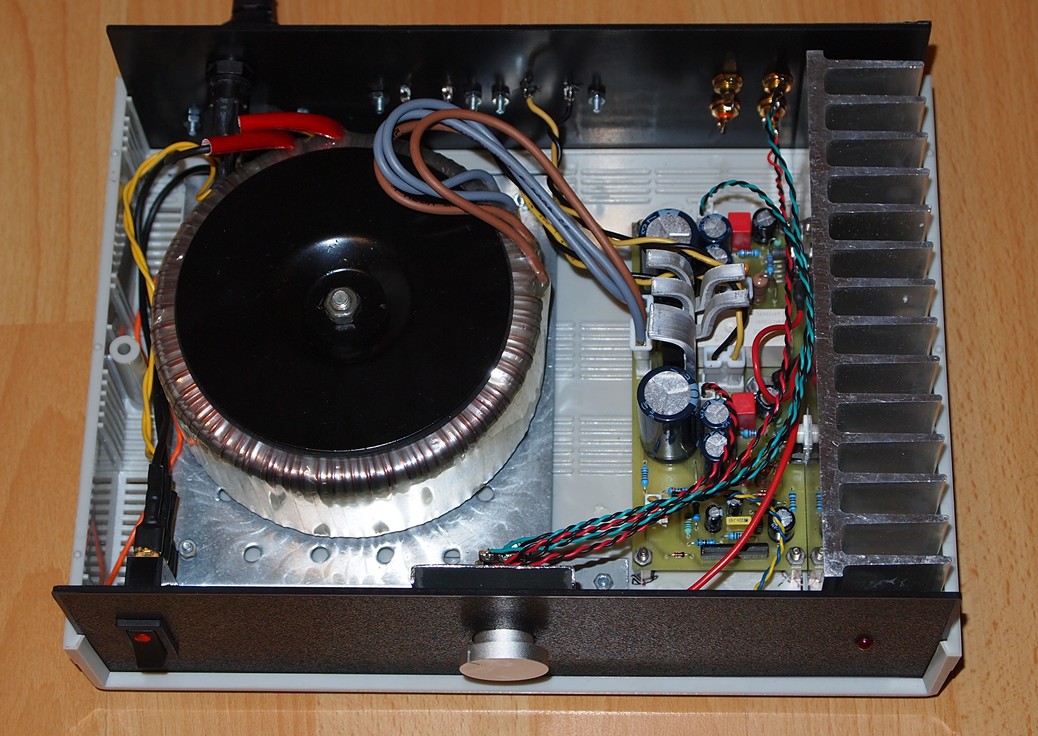 This is 2x30W audio amplifier based on TDA2050 and LM1875. Amplifier PCB is suitable for both TDA2050 and LM1875 chips. Amplifier has all the necessary circuitry on board – power supply, speaker protection, delayed turn-on and fast turn-off. This is achieved using the convenient uPC1237 IC. TDA2050 and LM1875 are pin to pin compatible, the differences in their schematics are the values of a couple resistors and one capacitor. All this allows to make an universal circuit board, suitable for any of these two ICs.
Posted on Monday, March 2, 2020 • Category: FM Transmitters
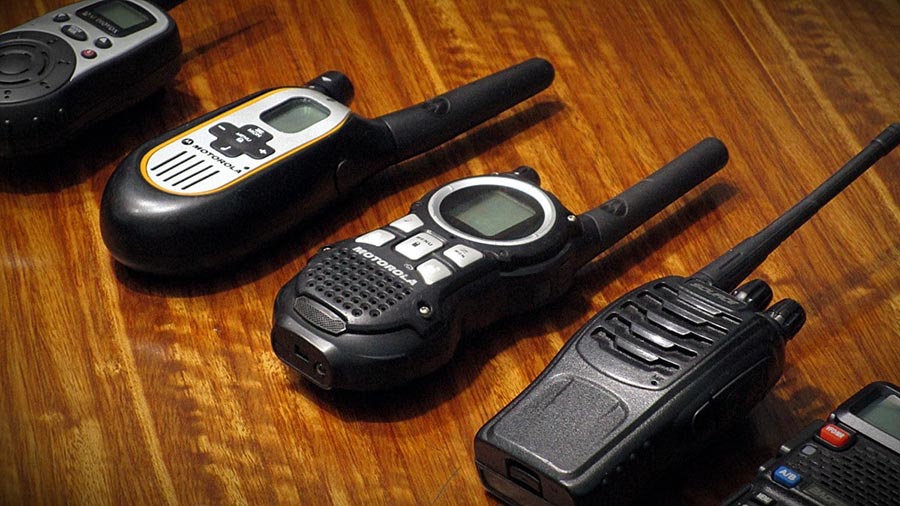 RF projects are always special and I am confident that almost every engineer or enthusiast want to try building a RF project. Because of this we have put together a guide for building a super cool Walkie Talkie project. Walkie Talkie is a half duplex wireless communication device that is capable of establishing communication within short range. Half Duplex means only one user can speak or send his message at a time and communication cannot happen simultaneously. These devices are widely used by Security Personal, Industrial workers and so on. Of course it can make a great toy as well. This guide explains about a Walkie Talkie circuit that allows user to establish communication with another identical device within a range of 30m.
Posted on Tuesday, February 11, 2020 • Category: FM Transmitters
 This is a good quality FM transmitter with 5km range and stable frequency brought by the modified oscillator, which is actually two oscillators built around Q2 and Q3 working at around 50MHz in anti-phase. The output is taken at the two collectors, where the frequencies of the two oscillators combine to form FM signal. This will provide a greater stability than normal single ended oscillators.
Posted on Sunday, February 2, 2020 • Category: FM Transmitters
 Every laboratory needs a few critical devices, the most important of which is a power supply for powering the projects. But as demand grows and the projects get bigger a professional and adjustable power supply becomes a necessity. Here is an adjustable 50V/5A power supply with a variable output from 0V to 50V and adjustable current limiting from 0A to 5A. Most simple power supplies cant get the output to come down to exactly 0V or 0A. But in this circuit, the differential amplifiers have a negative power supply rail at (-3V), which can pull the output down to exactly zero.
Posted on Wednesday, January 22, 2020 • Category: FM Transmitters
 This tiny FM transmitter can be used for varierty of applications such as monitoring, running your own radio station, etc. It can run on a voltage between 3 and 13 volts, draws 2-3 milliamps and has a theoretical output power of 3 milliamps although you could easily increase that by adding an RF amplifier.
Posted on Tuesday, January 7, 2020 • Category: FM Transmitters
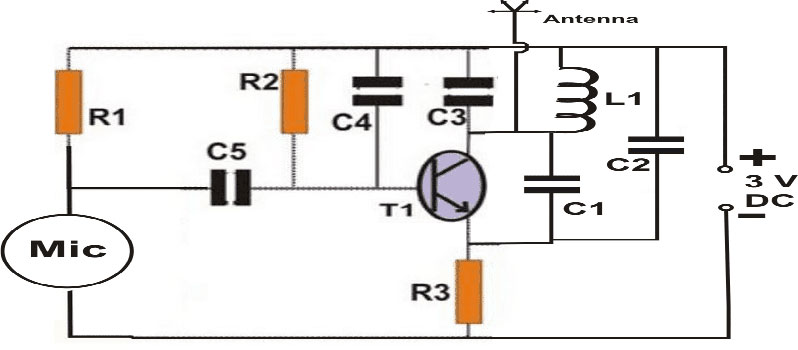 The above wireless FM transmitter circuit is basically a small RF transmitter built around a single transistor. The circuit functions quite like a Colpitts oscillator incorporating a tank circuit for the generation of the required oscillations. The frequency mainly depends on the positioning and the values of the inductor, C1, C2 and C3. The coil turn distance and diameter may be manipulated a little for optimizing best response over the FM receiver. A small antenna in the form of a 3 inches wire may be attached at the shown point for making the “bug” highly responsive and generates distortion free signals.
Posted on Tuesday, December 10, 2019 • Category: FM Transmitters
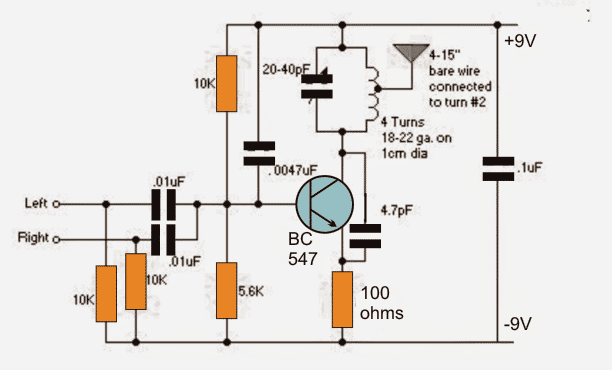 If you want your tiny FM transmitter circuit to transmit music instead of spying or eavesdropping, you would probably find the following design interesting. The proposed FM transmitter will allow combining a stereo input simultaneously from the source so that the info contained inside both the channels get into the air for an optimal reception. The stability of the transmitter is improved by tapping the antenna from one top turn of the coil as shown in the above circuit.
Posted on Thursday, November 28, 2019 • Category: Motor Controllers
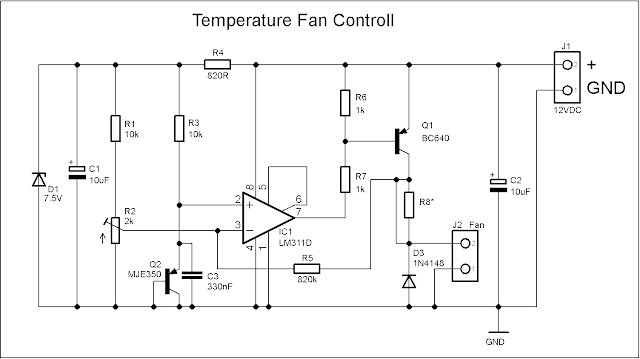 I published this schematic long ago in this article: Adjustable power supply and since then I made some improvements in PCB to make the board as small as possible. The idea is to be easy to attach the whole board to the heat sink which we want to monitor. The board is only 27mm x 27mm.
Posted on Monday, July 22, 2019 • Category: FM Transmitters
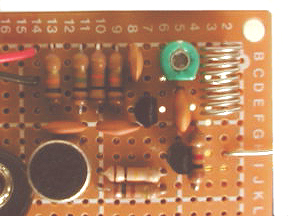 Learn to build your own mini FM transmitter. This fun project will show you how to build a mini broadcasting device that can transmit an audio signal up to a quarter mile to any FM receiver. It's easy to build and a good learning experience.
Posted on Tuesday, June 18, 2019 • Category: FM Transmitters
 With this three stage transistor transmitter we can create and broadcast our mini radio station. We using S9018 transistor because it can handle very high frequencies, up to and including the VHF band. The first transistor on the left is a microphone audio amplifier for modulation. The gain can be adjusted with the potentiometer. The second transistor is the oscillator with a range of 80 to 103 MHz. The frequency can be changed with the upper coil 4T5 by pulling it slightly apart. The signal from the oscillator is very small, so that still needs to be amplified. The right most transistor is therefore an RF amplifier. This amplifies the signal from the oscillator to feed to the antenna. This transistor also immediately provides more stability, because the oscillator is not directly connected to the antenna.
Posted on Friday, June 14, 2019 • Category: Miscellaneous
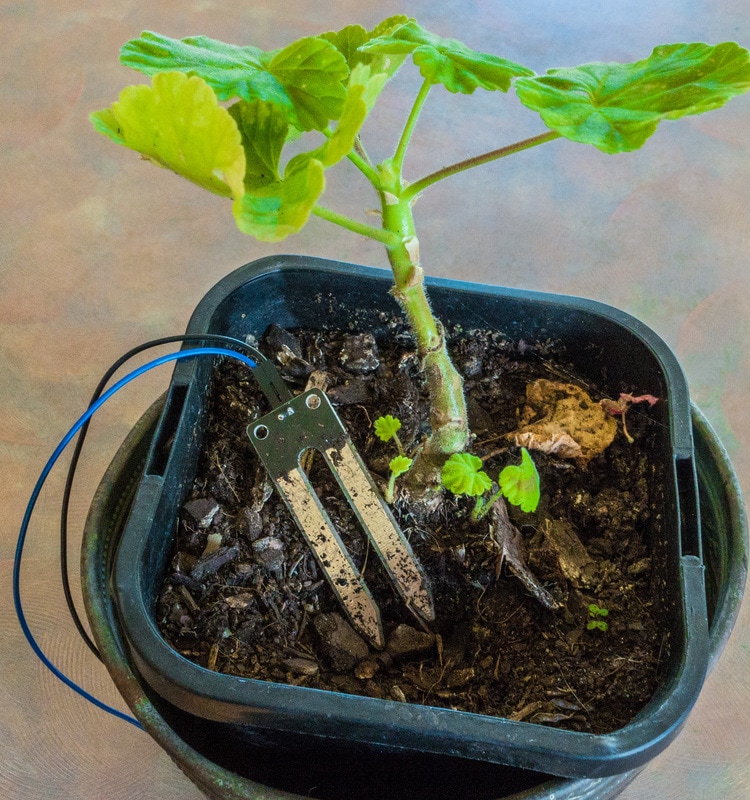 This is a simple arduino project for a soil moisture sensor that will light up a LED at a certain moisture level. It uses Arduino Duemilanove microcontroller board. Two wires placed in the soil pot form a variable resistor, whose resistance varies depending on soil moisture. This variable resistor is connected in a voltage divider configuration, and Arduino collects a voltage proportional to resistance between the 2 wires.
Posted on Tuesday, June 4, 2019 • Category: FM Transmitters
 With a matching antenna, the FM transmitter circuit shown here can transmit signals up to 2 kilometers. The transistor Q1 and Q2 forms a classic high sensitive preamplifier stage. The audio signal to be transmitted is coupled to the base of Q1 through capacitor C2. R1, R3, R4, R6, R5 and R9 are the biasing resistors for the preamplifier stage comprising of Q1 and Q2. Transistor Q3 performs the collective job of oscillator, mixer and final power amplifier. C9 and L1 forms the tank circuit which is essential for creating oscillations. Inductor L2 couples the FM signal to the antenna.
Posted on Monday, April 15, 2019 • Category: Headphone Amplifiers
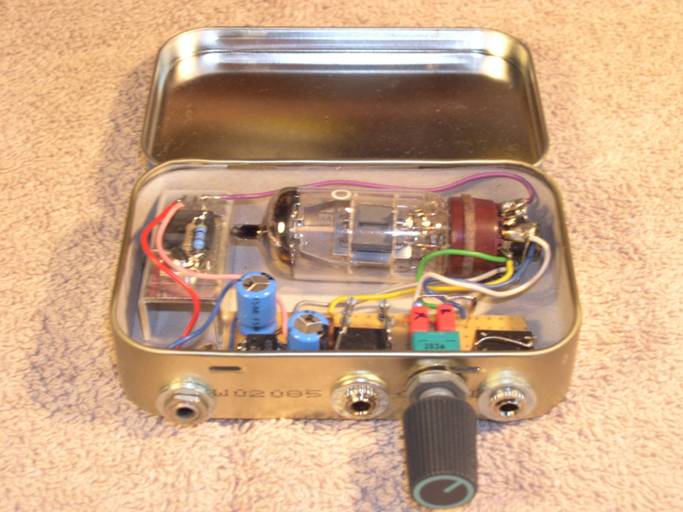 This little tube amplifier is easy to build and will fit into a small metal Altoids box and can be carried around. It can be build with few common parts, that should be readily available. Amplifier works with many tubes like 6DJ8, ECC88, 6922, 12AT7, 12AX7, DAF96, 1T4, etc. It is powered by 12V supply and power consumption may be optimized to allow for small rechargeable battery packs.
Posted on Monday, February 25, 2019 • Category: Power Supplies
 Presented here is a Laboratory Power Supply with 0-30V voltage and 0-3A current regulation. The schematic is pretty straightforward, it uses standard dual opamps such as TL082, TL062, TL072, NE5532, RC4558 and MC34072. The trimmer P3 adjusts the minimum current limit. P4 adjusts the maximum output voltage. After the final adjustment you may replace the trimmers with standard resistors. Power transistor dissipates quite a bit of heat and thus require a heatsink with optional fan. We may use two or tree transistors in parallel with emitter resistors to achieve more power. The transformer must be 100-120W with 27-30VAC output voltage.
Posted on Friday, February 1, 2019 • Category: FM Transmitters
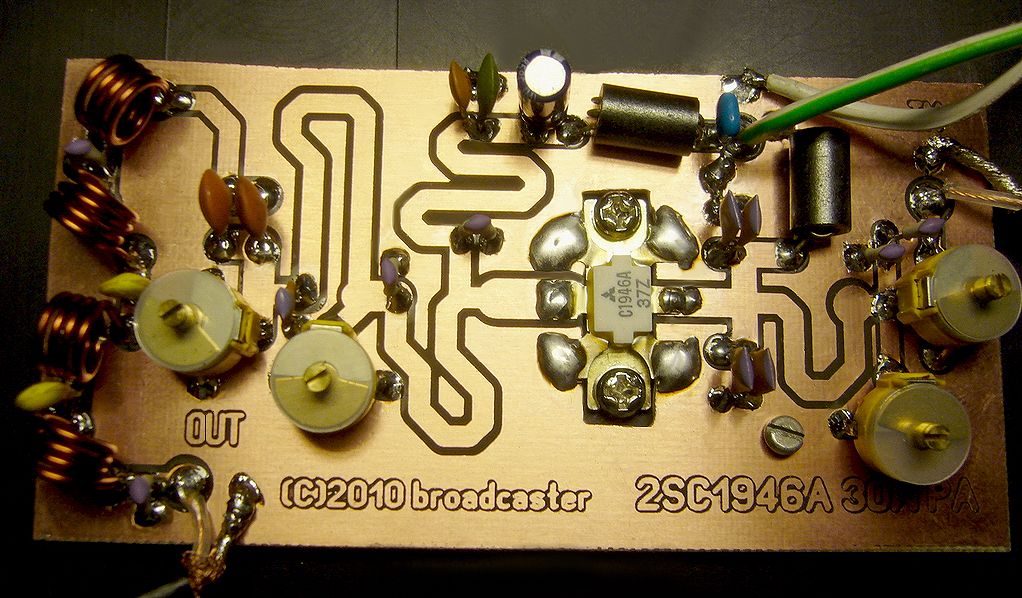 This RF Amplifier designed for FM broadcast using a single 2SC1946 VHF Power Transistor. This 10-30W RF amplifier circuit provides an appropriate power boost with an input of 1-3 watt. Tower are 30 meters high will send signal surrounding air should be around 15 km.
Posted on Tuesday, January 22, 2019 • Category: FM Transmitters
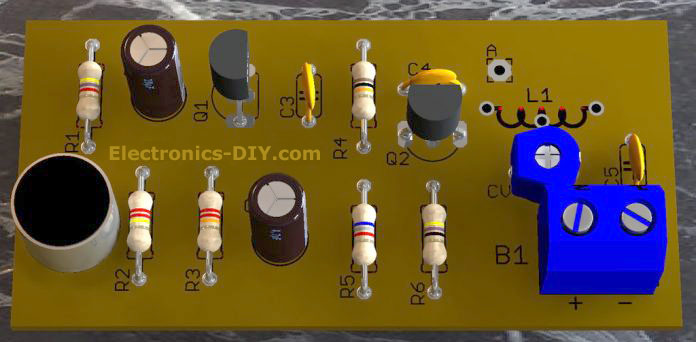 That small circuit transmitter it is ideal for ready espionage for strip from radio Fm or receiver of VHF. Of course the recreational purpose also exists and the children will adore to have a transmitter that allows to speak for a radio FM placed at distant place and like this pretend the secret agent.
Posted on Wednesday, November 14, 2018 • Category: FM Transmitters
 Powerful microtransmitter that can cover 3km range. To amplify the signal, a 2N3866A transistor is used that can provide up to 1W with gain > 10dB (24Volt). In our case the output power is about 100mW depending on the input power of 10mW and 9V battery power supply. The transistor Q1 must be mounted with a heatsink, the heatsink must have small dimensions (cylindrical) in order not to increase the parasitic capacitance. The trimmer R2 serves to adjust the bias of the transistor, start with the trimmer fully open and close by measuring the current absorbed by the 9V, in my case you get 100mW at the output with a current of 50mA not increase this value as you only increase the absorption by heating the transistor without increasing output power, because the input power is too low. Clearly the 9V battery will be able to provide 50mA only for a few hours, if necessary have greater autonomy should be used a larger battery, but it is no longer a bug but simply an FM transmitter.
Posted on Monday, October 29, 2018 • Category: FM Transmitters
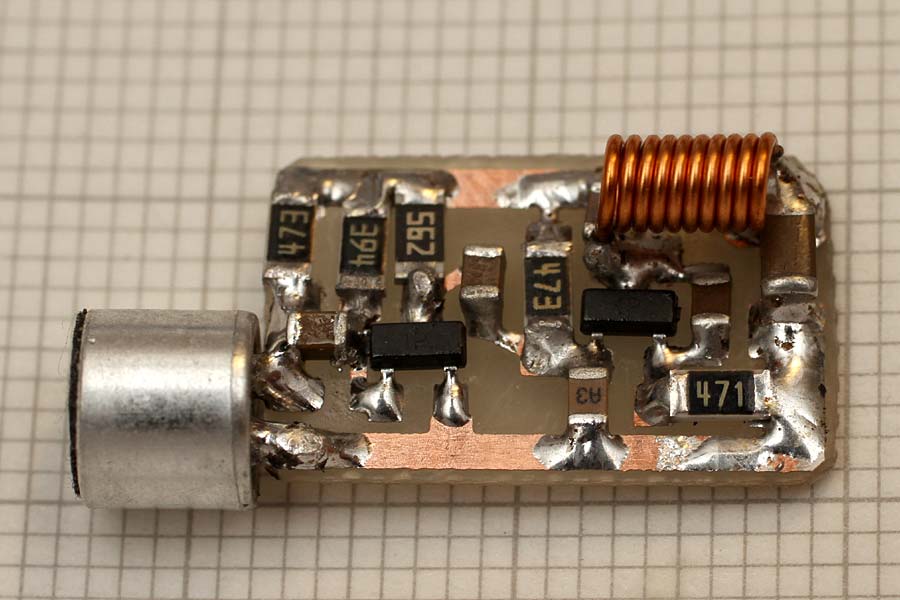 This tiny 88-108Mhz FM transmitter bug measures just 10mm x 17mm in size and as you can see in the photos the biggest components are just the microphone and the battery. You can use a small microphone from an older cell phones, they are small in size and have an excellent sensitivity. For an effective power supply the 9V battery (Duracell) is excellent and allows several hours of battery life, but if you want to have a smaller size it is better to use 2 or 3 lithium cells like the 2032 used in PCs. The circuit works well from 3 to 12V, the maximum range is obtained with 12V and a piece of 40-60cm cable as an antenna.
Posted on Monday, September 10, 2018 • Category: FM Transmitters
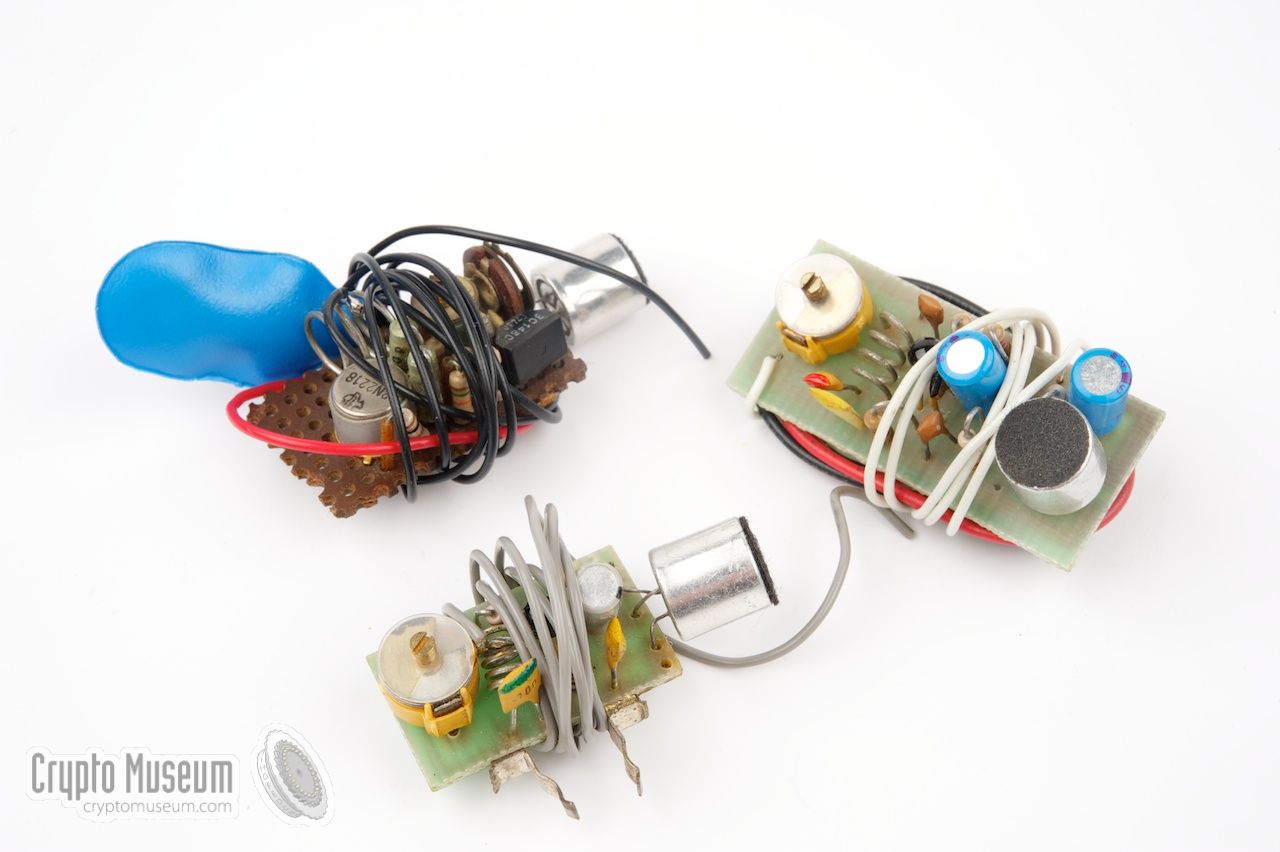 In the mid 1970s large numbers of small FM transmitters, operating in the FM radio broadcast band (88-108 MHz) appeared on the market. It started with a self-build kit from the Danish manufacturer Jostykit that allowed everyone to build a small FM transmitter for a few Euros. Such transmitters generally consist of a single transistor oscillator with a simple resonance circuit, sometimes with an extra transistor that is used as audio pre-amplifier. The image shows a few examples that were available in European electronics shops in the mid 1970s. The transmitter shown here was built in the mid-1970s and measures just 1 x 2 cm. When properly built, it may have a range of several kilometers.
Posted on Wednesday, July 11, 2018 • Category: FM Transmitters
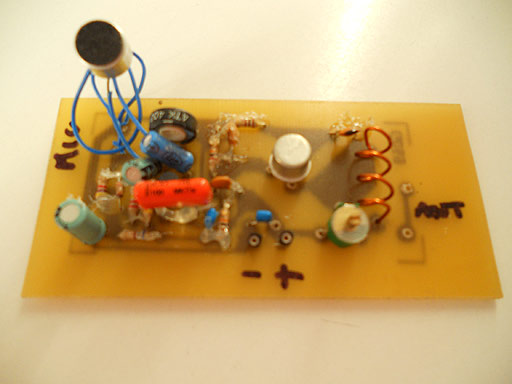 This is a simple, portable transmitter operating in the 88-108 MHz FM band. You may use it to run your own private neighborhood radio, just replacing the microphone capsule with a male audio jack connected to your pc or MP3 player. You may also use this as a spy transmitter, but be reasonable in that case. It's rated for 1 Watt, so you can listen to it even from a few kilometers, with a good antenna and not too much obstacles in the way.
Posted on Tuesday, June 19, 2018 • Category: Audio DAC
 The following is a simple USB DAC Soundcard. It uses PCM2707 that incorporates USB interface to communicate with the computer and audio DAC all in one chip.
Posted on Saturday, May 26, 2018 • Category: Power Supplies
 This project is a solution to power up most of devices or projects requiring dual (+/-) adjustable power supply. The circuit is based on LM317 positive and LM337 negative voltage regulators. LM317 series of adjustable 3 terminal regulator is capable of supplying in excess of 1.5A over a 1.2V to 30V DC output range, due to TO3 package of IC and large heat sink the power supply can handle maximum load current.
Posted on Wednesday, May 2, 2018 • Category: FM Transmitters
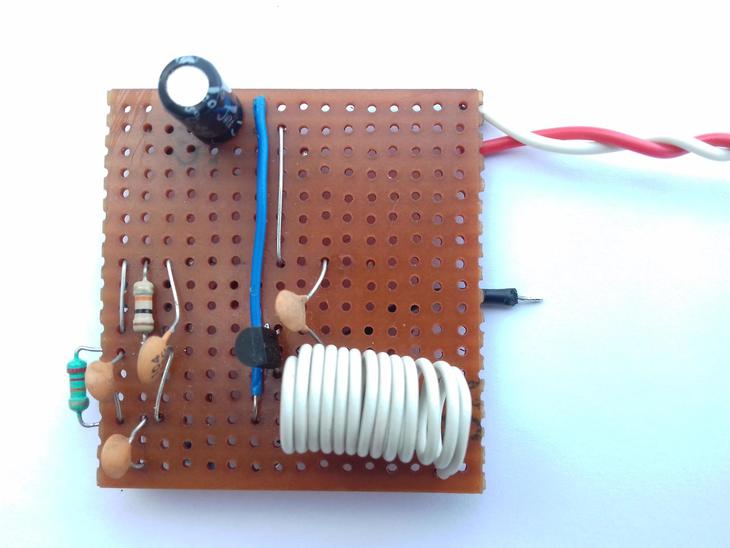 FM transmitter circuit projects are indeed quite popular among electronics hobbyists / students. But the frustrating part is most transmitters refuses to work at all, and secondly the internet is full of crappy transmitter circuits. Designing a stable FM transmitter circuit is rather a difficult job, many calculations are involved their. There are also some construction error and component value tolerance. Here you can find a reasonably stable and well tested transmitter that actually works.
Posted on Monday, March 19, 2018 • Category: FM Transmitters
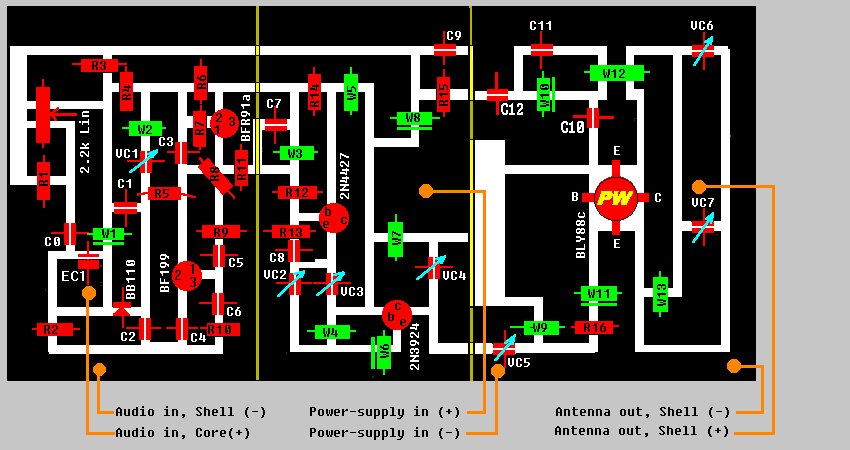 This FM Transmitter is stable and has output power of 15-18 watts. You don't have to understand the precise working of the transmitter to build it. But some basic information won't harm. A transmitter alone is, as you probably know, is not enough to start your radio station. In the simplest form you need 4 things. First an input device such as an amplifier you also use with your home stereo. You need a regulated power supply. In this case a 14-18 Volts 2.5-3.5 Ampere. One of the most influential things you need is antenna and coax cable. And finally the transmitter itself. Transmitter is divided into two main parts; the oscillator and the amplifier. The oscillator converts electric sound information into electromagnetic waves. The amplifier gives these waves a bigger amplitude.
Posted on Monday, November 13, 2017 • Category: Power Supplies
 A constant current source source can supply a fixed current to a load regardless of input voltage or load change. LM317 / LM350 / LM338 constant current source is one of the simplest design. The LM317 is quite useful as a constant current source, works on a wide input voltage range, from 3V up to 40V. So, here’s the LM317 based constant current source, it’s design and a little about it’s working principle.
Posted on Monday, October 16, 2017 • Category: FM Transmitters
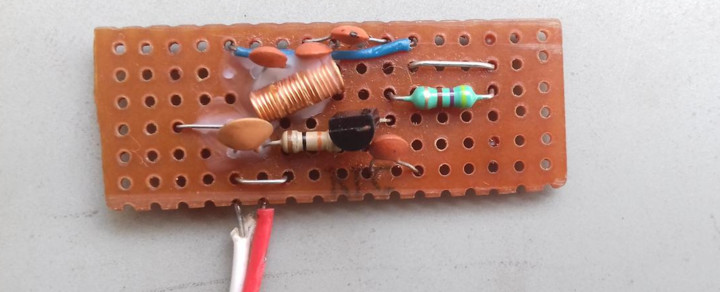 This FM transmitter circuit is a quite fun project for electronics beginners, so here’s a circuit with the 2SC9018 transistor. It uses the 2SC9018 high frequency transistor, based on a different spin of the common base Collpit’s oscillator. The circuit is rather simple, uses only one transistor and few passive components and performs well in terms of frequency stability, almost zero drifting after about 4 hours of continuous operation.
Posted on Monday, August 7, 2017 • Category: FM Transmitters
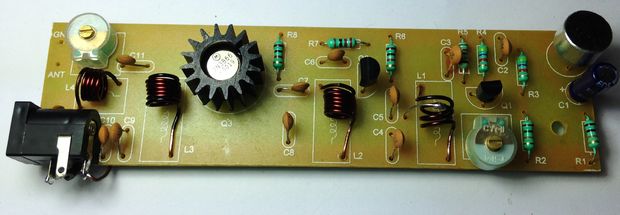 Here we are presenting a long range FM transmitter that can cover a reasonable distance of 5 kilometers / 3 miles and beyond with a one watt RF power with full circuit details, bill of material and testing procedure. With 12 volt DC it will deliver 1 watt RF power. With Yagi antenna, looking like early days of TV antenna with aluminum pipes at both at transmitter and receiver end looking each other at line of sight distance, the range can be up to 5 km / 3 miles.
Posted on Wednesday, June 21, 2017 • Category: FM Transmitters
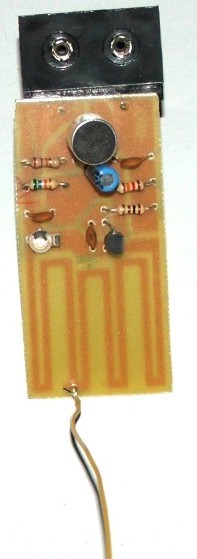 This circuit is basically an oscillator which runs at around 100 MHz. The most important parts of the oscillator are the transistor Q1 and the tuned circuit, which comprises the inductor Ll and the variable capacitor CV1. When the battery is first connected, a brief surge of current flows from the collector to the emitter of Q1, causing an oscillating (i.e: alternating) current to flow back and forth between Ll and CV1. An oscillating voltage therefore appears at the junction of Ll and CV1. The frequency of the oscillation depends on the values of Ll and CV1, so that varying the value of CV1 tunes the oscillations to the exact frequency required.
Posted on Wednesday, June 14, 2017 • Category: Arduino
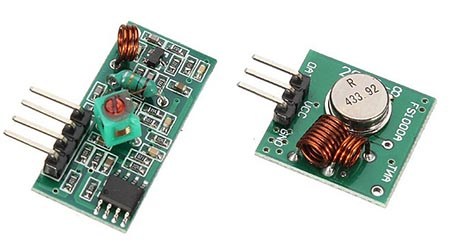 This post aims to be a complete guide for the popular RF 433MHz Transmitter/Receiver modules. I’ll explain how it works, show some features and share an Arduino project example that you can take and apply to your own projects.
Posted on Wednesday, March 22, 2017 • Category: FM Transmitters
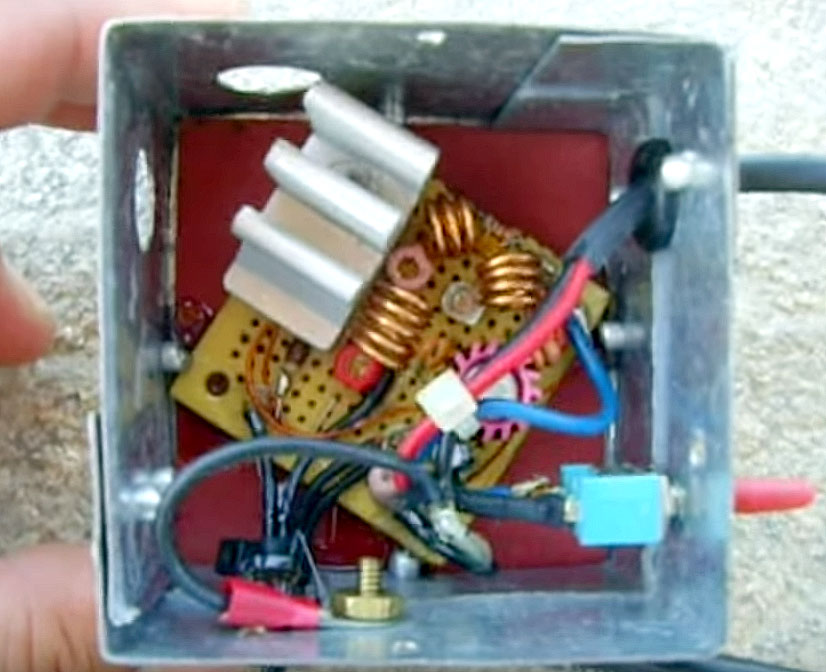 The following is a simple yet powerful 4W FM transmitter which is tunable to 88-108MHz frequency. Connect to your ipod/computer, etc. When this was first made, I only had a 2N2219A on hand, which resulted in a lower RF output. I have since swapped out the transistor for a 2N3866 for full 4W output at around 15VDC supply. In order to achieve a high output level, you will need a well tuned antenna, and a large heatsink to dissipate the heat from T2 transistor.
Transmitter was mounted in metal enclosure and works extremely well.
Posted on Wednesday, November 16, 2016 • Category: Test and Measurement
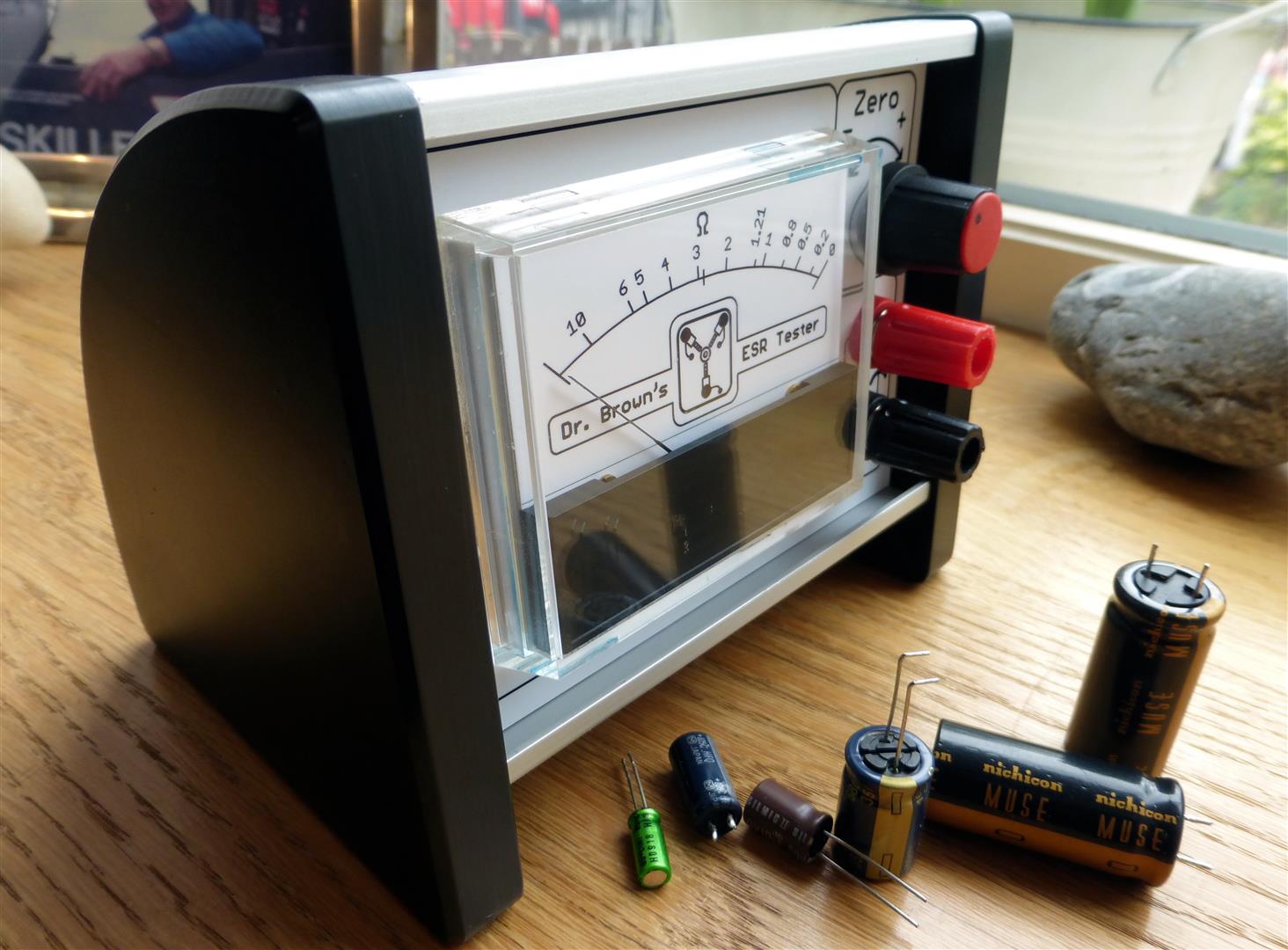 I finally got round to making my capacitor ESR tester this week after finding a nice simple 5 transistor version. Unfortunately, for me, the design was only SMD so, I decided to replicate his schematic in Eagle PCB using a through hole component design. I will not be going into much detail regarding ESR or Equivalent Series Resistance Meters as, there is already plenty of other sources of information on the subject. Yet, every tinkering knows capacitors are guilty of a lot of sins in electronics. Capacitors love to throw red herrings! They can appear physically fine (no bulge), show good capacitance and hide in circuit, standing to attention like the Queens Guards hiding shorts and high resistance under their big hats. This is where the ESR tester can be a saviour, with the ability to test for "out of specification" high resistance, within the capacitor. They can also be used to test "in circuit", without the need to remove every capacitor in the circuit.
Posted on Sunday, October 30, 2016 • Category: FM Transmitters
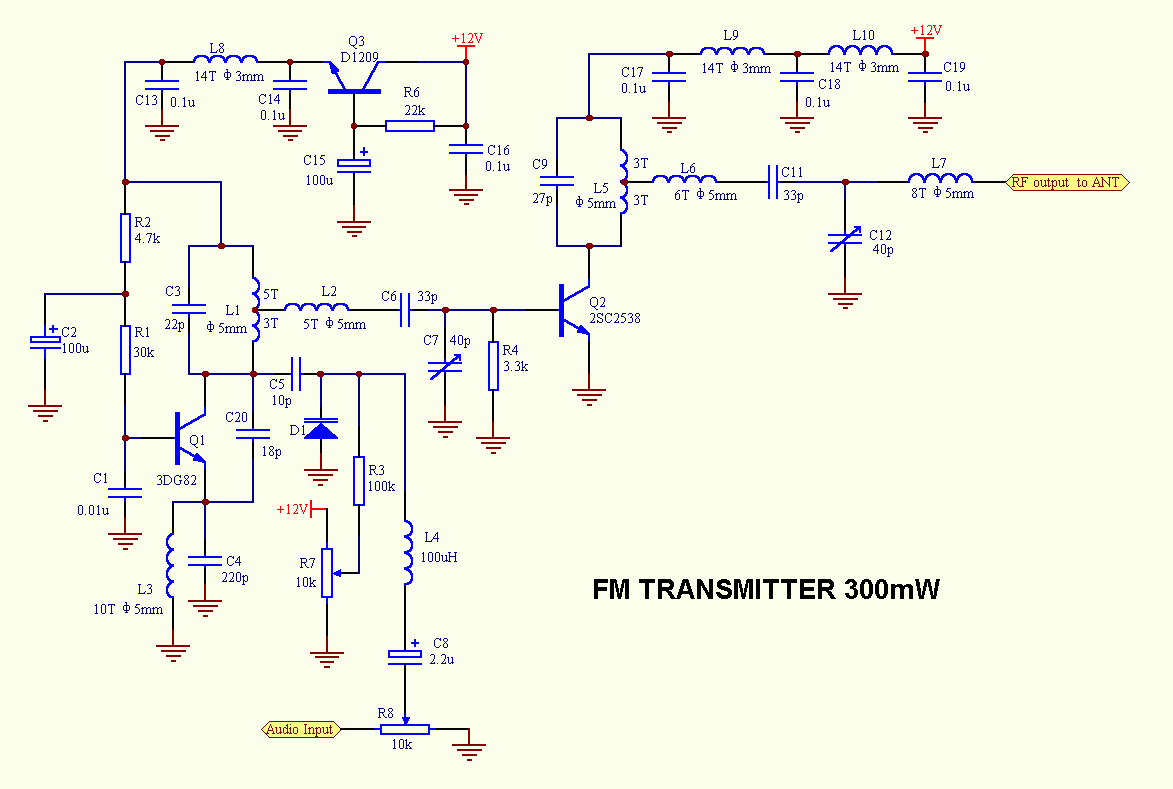 The above FM transmitter has RF output power of 300 mW and covers more than one kilometer distance. Frequency adjustment is accomplished with MV2105 varactor diode and R7 10K potentiometer. 2SC2538 is a class C 300mW amplifier.
Posted on Monday, October 24, 2016 • Category: FM Transmitters
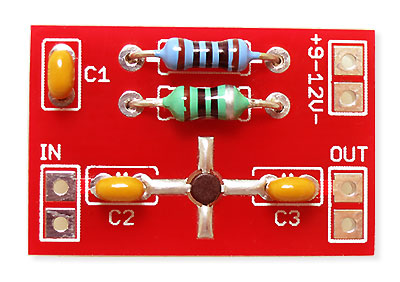 High performance low noise 500mW amplifier / booster for all low power FM transmitters such as BA1404, BH1417, BH1415, 433MHz transmitter modules, etc. The amplifier chip is an integrated circuit containing multiple transistor stages and all other parts conveniently within a single small package. Boosting your FM transmitter has never been easier and the output signal can also directly drive 2n4427 or 2n3866 transistors for 1W or 5W of RF output power.
Posted on Friday, October 21, 2016 • Category: FM Transmitters
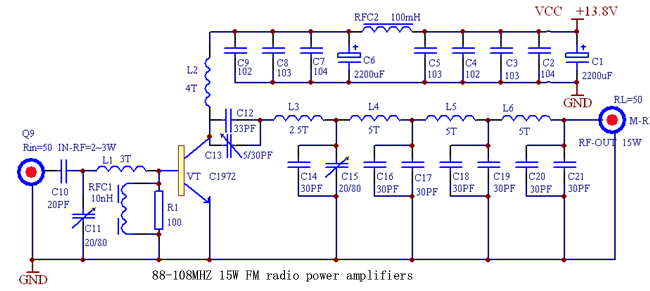 The power amplifier boosts 88-108MHZ 1-2W FM transmitter's power to 15 W. It includes multi-level low pass filter and has a high conversion efficiency with strong Yi-wave suppression. With good antena expected transmission coverage is at least 15Km. It uses high power 175 MHZ 4A 25W 2SC1972 RF transistor that must to be mounted to heatsink for proper heat dissipation.
Posted on Friday, September 30, 2016 • Category: Power Supplies
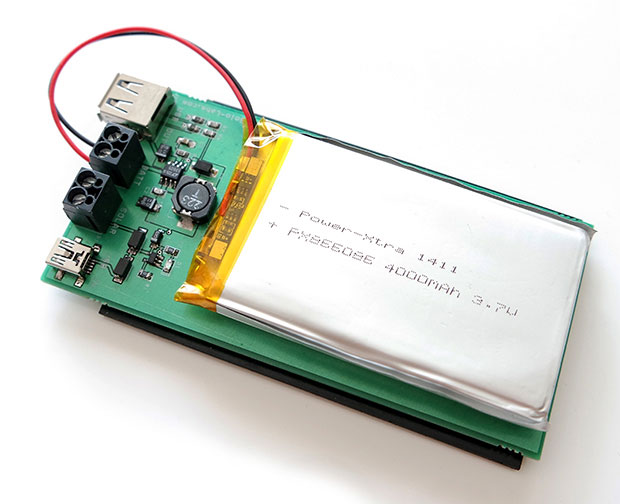 Solar energy is renewable, free, widely available and clean form of energy. It is considered as a serious source of energy for many years because of the vast amounts of energy that is made freely available, if harnessed by modern technology. Many people are familiar with so-called photovoltaic cells, or solar panels, found on things like spacecraft, rooftops, and handheld calculators. The cells are made of semiconductor materials like those found in computer chips. When sunlight hits the cells, it knocks electrons loose from their atoms. As the electrons flow through the cell, they generate electricity.
In this project, we are building a power bank which harvests energy by using a solar panel. The energy gained by the solar panel is stored in a LiPo battery. Then the battery is used to supply a stable 5V which is used by USB gadgets. The power bank can also be charged by an external 5V source. The best thing for this power bank during day that you don’t need to remember to charge it. It charges itself by using the sunlight and you don’t come up with an empty bank.
Posted on Thursday, June 30, 2016 • Category: Frequency Wave Generators
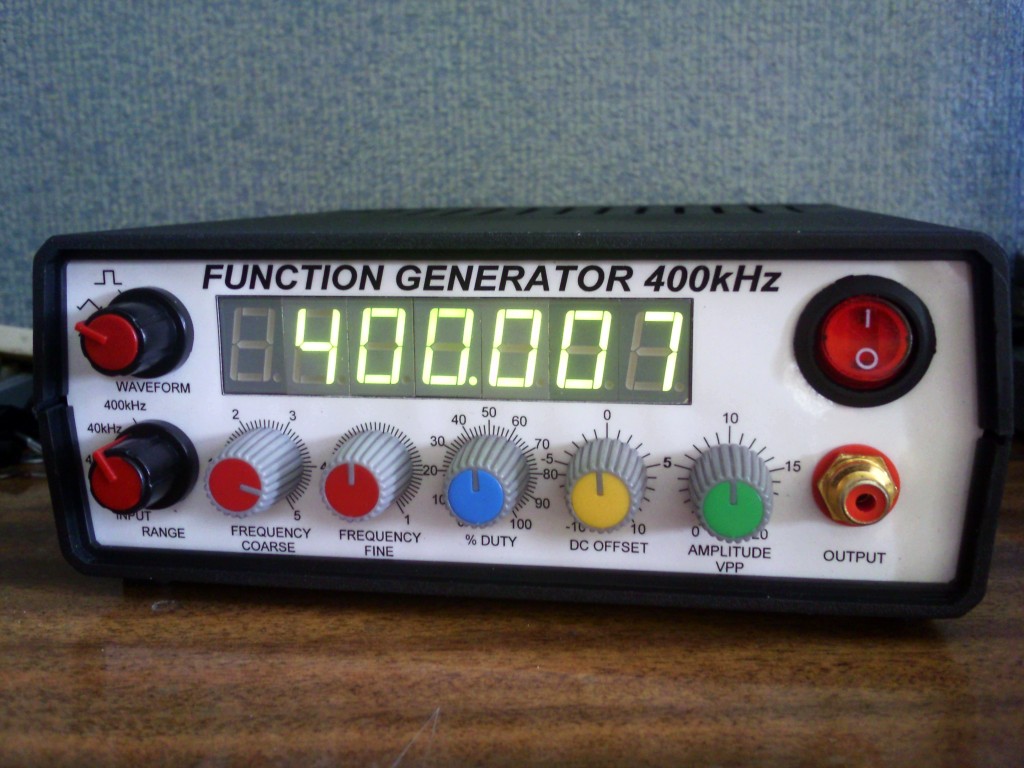 Function generator with adjustable frequency from 0 Hz to over 400 kHz, adjustable amplitude, DC offset, duty, and of course the function selection – square, triangle, and sine. Generator based on good old ICL8038 integrated chip generator that gives pretty good shaped signals as for amateur purposes. This circuit has been designed a little differently than ICL’s note or other similar circuits are suggesting. I tested a bunch of different configurations with different peripherals and chosen the best – so to get good waveshape at 400kHz. I got rid of some of the elements, I added my own solutions. The two ICL chips that i have can oscillate around up to 420-430kHz, and practically we can get good waveforms up to that frequency.
Posted on Friday, June 24, 2016 • Category: FM Transmitters
 The proposed long range transmitter circuit really is very steady, harmonic free design which you can use with standard fm frequencies between 88 and 108 MHz.
This will likely encompass 5km spectrum (long range). It includes an extremely consistent oscillator for the reason that you employ LM7809 stabilizer that is a 9V stabilized power source for T1 transistor and for frequency realignment that may be reached by means of the 10K linear potentiometer. The output strength of this long range rf transmitter is approximately 1W. Transistor T1 is employed as an oscillator stage to present a small power steady frequency. To fine-tune the freq. apply the 10k linear potentiometer this way: should you moderate, in the direction of ground, the freq. would probably decrease but when you fine-tune it in direction of + it would climb. Essentially the potentiometer is needed just as a flexible power source for the a pair of MV2019 varicap diodes. Both of these diodes function as a changeable capacitor whilst you regulate the pot. By tweaking the diode capacitance the L1 + diodes circuit renders a resonance circuit for T1. Feel free to employ transistors similar to BF199, BF214 however be careful not to use BCs. At this point you don’t receive yet the long range fm wireless transmitter due to the fact that the electric power is fairly reduced, a maximum of 0.5 mW.
Posted on Thursday, June 2, 2016 • Category: Power Supplies
 After many years of employing this ugly and clumsy bench power supply, I decided it was time to build something better, smaller and nice looking. It began as a variable power supply based on an LM338 5A voltage regulator and external power adapter. LM338's Data Sheet has several very helpful application notes and circuits. I chose one that illustrated variable output and included protection diodes. Diodes are included to protect the regulator from damage in case the input is accidentally shorted to ground. This is a distinct possibility if using jumpers to attach it to the power supply. Also the output of station supply may be shorted if some other device fails. Without the diodes, if this happens, the capacitors will dump their charge back through the regulator. Since the current spike may be many amps, the regulator may fail. The diodes steer the current around the regulator and into ground, thereby protecting it from damage. With adequate input the LM338 makes a fabulous variable power supply. This small supply is user friendly and fits nicely on my cluttered bench.
Posted on Friday, May 20, 2016 • Category: FM Transmitters
 Pen FM Transmitter bug projects have been very popular. The idea of being able to hide a transmitter in a pen is very appealing. In an effort to reduce the size of this design, we have used surface-mount components. Firstly, the thought of using the coil in the tank circuit for transmitting RF was a little far fetched, but we used it as an example for those who were interested in experimenting with our circuits. Now we have gone back to a conventional antenna, the whip. The whip or straight-line antenna can be coiled, wound longitudinally or folded. The way it is wound makes a big difference to its effectiveness, but when you are limited in space, you have to accept these limitations.
Even though we have used this antenna set up in our previous pen bugs we have considerably improved the circuit to the point were it has low battery consumption, but high RF output. The size of this design has been reduced considerably by using surface-mount components.
Posted on Monday, May 16, 2016 • Category: FM Transmitters
 Three stage FM transmitter with an on board signal booster for increased transmitting range. It broadcasts audio on 76MHz - 110MHz FM frequency via included on board microphone or from MP3 player, Phone, iPod, Computer, Laptop, CD Player, TV, Satellite Receiver via on board 3.5mm connector. It transmit sound with excellent clarity throughout your home, office, yard, camp ground, etc. Transmitter is supplied by 3-12V DC voltage and uses one 2SC9014 and two 2SC9018 low noise RF transistors.
Posted on Saturday, April 16, 2016 • Category: FM Transmitters
 I found this FM transmitter circuit on the internet, it works very well and it is very simple to build, even for amateurs. I managed to squeeze all the parts on small 1.5 x 2 cm PCB. When using small wire antenna and 3V power the range is 50m. The coil has 10 turns on a 3 mm diameter and is wound with 0.3 mm copper wire. The microphone is an electret type. Transmitting frequency is changed by stretching or compressing the coil. Furthermore, we can change the frequency by changing C2 capacitor (10pF capacitor with a frequency of about 88MHz, with 8.2pF 95Mhz and 6.8pF 104Mhz). Further tuning to the correct frequency is done through the coil. Transmitter can be powered by 3V button battery.
Posted on Sunday, April 3, 2016 • Category: FM Transmitters
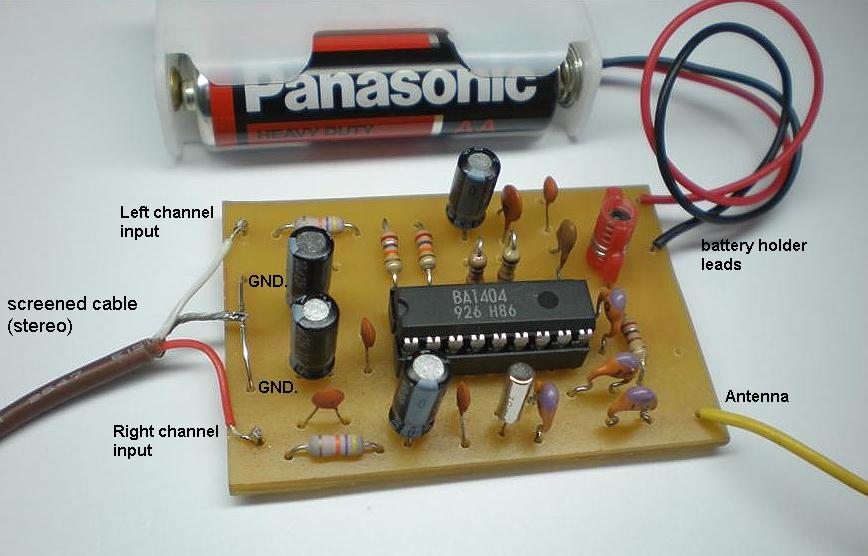 This easy to build transmitter transmits high quality stereo sound from your MP3 player, computer, walkman or discman to any FM radio or car radio. The circuit is designed around the BA1404 single chip FM stereo transmitter from ROHM. The IC requires only a small number of external parts so it is well suited for hobbyist projects. The chip features excellent frequency stability, low power consumption & good channel separation. The transmitting RF frequency can be set by adjusting the coil (Lx). This 2 turn coils is paired with a 39 pF capacitor (Cx) to give a frequency range from 87 MHz - 106 MHz.
Posted on Sunday, March 20, 2016 • Category: FM Transmitters
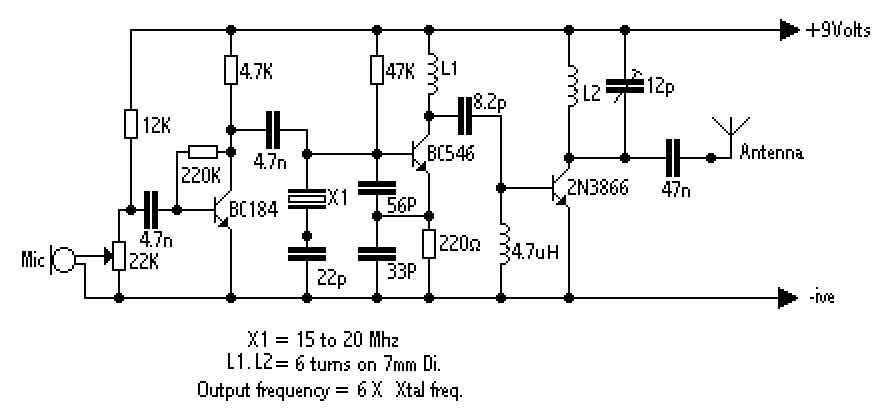 This FM VHF transmitter will output approximately 250mW of RF power using a 2N3866 output transistor and can operate between 75MHz and 146MHz. It utilities a variable high gain audio pre-amplifier which can detect voices 40 feet away using an electret microphone. Using a NBFM scanner, ranges over 5KM have been achieved using a 48cm wire antenna. Coils are 22SWG 7mm air core. L1 and L2 should be 6 turns for 75MHz to 85MHz, 4 turns for 85MHz to 100MHz and 3 turns for 100 to 146MHz. For frequencies over 100MHz the Crystal will be higher than 20MHz hence the base emitter capacitor should be 47pF. L3 is a 4.7uH choke. It is ideal to tune up this circuit using a wave detector meter placed a few inches away from the transmitter.
Posted on Tuesday, February 23, 2016 • Category: FM Transmitters
 Have you ever wanted to broadcast your own radio station within your neighborhood? This small and simple 87-108MHz FM transmitter is the toy that geeks have always wanted. This tutorial includes the PCB layout and the schematics. It has a range of up to 1/4 mile or more. It's great for room monitoring, baby listening and nature research.
Posted on Tuesday, February 16, 2016 • Category: Power Supplies
 This is a high quality bench power supply with adjustable output voltage from 0 to 30V and adjustable output current from few miliamperes to 4 amperes. Built-in electronic output current limiter that effectively controls the output current makes this power supply indispensable in the experimenters laboratory as it is possible to limit the current to the typical maximum that a circuit under test may require, and power it up then, without any fear that it may be damaged if something goes wrong. There is also a visual indication that the current limiter is in operation so that you can see at a glance that your circuit is exceeding or not its preset limits.
Posted on Wednesday, February 3, 2016 • Category: FM Transmitters
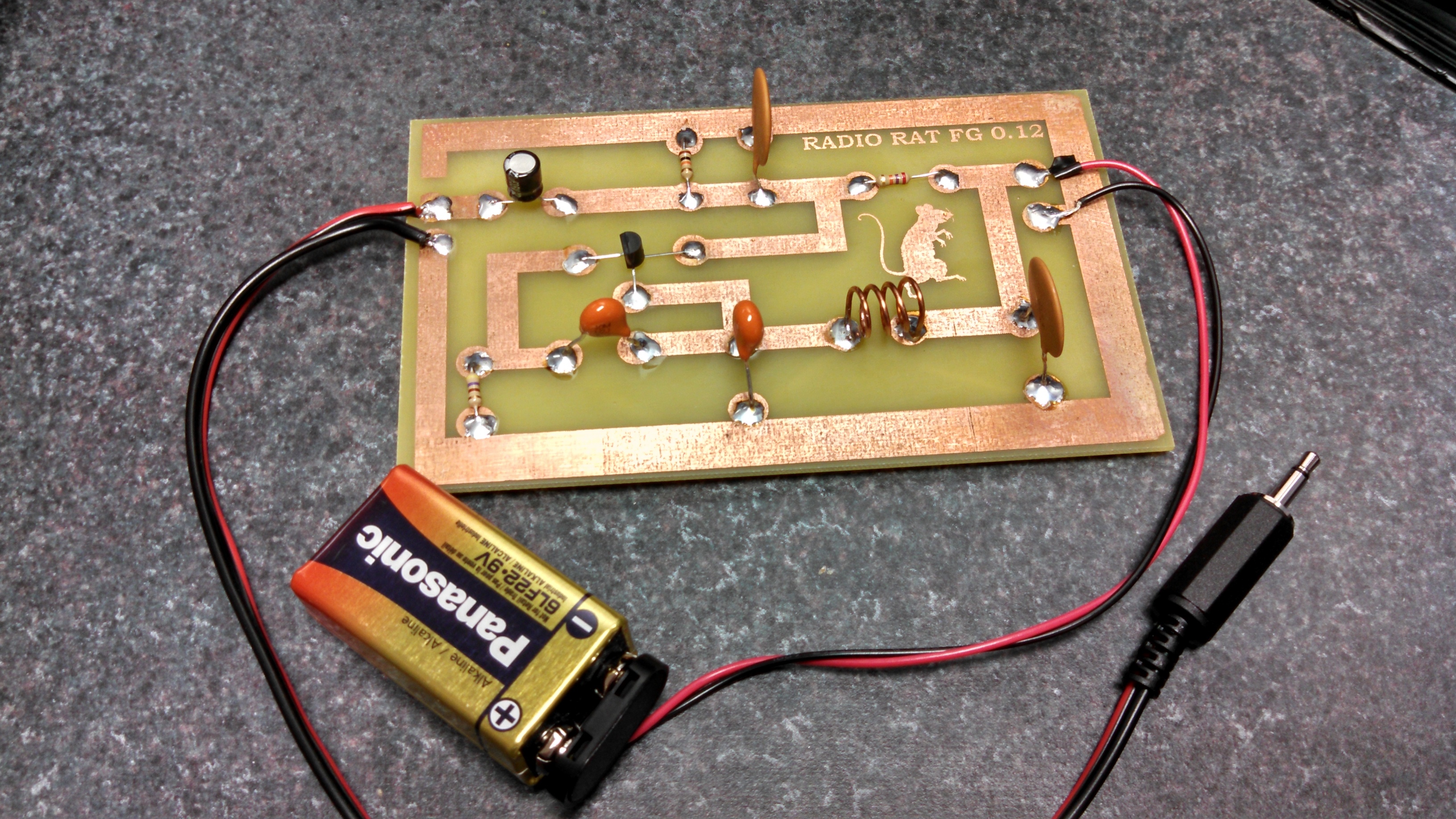 FM transmitters can be complicated to build, but not this one — this iPod FM transmitter about the easiest you can possibly make. And though the science of radio is well understood, there’s a magical, emotional quality about it that we don’t often stop to appreciate. You will not forget the first time you pick up a transmission broadcast from a device you soldered together, yourself, from a few bits of copper, carbon, plastic, and wire.
Posted on Monday, January 18, 2016 • Category: FM Transmitters
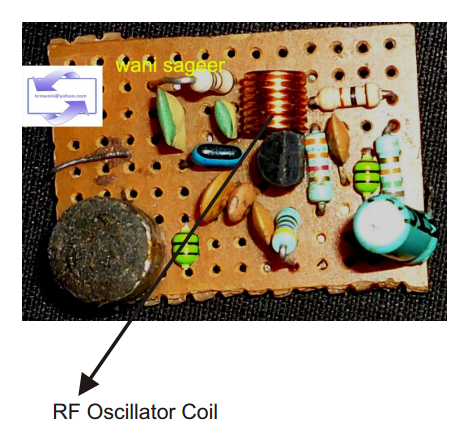 The circuit is a simple 88-108 MHz VHF FM transmitter circuit. It is basically a VHF Colpitts oscillator capable of transmitting sound or music to any standard FM receiver. The circuit is powered by 9V battery which makes it easily portable. It also has a capacitor microphone which picks up very weak sound signals. The output frequency can be easily adjusted by potentiometer thanks to onboard MV2109 varicap diode and the frequency stability is quite good. The range of this transmitter is 100 meters.
Posted on Friday, December 18, 2015 • Category: FM Transmitters
 This simple circuit is based on BA1404 FM Transmitter, works with two AA batteries and can drive a 300W dipole antenna for improved range. There are many applications for an FM transmitter, particularly if it can broadcast in stereo. You can broadcast stereo signals from your CD player or any other source to an FM tuner or radio. The transmitter uses a single IC and a few other components. It broadcasts on the FM band (88-108MHz) so that it can be received by any standard FM tuner or portable radio.
Posted on Thursday, December 3, 2015 • Category: FM Transmitters
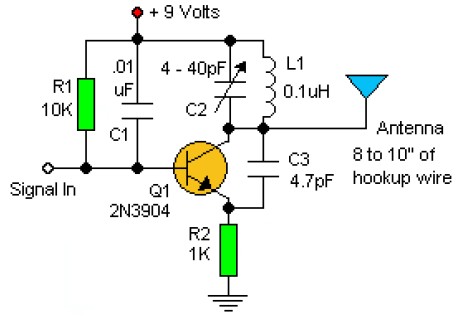 This basic RF oscillator circuit is easy to build and the components are not critical. Most of them can be found in your junk parts box. The circuit operated with 9V DC power supply. The L1 antenna coil can be made by close winding 8 to 10 turns of 22 gauge insulted magnetic wire around 1/4 inch form such as a pencil. You can experiment with the size of the coil and the number of turns to see how it affects the frequency and signal output of the oscillator. You should be able to pick up its signal with standard FM radio receiver. Signal In to any audio player through 0.1uF capacitor.
Posted on Thursday, November 26, 2015 • Category: FM Transmitters
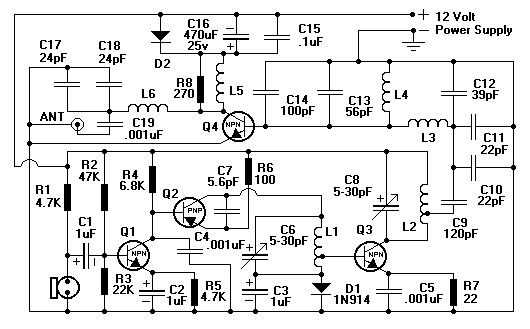 This 7 Watt FM Transmitter was originally a 200mW unit, without the universal power stage added. Together with the power amp 2SC1971 / MRF237 / NTE342 it then became a 7W unit. I used this transmitter with a half-wave open-end dipole in a vertical position 50 feet above ground. Together with about 70 feet of coax, this transmitter delivered great audio at a distance of 10 miles ... overall distance was 17 miles, but the audio signal was weak. I had no equipment, other than a watt meter to measure it's power and a digital FM tuner with a 5-LED Signal Strength Bargraph display to use as capturing the main oscillating frequency, which was right at 87.5 MHz. This circuit worked well for me, as I had experimented with it for nearly a year. Of course, one would be better off with more equipment than I have had to capture the main oscillating frequency. That was, by far, one of the hardest things to capture. It was thru trial and error, with the FM tuner, in finally finding out how to grab the right frequency. When I finally did get used to find out where my 'main' frequency was, the unit performed extremely well. Like I had said above, right at 10 miles, the unit was at its best giving clear audible audio into the speakers of my car. With the transmitting antenna at 50 feet above ground, I decided to see how well I could receive the transmitter signal from an overpass than is exactly 15 miles from the transmitter. When I got to the top of the overpass in my car, the audio signal came in as 'clear as a bell'. I now understand what is meant when one says FM signal travels best in a line of sight. Well, being on that overpass, if I had a strong telescope with me, I am sure I could see the 50 foot antenna in my oak tree. So with the overpass being right around 50 feet in height also, the transmitter surpassed my judgement call on its signal. I surrender this circuit to anyone who likes to experiment in things like this. Enjoy!
Posted on Friday, October 9, 2015 • Category: FM Radio / Receivers
 This is one of my favorite radio builds just because of how simple it is and how well it is able to pick up a lot of FM radio stations. I have browsed the world in search of a one transistor FM receiver. I have seen a couple but they were always attached to some sort of added device, such as another IC or another transistor for amplification in the receiver itself. Through my continued quest of searching for that too good to be true one transistor, I happened to run across a super-regenerative receiver, by Charles Kitchin, famous for his vast knowledge of regenerative designs. I printed out the schematic and made it. It turned out extremely well.
Posted on Friday, September 25, 2015 • Category: FM Transmitters
 This is the most simple and cheap FM transmitter you can ever find. This circuit is really cool. This runs at very low voltage, by a CR2025 3V battery, current consumption is also low.And the total size of this FM transmitter (including battery, excluding antenna) is less than that of a matchbox. The circuit has a central RF oscillator NPN transistor BF494 (substitute: BF199). A coil takes care of the output frequency. It consists of 36SWG wire 2.5 turns only in 5mm diameter ferrite rod. Keep the circuit as small as possible. Try to use no wires in the main functional area (transistor and coil). The input from the audio output of computer / PMP / mobile is given to the biased base of the transistor. The transistor gives a RF humming accordingly to the audio input, and the FM wave is spread by the external antenna. By using a standard TV antenna, the range of this transmitter can go up to 1KM radius, using small (15-20cm) Ariel, it can work up to around 50M range. This circuit is most suitable for miniature FM transmitter for use in computer, mobile etc to send music to home theater system without wires, and in homemade wireless walky-talkies.
Posted on Tuesday, August 25, 2015 • Category: FM Radio / Receivers
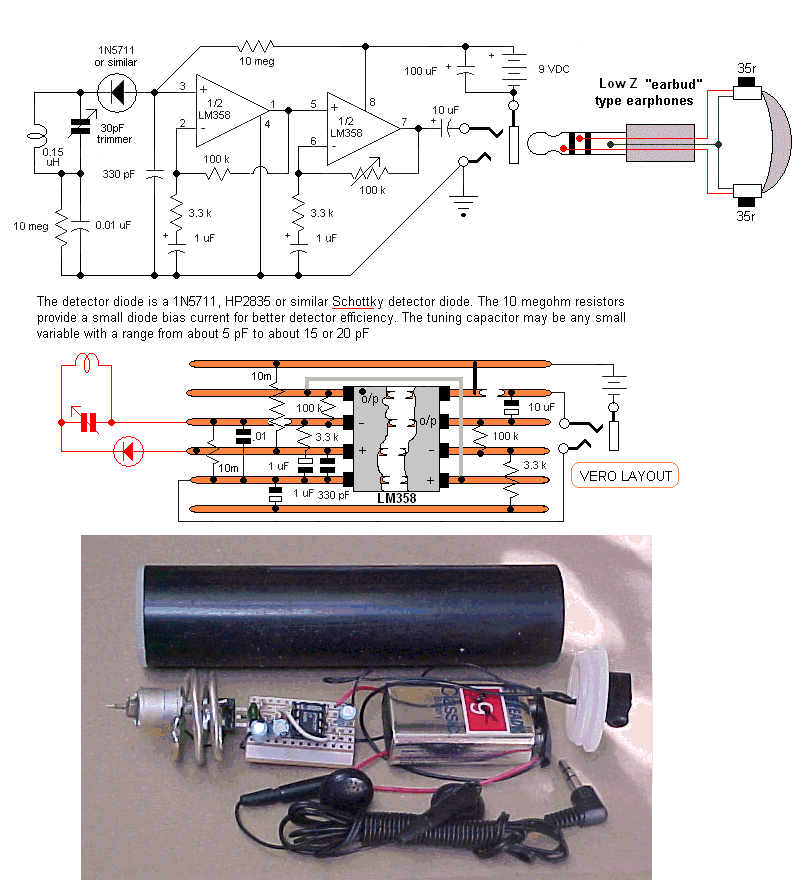 This passive airband receiver is basically an amplified "crystal radio" designed to receive nearby aircraft transmissions on 121 - 133 MHz frequency. Useful for listening to the pilot transmissions. The input tuned cct 'L' is a 2 turn loop, with 30mm diameter measured at 0.15uH on my LC Meter which intercepts RF directly as opposed to an LC cct fed with external aerial. Tuning capacitor is a 30pF Philips Beehive trimmer, with a short length of plastic tube glued - as a tuning shaft. Capacitance runs from 28 to 7pF; which by formula gives a frequency range of 77 - 155MHz. Detector uses a biased 1N5711 (or similar) schottky diode with lowest forward-biassed voltage drop. The two 10M resistors bias the detector diode and the op-amp input near mid-rail for better detector efficiency. LM358 dual op-amp draws less than 1 ma so the battery drain is minimal. Insertion of earphones plug completes supply circuit and acts as an on/off switch. 9V battery fits neatly inside a 30mm x 130mm long PVC tube.
Posted on Friday, August 21, 2015 • Category: AM Radio
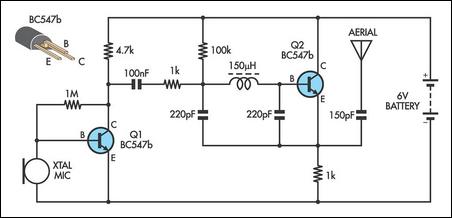 There are not many AM transmitters that are easier to build than this one because the inductor is not tapped and has a single winding. There is no need to wind the inductor as it is a readily available RF choke. To make the circuit as small as possible, the conventional tuning capacitor has been dispensed with and fixed 220pF capacitors used instead. To tune it to a particular frequency, reduce one or both of the 220pF capacitors to raise the frequency or add capacitance in parallel to lower the frequency. Q1 is biased with a 1MO resistor to give a high input impedance and this allows the use of a crystal ear piece as a low cost microphone.
Posted on Sunday, August 16, 2015 • Category: Amplifiers
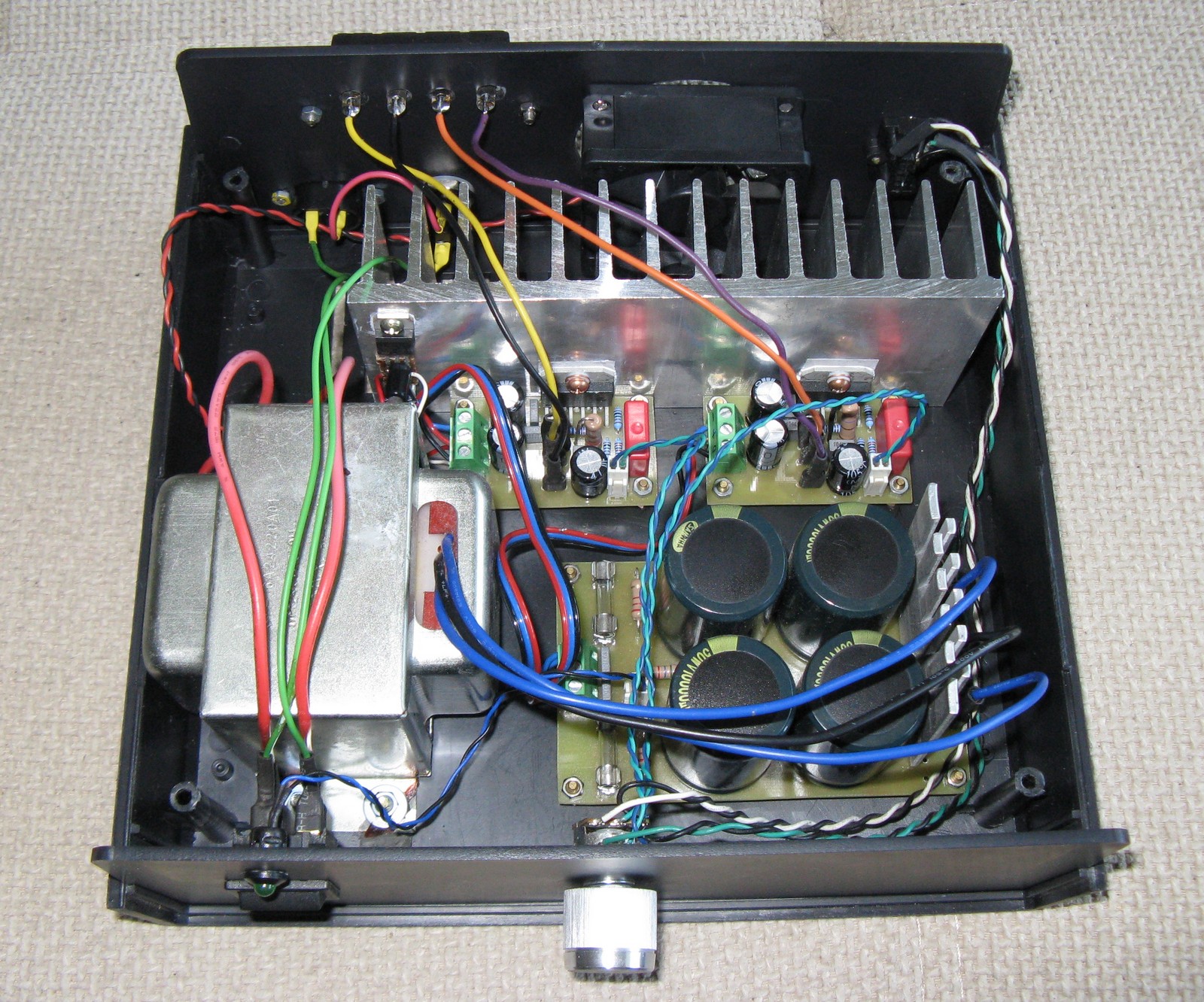 This is a second revision of 50W LM3886 power amplifier that is used to power two bookshelf speakers. The sound produced by LM3886 chip is excellent so I decided to make another amplifier with it. The schematic is based on the schematic in the datasheet of the chip with minor changes. I removed the time delay capacitor connected to MUTE pin, because it's better to use separate DC protection schematic which has similar functionality. I made the output inductance L1 by winding 15 turns of enameled wire around the resistor R7. The diameter of the wire must be minimum 0.4mm. The whole was wrapped with heat shrink.
Posted on Thursday, July 2, 2015 • Category: FM Transmitters
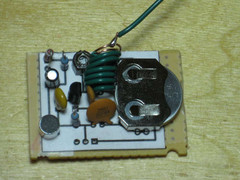 This is the most simple and cheap FM transmitter you can ever find. It's powered by CR2025 3V battery and current consumption is very low. The total size of this FM transmitter is less than that of a matchbox. The circuit has a central RF oscillator NPN transistor BF494. A coil takes care of the output frequency. The coil consists of 36SWG wire 2.5 turns in 5mm diameter ferrite rod. Keep the circuit as small as possible. By using a standard TV antenna, the range of this transmitter can go up to 1KM radius, using small 15-20cm wire, it can work up to around 50M range. This circuit is most suitable for miniature FM transmitter for use in computer, mobile etc to send music to home theater system without wires, and in homemade wireless walky-talkies.
Posted on Sunday, June 28, 2015 • Category: Frequency Wave Generators
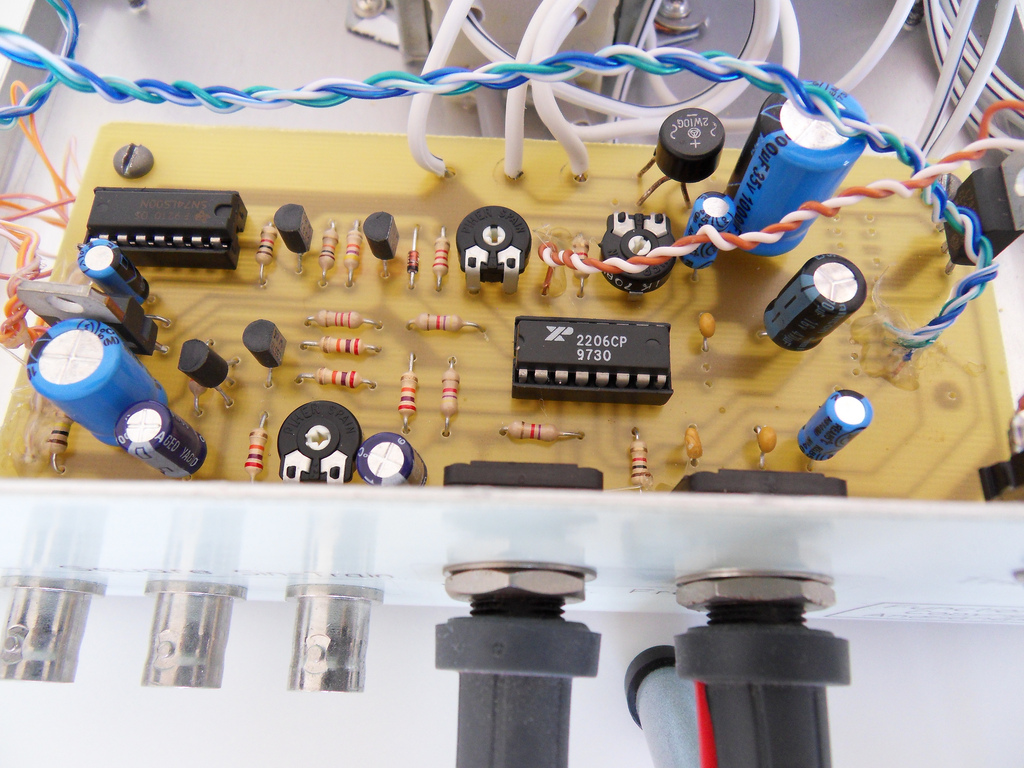 When i was using operational amplifiers at school lab i wanted a function generator at home to play with and work on circuits with Op Amps for better understanding. So i found on the internet a free function generator circuit which uses the IC XR-2206, i printed the PCB with my UV exposure box, i bought an enclosure box, i put everything inside and here is the result. The function generator can generate Square, TTL, Sine and Triangle waveforms from 1Hz to 1Mhz with Voltage regulation to Square Sine and Triangle waveforms.
Posted on Thursday, May 28, 2015 • Category: FM Transmitters
 This simple transmitter allows you to broadcast on FM radio band 87.5 - 108 MHz. It consists of a simple oscillator with silicon planar RF PNP transistor. Directly to the oscillator an antenna is connected. Due to the large amplitude of RF voltage is sufficient antenna length of about 5-10 cm. I used insulated 7cm long copper wire 1mm diameter. I eliminated the tuning capacitor, which is usual for most bugs and miniature transmitters, because this greatly complicates the tuning. From my own experience I know that if you get closer to such capacitor, the operating frequency is changed. That's why I chose to use the voltage tuning using the Voltage Controlled Oscillator (VCO). Instead of tuning capacitor the varicap (capacitance diode) is used, which changes its capacity by changing the reverse DC voltage. We can tune the operating frequency by changing the DC voltage using the trimmer P1. Varicap also provides frequency modulation.
Posted on Sunday, May 24, 2015 • Category: FM Transmitters
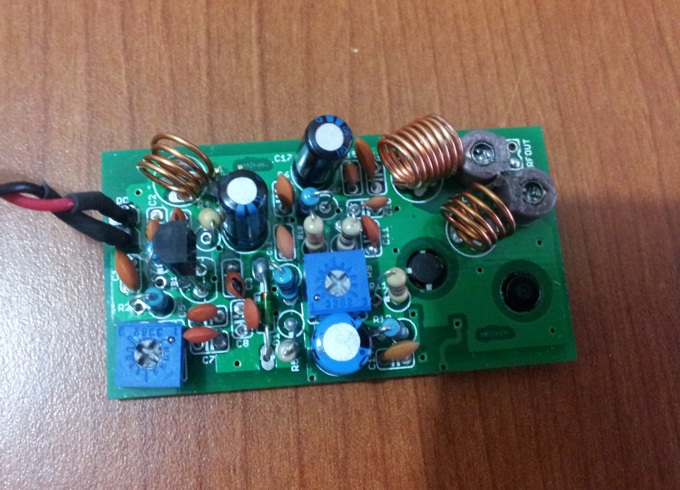 This simple 400mW transmitter broadcasts audio on 87.5 - 108 MHz FM radio band. With good dipole antenna transmission range up to 4km is possible. Frequency is selected by adjusting R1 potentiometer. Transmitter should be powered by regulated 12-14V power supply with at least 100mA current rating.
Posted on Thursday, April 23, 2015 • Category: FM Transmitters
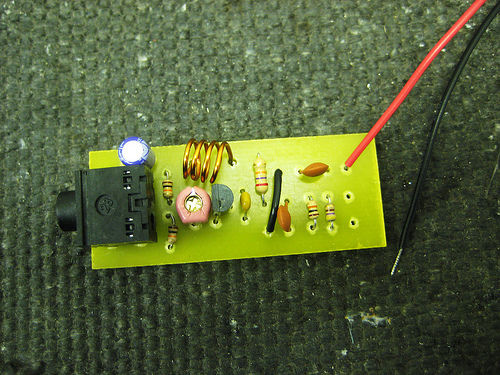 FM transmitters can be complicated to build, but not this one it’s about the easiest you can possibly make. And though the science of radio is well understood, there’s a magical, emotional quality about it that we don’t often stop to appreciate. You will not forget the first time you pick up a transmission broadcast from a device you soldered together, yourself, from a few bits of copper, carbon, plastic, and wire.
Posted on Thursday, March 12, 2015 • Category: FM Transmitters
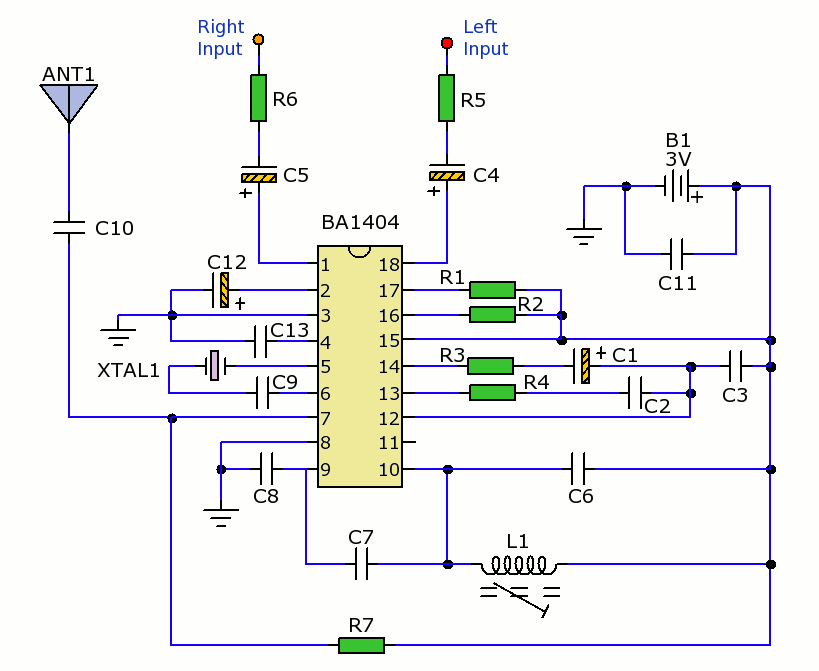 This is a small stereo FM transmitter. Output can be tuned from 88 to 108Mhz and the transmitter can be battery powered or be used with presented low voltage power supply. This circuit is based on the Rhom BA1404 datasheet. The maximum voltage should not exceed 3V. The IC can be driven from a 7805 Regulator with a couple of 1N4001 diodes to reduce the supply voltage to about 2.8 Volts. RF output power is typically 500mW but range depends upon antenna coupling and efficiency, environment and size of antenna. A small telescopic whip has an expected range of at leaset 100 metres or more.
Posted on Monday, March 2, 2015 • Category: Arduino
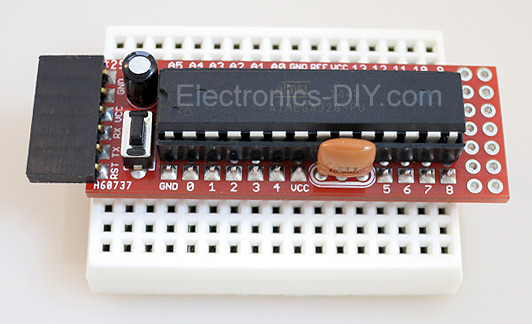 Arduino Prototype is a spectacular development board fully compatible with Arduino Pro. It's breadboard compatible so it can be plugged into a breadboard for quick prototyping, and it has VCC & GND power pins available on both sides of PCB. It's small, power efficient, yet customizable through onboard 2 x 7 perfboard that can be used for connecting various sensors and connectors. Arduino Prototype uses all standard through-hole components for easy construction, two of which are hidden underneath IC socket. Board features 28-PIN DIP IC socket, user replaceable ATmega328 microcontroller flashed with Arduino bootloader, 16MHz crystal resonator and a reset switch. It has 14 digital input/output pins (0-13) of which 6 can be used as PWM outputs and 6 analog inputs (A0-A5). Arduino sketches are uploaded through any USB-Serial adapter connected to 6-PIN ICSP female header. Board is supplied by 2-5V voltage and may be powered by a battery such as Lithium Ion cell, two AA cells, external power supply or USB power adapter.
Posted on Tuesday, December 30, 2014 • Category: FM Transmitters
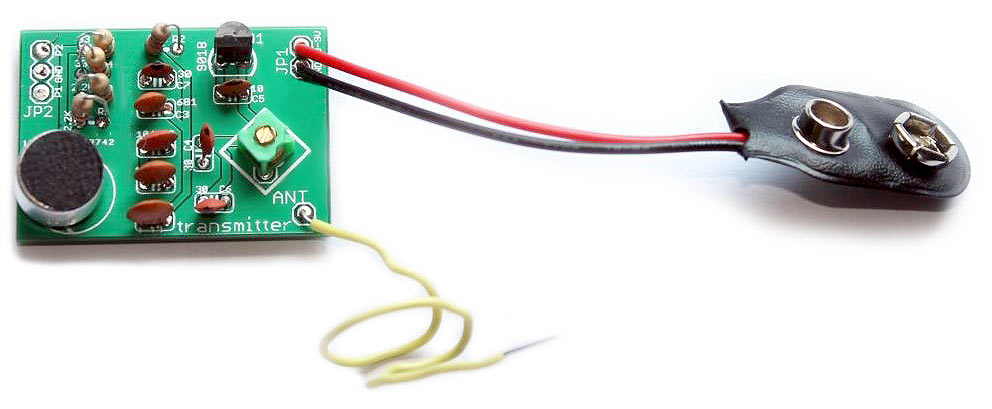 Here is a simple 76-110MHz FM transmitter that can transmit your voice or audio over an ordinary FM radio within the FM broadcast band. It can transmit both voice using microphone and music from any music player. Frequency is changed by adjusting 5.5 turn inductor coil. Transmitter is powered by 9V battery or 3V-9V power adapter. Transmission range is 100 meters but can be increased with better antenna or RF amplifier.
Posted on Wednesday, December 10, 2014 • Category: FM Transmitters
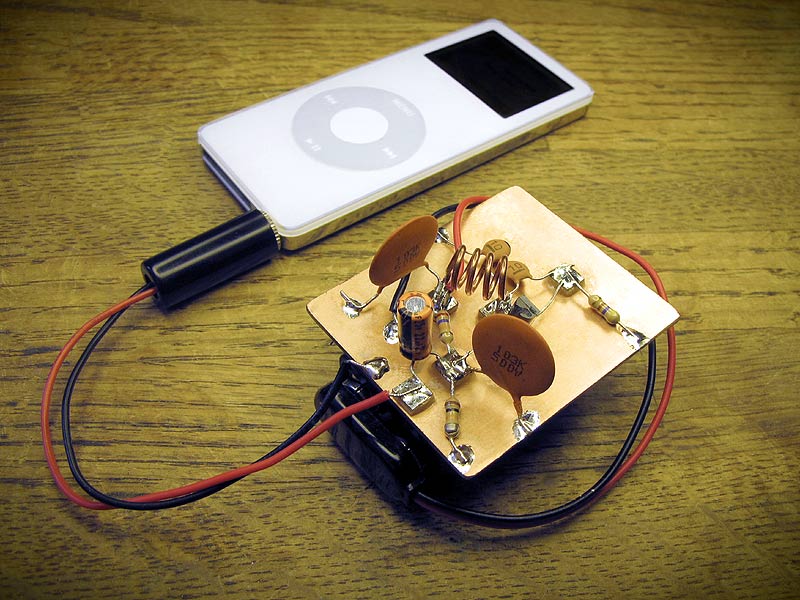 FM transmitters can be complicated to build, but not this one. It’s about the easiest you can possibly make. And though the science of radio is well understood, there’s a magical, emotional quality about it that we don’t often stop to appreciate. You will not forget the first time you pick up a transmission broadcast from a device you soldered together, yourself, from a few bits of copper, carbon, plastic, and wire.
Posted on Saturday, October 25, 2014 • Category: Stepper Motors
 H-bridge is frequently used to control DC motors and stepper motors. When controlling a bipolar stepper motor, two full H-bridges are needed. There are many H-bridge ICs (like L298, MPC17529 and SN754410 which is a quad half H-bridge) for just that purpose. But if you are on a budget, you may want to consider building a dual H-bridge yourself. The following schematic shows a simple dual H-bridge using eight general purpose transistors (2N3904 and 2N3906). Given the maximum current of roughly 200mA, this circuit can be used to drive a small bipolar stepper motor operating between 5V and 12V, such as the stepper motors found in most floppy drives and CD / DVD drives.
Posted on Tuesday, August 26, 2014 • Category: FM Transmitters
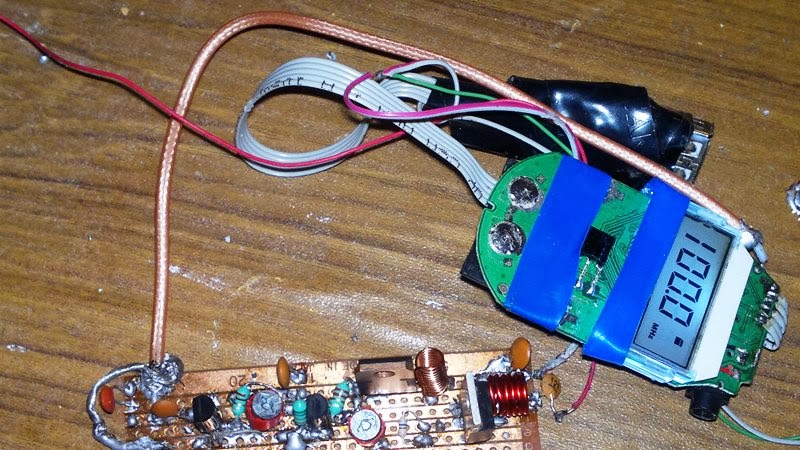 Presented FM transmitter is built around low power PLL transmitter and amplifier that boosts its signal all the way up to 6 Watts. The signal is amplified by three RF stages of amplification. In the first and second stages of the transmitter one of the best driver transistors were used 2SC2053. You can use the other transistors but only up to 500mW of power. In the third stage 2SC1971 RF transistor was used to achieve 6W of power. For making any RF transmitter circuit at least two meters are necessary, one is frequency counter and the other is RF field strength meter for which the schematic is provided.
Posted on Friday, August 22, 2014 • Category: Amplifiers
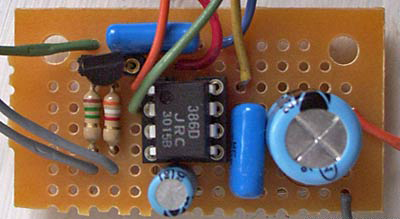 This is battery powered amplifier based on LM386 chip and has an input buffer that is feeding the inverting input. The input buffer helps to retain treble details going into the LM386 chip. It is powered from a single 9V battery.
Posted on Sunday, August 17, 2014 • Category: Miscellaneous
 This is a low voltage 12V fluorescent inverter for powering two 20W or single 40W fluorescent tube. It's a circuit you can put together from junk box components and is a very simple to build. The transformer is hand-wound on a ferrite rod from an old transistor radio and the winding wire can be salvaged from an old transformer. The cost of powering the circuit is about 22 watts and this will produce the same light output as 60 watt incandescent light bulb.
Posted on Sunday, August 3, 2014 • Category: FM Transmitters
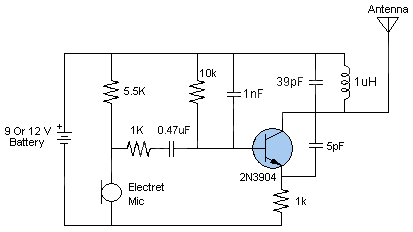 The figure shows a schematic of an easy to build FM transmitter circuit. Mostly all FM transmitter circuits you will find online or in books require some kind of hand build inductor/coil and after building the transmitter you have to adjust that coil and trimmer capacitor a little to adjust the transmitter to transmit on your desired frequency.
If you are looking for an easy or simple FM transmitter circuit in which you don't have to make a coil with your hand then the circuit given here is ideal for you. The circuit is using a ready made 1uH inductor which can be purchased from an electronic components store. These inductors are mostly look like resistors. The circuit also does not require a trimmer capacitor, because we have used a fixed value of 39pF capacitor in the place of trimmer capacitor. We have already calculated and used the values of coil and capacitors of oscillator to broadcast on FM band, so you don't have to do any further adjustments and tuning after building the circuit. The circuit can be operated with 9 to 12 volt DC. For antenna use a 12 inch wire or for maximum range use a 30 inch wire and make it vertical.
Posted on Monday, July 28, 2014 • Category: Test and Measurement
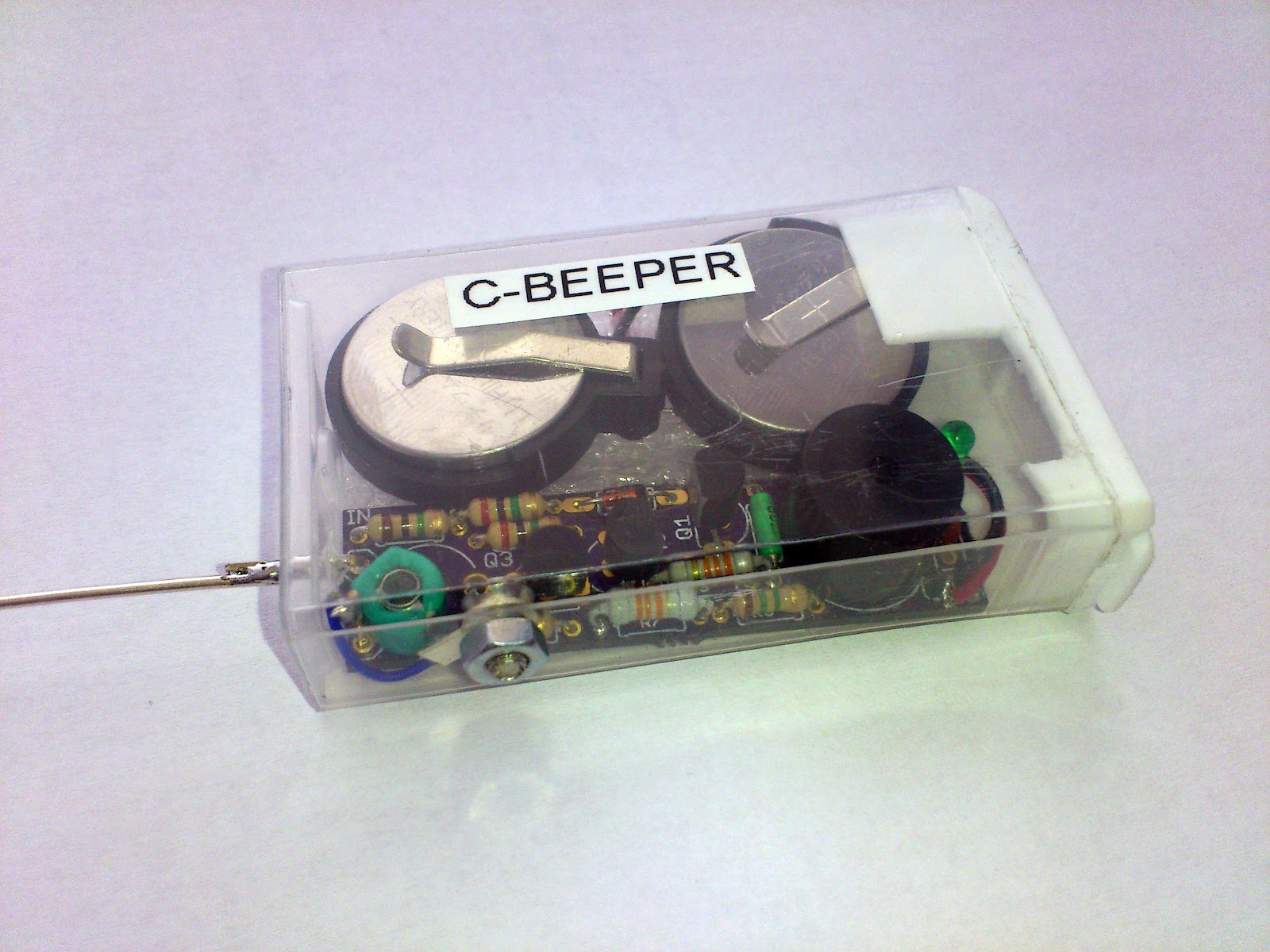 Curious C-Beeper is a fun to build little probe that can be used to quickly detect the capacity of capacitors in pF nF range, test their stability with temperature changes, find broken wires, locate wires, trace wires on PCBs, and to locate live wires behind the walls without touching them. The circuit uses three transistors to make a most unusual capacitance beeper probe. When a capacitor is touched to the probe, the probe beeps at a frequency that varies with capacitance. The frequency change is so steep with capacitance that tiny capacitors may be precisely matched or an exact fixed value may be selected to replace a trimmer in a prototype. If the user has reasonably moist skin, simply holding one lead of the capacitor to be tested while touching the other lead to the probe is all that is necessary. The user's body forms the other connection through the beeper's metal case. When the beeper is properly adjusted it draws only 10 uA with nothing touching the probe - no power switch is required. This design is optimized for capacitors less than about 0.1 uF (100 nF). Large capacitors give a low frequency "clicking" sound and small capacitors sound a tone that increases as the capacitance decreases. Many decades of frequency change occur over the beeper's range giving even the more tone-deaf among us sufficient change to discern slight differences in capacitance. The entire device is powered by two CR2032 lithium cells that fit into TicTac box. The use of power switch is unnecessary since the circuit consumes almost no power when not being used.
Posted on Thursday, July 24, 2014 • Category: Miscellaneous
 This circuit automatically turns on the light through a relay when daylight intensity falls below a preset level on the Light Dependent Resistor (LDR).
Posted on Tuesday, July 1, 2014 • Category: Amplifiers
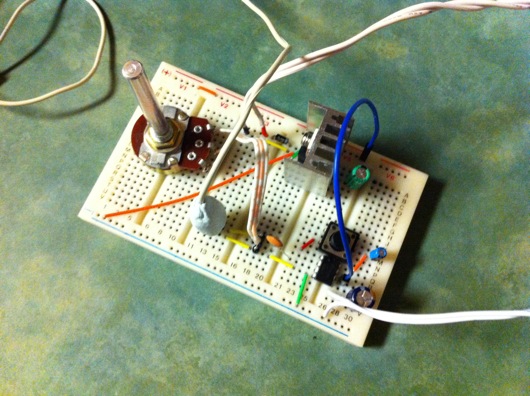 It's always handy to have a little amp kicking around to trace audio signals, test mics, CD tape and TV audio outputs. You know, something that doesn't weigh a lot and isn't clumsy. There are tons of uses for this little circuit.
There are a couple of versions of this amplifier chip. Both are 8 pin DIP packages and the difference between the two are apparent by their part numbers. Either are suited for this circuit provided the supply voltage does not exceed the recommended 5 to 12 volt DC range. Power output can range from about 325 mW to about 750 mW within this supply range when using an 8 ohm speaker. Power it with batteries or a small DC supply...why not solar cells or a little windmill generator?
Posted on Friday, June 27, 2014 • Category: FM Transmitters
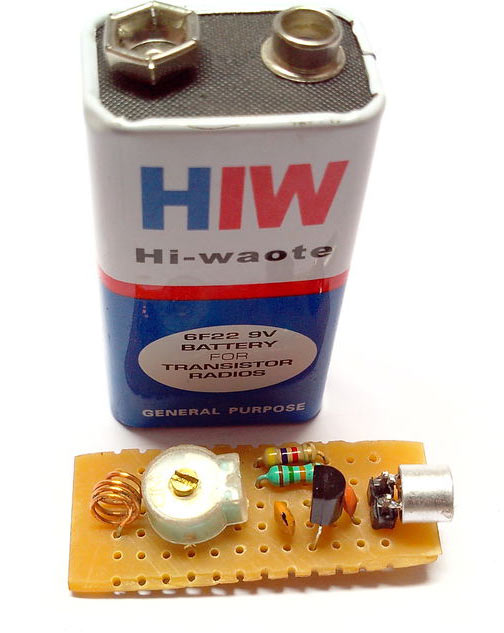 Here's how to build your own mini FM transmitter. It transmits FM waves so you could easily receive the signals on your mobile phone, radios, etc. As the name and the picture indicates it is very small and is approximately the size of a 9v battery clip. With this FM transmitter you could start your own mini FM station. The circuit uses BC547 transistor to amplify the signal and then frequency modulate it. It uses "frequency modulation" most commonly known as FM, the same principal to transmit audio signals captured by the microphone.
Posted on Sunday, June 22, 2014 • Category: Miscellaneous
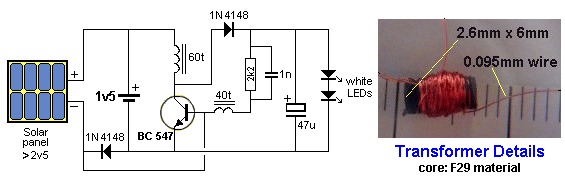 This circuit automatically turns on and illuminates the LEDs when the solar panel does not detect any light. It switches off when the solar panel produces more than 1v and charges the battery when the panel produces more than 1.5v + 0.6v = 2.1v.
Posted on Friday, June 20, 2014 • Category: USB Circuts
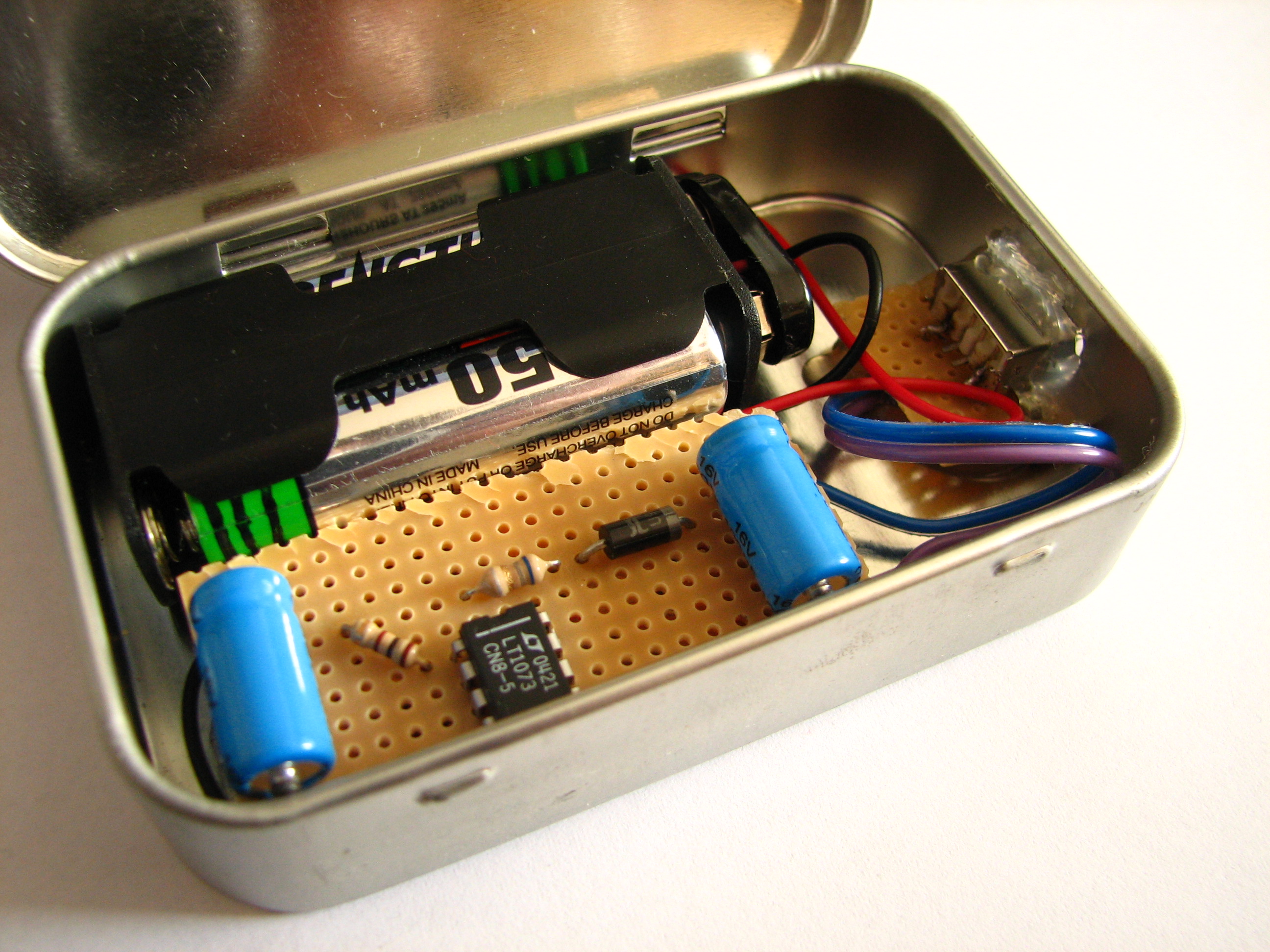 This project is able to power a USB device using two standard AA batteries and an electronics circuit. The circuit is based on LT1073 DC/DC converter to convert the 3V to 5V needed by USB. In that way it can power the USB device on the go.
Posted on Sunday, June 15, 2014 • Category: FM Transmitters
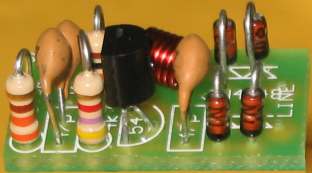 This small phone transmitter will transmit a phone conversation to an FM radio on the 88-108MHz band. It uses energy from the phone line to transmit the signal about 100 meters away. It uses the phone wire as the antenna and is activated when the phone is picked up. Transmitter components are mounted on a small PC board. PC layout is included.
Posted on Friday, June 6, 2014 • Category: FM Transmitters
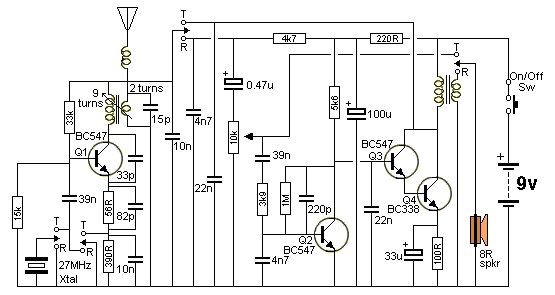 This classic walkie talkie consists of both 27MHz transmitter and receiver all in one circuit. Nearly all the components in the 4-transistor circuit are used for both transmitting and receiving making it simple to build and economical at the same time. The frequency-generating stage only needs 27MHz crystal to be removed and it becomes a receiver. Next is a three transistor audio amplifier with very high gain. The first transistor is a pre-amplifier and the next two are wired as a super-alpha pair, commonly called a Darlington pair to drive the speaker that is also used as a microphone. The use of telescopic antenna will provide better reception and transmitting range. Use two identical walkie talkie circuits for two way communication.
Posted on Sunday, June 1, 2014 • Category: Miscellaneous
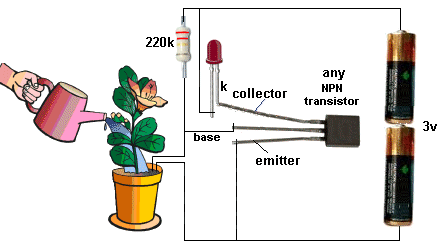 This simple plant water alarm circuit indicates when the soil is dry and the plant needs watering. The circuit does not have a current-limiting resistor because the base resistor is very high and the current through the transistor is only 2mA. Replacing 220K resistor with 1M potentiometer will provide adjustment when the alarm should be triggered depending on the moisture left in the soil.
Posted on Friday, May 16, 2014 • Category: FM Transmitters
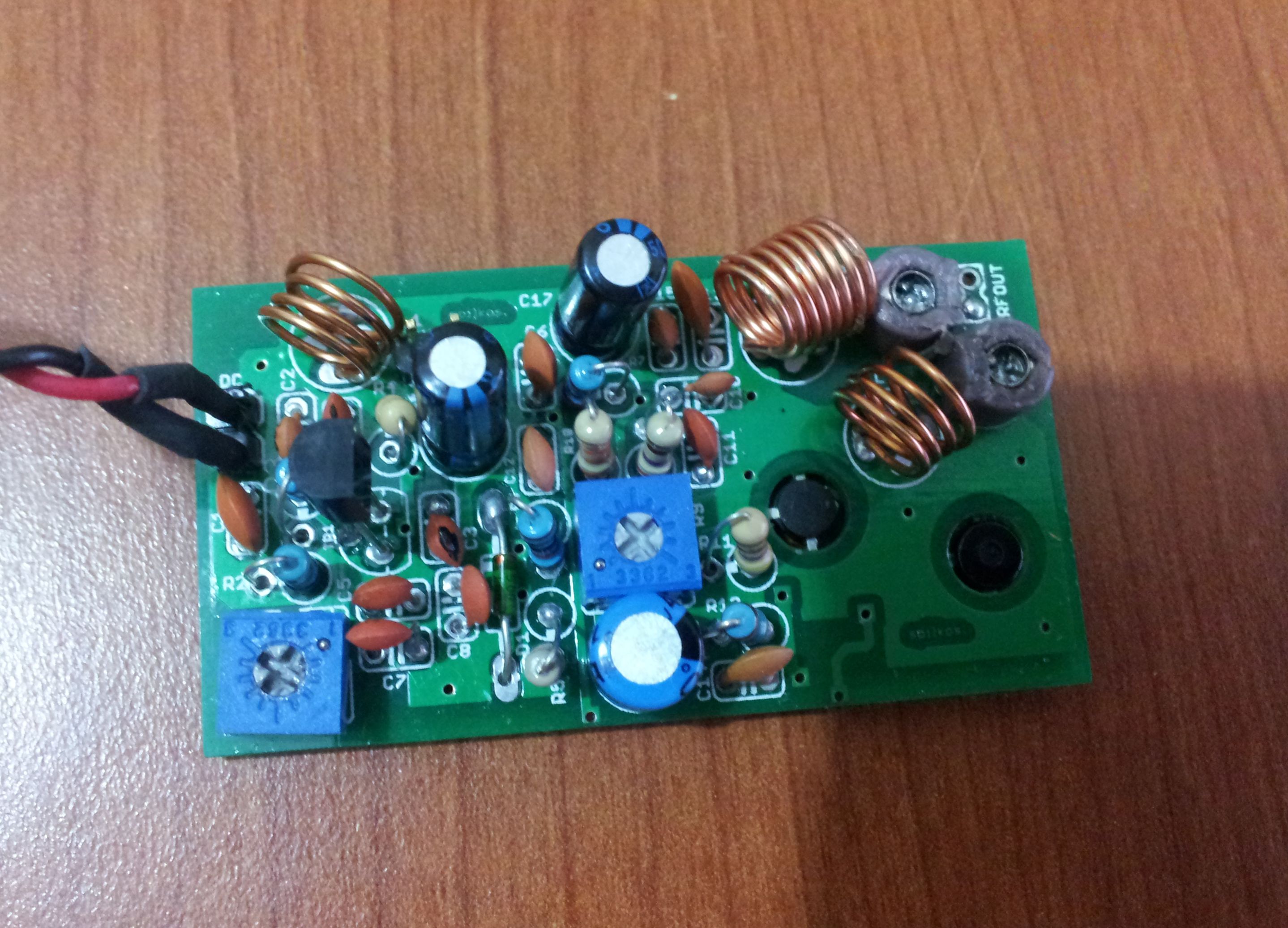 This is a VCO FM Transmitter. With good antenna (dipole placed outdoor and high) the transmitter has very good coverage range about 500 meters, the maximal coverage range is up to 4 km. To calibrate for maximum power connect 6 V / 0,1 light bulb to the output and use R1 to tune the right frequency, adjust L1 coil if necesary. Then use C14 and C15 to adjust the highest power (the highest light of the bulb). Then you can connect antenna and audio signal. Adjust R2 until the audio sounds as loud as the other stations.
Posted on Thursday, May 15, 2014 • Category: FM Transmitters
 This is a 1 Watt FM Transmitter amplifier with a good design that can be used to amplify a RF signal in the 88 – 108 MHz band. It is very sensitive if you use good RF power amplifier transistors, trimmers and coils. It has a power amplification factor of 9 to 12 dB (9 to 15 times). At an input power of 0.1W the output will be 1W. You must choose T1 transistor depending on applied voltage. If you have a 12V power supply then use transistors like: 2N4427, KT920A, KT934A, KT904, BLX65, 2SC1970, BLY87. At 18 to 24V power supply you must use transistors like: 2N3866, 2N3553, KT922A, BLY91, BLX92A. You may use 2N2219 at 12V but you will get an output power of 0.4W maximum.
Posted on Tuesday, May 13, 2014 • Category: Miscellaneous
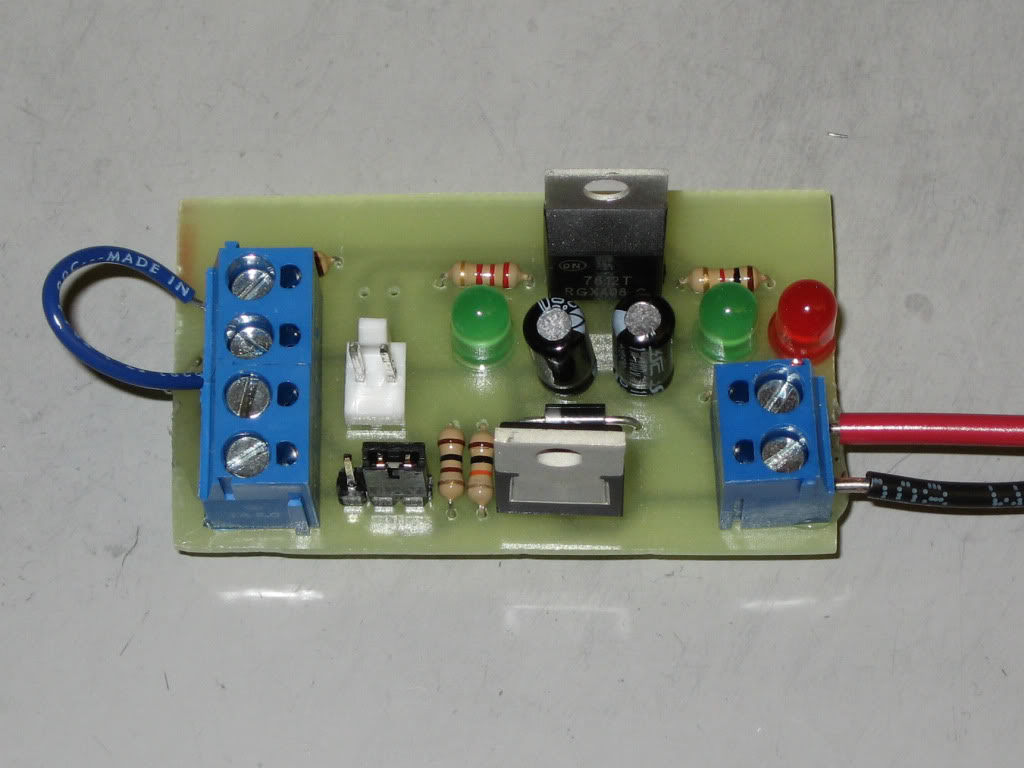 Constructing a MOSFET switch is one of the basic level electronics projects and could be useful for beginners to get a hang of the various FET transistors. The aim of this project is to make control a heavy duty DC load by constructing a simple switch. MOSFET transistors are capable of handling a large voltage and current. It is because of this feature that it is being much sought after for connecting heavy loads to a circuit or a microcontroller.
Posted on Friday, April 25, 2014 • Category: AM Radio
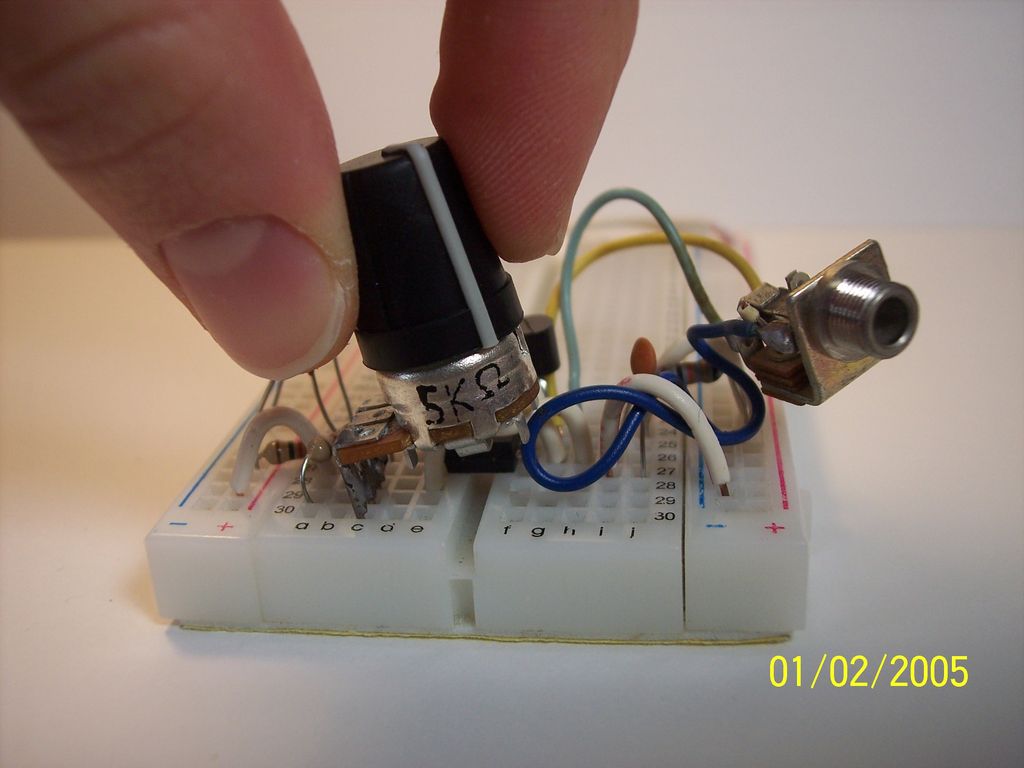 This project shows how to build a simple AM radio transmitter based on 555 timer IC. The circuit parts are: the 555 timer IC, a NPN transistor three caps, three resistors and a potentiometer. The circuit is able to generate an amplitude modulation signal at 600Khz and you are able to receive it using a plain AM receiver. The range is about 30-40 feet.
Posted on Tuesday, April 22, 2014 • Category: Power Supplies
 If you are starting to learn electronics variable bench power supply is the first thing you should build to power your projects. This simple power supply is built around the LM317/LM338/LM350 linear voltage regulator. The LM317 is one of the most popular voltage regulators on the market, and for good reason. It is very simple to use and requires very few external components. LM317/LM338/LM350 regulators provide a stable and reliable output voltage adjustable between 1.25V and 37V. The short circuit protection is also built right in the voltage regulator.
Posted on Monday, April 14, 2014 • Category: Arduino
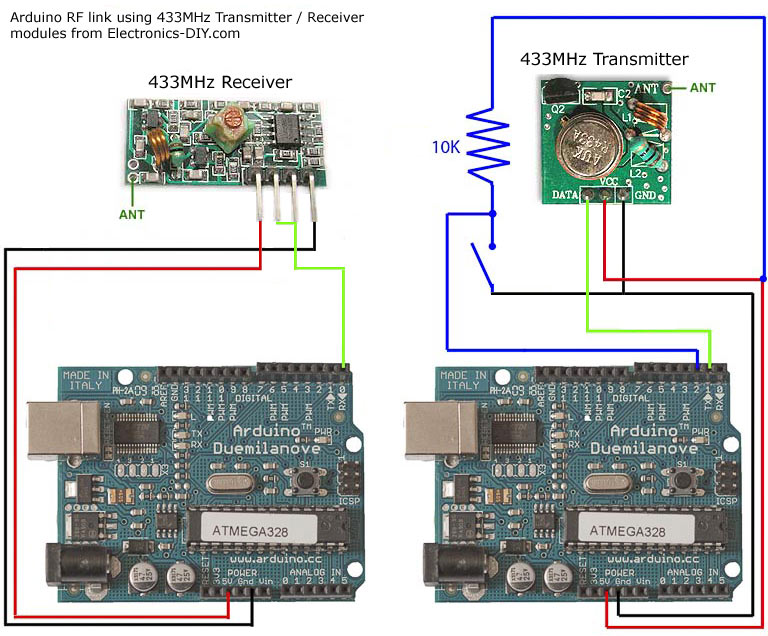 If you are looking into wireless communication between two Arduino modules, this project might be helpful. It uses low costs RF transmitter and receiver from Electronics-DIY.com to establish radio link between two Arduino boards up to 500 ft. Data can be transferred serially at the maximum rate of 2400 bps. The schematic shows how receiver and transmitter is hooked up to two different Arduino boards. When wiring the receiver / transmitter you only need to give them power / ground and then a pin for the TX (serial transmit) or RX (serial receive) pin. I also wired a button to the Arduino doing the transmitting, and used the LED on pin 13 that is built into my Arduino boards on the receiver so I could test this setup. The test app just flashes LED on the receiving board when a button is pressed on the transmitting board.
Posted on Tuesday, April 1, 2014 • Category: Frequency Wave Generators
 This is simple MAX038 generator. It produces sine, triangle and square waves from 1Hz up to 22MHz. The Amplitude, offset and duty cycle are adjustable to offer wide range of generated signals.
Frequency adjustment is made as a rotary switch S8 with a capacitor bank and variable resistor P7. Amplitude, offset and duty-cycle are performed via variable resistors. Switch S5 selects generated waveform.
Posted on Sunday, March 9, 2014 • Category: Test and Measurement
 An adjustable power load is a piece of test equipment that often comes handy in the development of a certain electronics projects. For example, when you are building a power supply, it will come a time when you need to "simulate" a load to see how well your design performs as the load varies. Adding power resistors to the output can sometimes do in a pinch, but often you will not have the right resistor value handy with the right power rating for the test. This is where an adjustable electronic load comes handy. In this article, I'll show how you can build one using common components available to the electronics hobbyist.
Posted on Thursday, February 27, 2014 • Category: Amplifiers
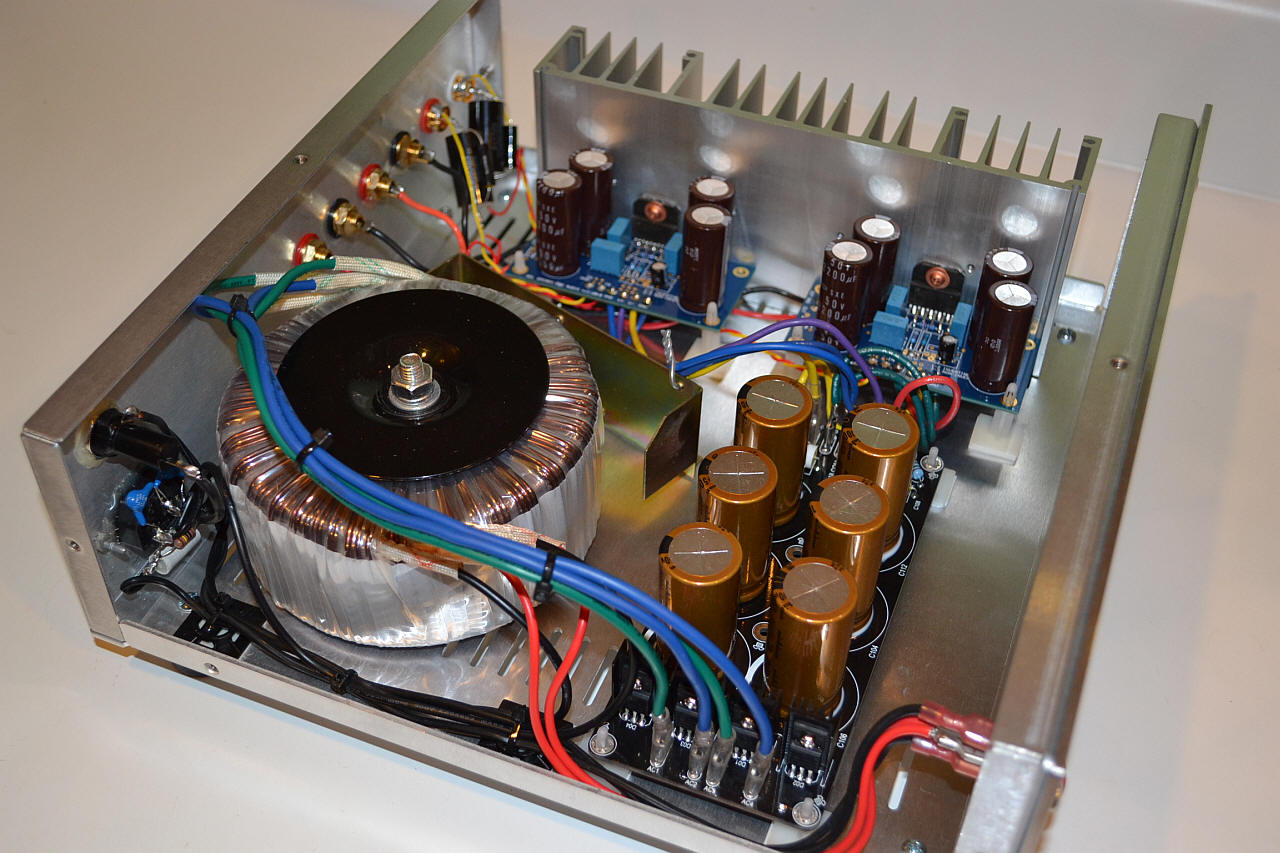 LM3886 is a high-fidelity audio power amplifier IC capable of delivering 68W of continuous power using 4 Ohm speakers. LM3886 provides excellent S/N ratio of 92dB and above as well as extremely low total harmonic distortion over the audio spectrum.
LM3886 comes equipped with Self Peak Instantaneous Temperature Protection Circuitry (SPiKE) that makes it a class above other discrete and hybrid amplifiers. SPiKe Protection makes LM3886 amplifier safe against problems like over voltage, under voltage, overloads, shorts to the supplies, thermal runaway, and temperature peaks.
Posted on Tuesday, February 18, 2014 • Category: FM Transmitters
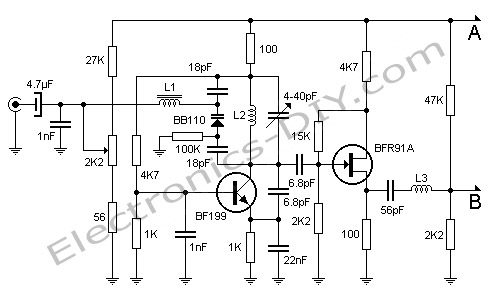 Here's FM transmitter for commercial FM band that provides 18 watts of power. Since the electronic diagram is too large we decided to divide it into two parts. The first part is the actual FM transmitter while the second part is 18W RF amplifier. The circuit should be built on an epoxy printed circuit board with the upper face components reserved for interconnecting tracks and the bottom solder to the ground plane. If powered by 14V and 2.5A transmitter outputs 15W of power, whereas 18V and 3.5A will provide 18W. BB110 variable capacitor connected to the collector of transistor BF199 adjusts the transmission frequency of the circuit. 2K2 potentiometer serves as fine tuning. Once the output frequency is adjusted amplifier variable capacitors must be adjusted for maximum output power one stage at a time. All adjustments must be made with 50 Ohm dummy load connected to the output of transmitter.
Posted on Friday, February 14, 2014 • Category: Solar Circuits
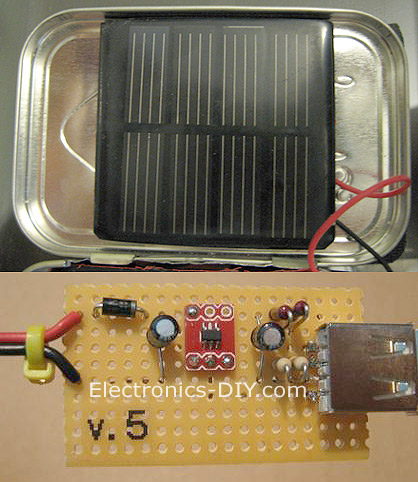 As the world around us becomes more and more environmentally conscious, alternative energies such as solar power are becoming more and more popular. The following solar charger is very simple and inexpensive to build and could be used to charge cellphones, tablets and other USB devices. 6V solar panel could be easily salvaged from outdoor garden lights. Solar charger uses REG113-5 efficient low dropout regulator that only loses 250mv of forward voltage. Linear style regulators such as a LM7805 or LM317 type voltage regulators lose as much as 2-3V and can not be used in this application. Optionally you may also add four-resistor voltage divider to charge an iPhone or iPad.
Posted on Tuesday, January 28, 2014 • Category: AC / DC Innveters
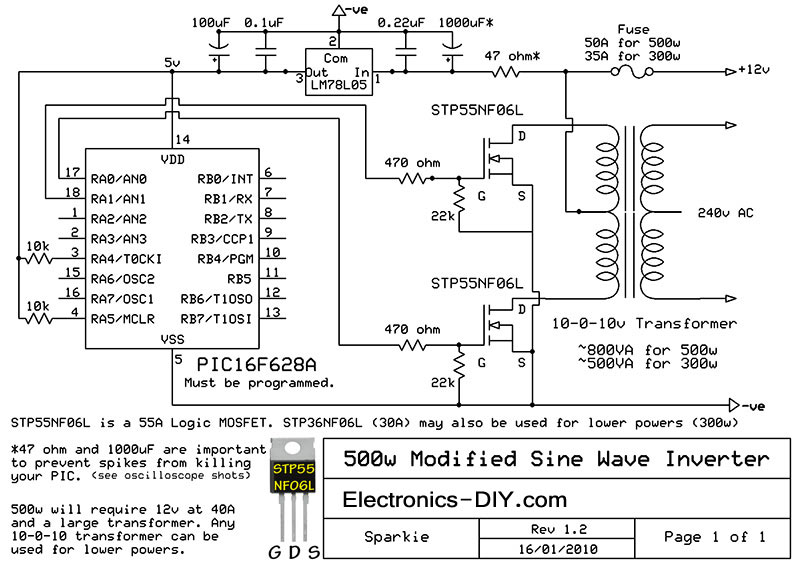 Here is a simple but powerful, stable and efficient schematic diagram for a 500W modified sine wave inverter circuit. Originally I used a 555 timer and a CD4017 decade counter to produce the modified sine wave, but then I thought a simple PIC micro controller with its internal clock would produce a stable 50Hz/60Hz frequency without the need for two ICs. As you can see its a very simple circuit. 220V transformer should be used for 220V voltage output. For 110V voltage output use transformer with 110V rating.
Posted on Wednesday, January 22, 2014 • Category: Power Supplies
 I normally use a USB port as power supply for my projects but some ICs need 3.3V instead of 5V. Therefore I decided to build this small dual power supply. Power supply uses two low dropout voltage regulators that provide up to 800mA of output current and come in TO-220 package. LD1117V33 is used for 3.3V and LD1117V50 for 5V. Input voltage is 6V-15V and both regulators can be switched on/off individually.
Posted on Sunday, December 29, 2013 • Category: FM Transmitters
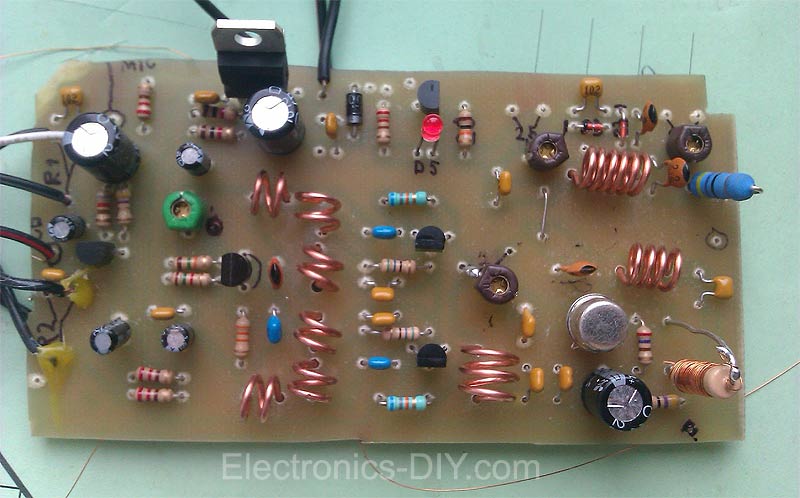 Veronica 1W FM transmitter is an easy to build transmitter. Veronica is also known for frequency stability, clean FM signal and uses no integrated circuit. The Veronica oscillator is actually formed from 2 oscillators which operates somewhere around 50 MHz in anti phase and the 2 signals are combined to form 100MHz FM radio signal. This kind of circuit design is stable and is amplified up to 1W by 2n4427 transistor. Veronica transmitter is equipped with a mini-mixer and so you may forget an external mixer. This consist from T1 transistor which amplifies the microphone signal before it is combined with cd-player audio or PC signal. R1 and R2 are potentiometers (variable resistors) used to adjust the audio level. The component between R8 and C21 represents the oscillator wich generates radio signal. D1 is a varicap diode (like a variable capacitor or trimmer) controlled by audio signal. C12, C13 and L1 determines the frequency.
Posted on Sunday, December 29, 2013 • Category: LED
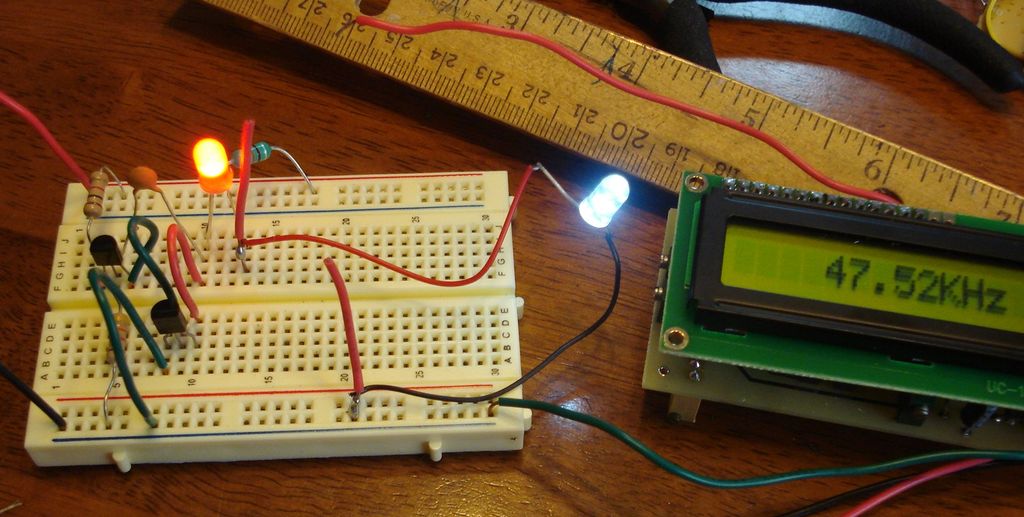 The "Joule Thief" circuit that does not use a transformer to power LED from a single 1.5V battery cell. The circuit consists of two bipolar transistors, coil, two resistors and capacitor to generate higher voltage through 50KHz frequency to power an ordinary LED. Entire circuit draws only about 15 milliamps.
Posted on Wednesday, December 18, 2013 • Category: FM Transmitters
 Following 1W PLL transmitter exciter provides stable, low noise operation. Transmitter uses a PLL frequency synthesizer built with MC145152 which covers the FM band in 100kHz steps. The VCO uses MV2109 varicap diode to automatically tune to selected frequency via SW1 dip switch. output stage uses 2N4417 RF power transistor and provides 1W of RF power. With good antenna expected transmission range is 2km. Transmitter may be built on a double sided PCB, with top side copper left mostly undisturbed as a ground plane. The copper is removed only around non-grounded pins. The ground connections can be soldered on the top side, so it’s not necessary to have plated-through holes.
Posted on Friday, December 13, 2013 • Category: LED
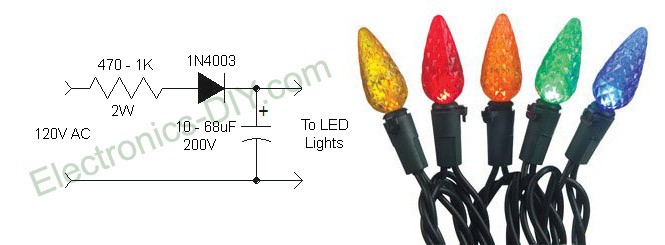 I like the idea of using LED Christmas lights because they look cool and consume very small amount of electricity, but the flicker drives me crazy! That's because they are powered directly from 110V AC voltage instead DC voltage which makes them flicker 60 times per second. Here is a simple circuit that will completely eliminate LED Christmas lights flicker. The solution is to convert AC to DC voltage with resistor, rectifier diode and capacitor. Using 470 ohm - 1K resistor is very essential because it limits the current to 20mA and minimizes the voltage to about 80 volts. If we didn't use the resistor LEDs would be powered by over 50mA of current which is much more than what they need and that would definitely shorten their life. Note that lowering voltage does not reduce the brightness of the LEDs because when powered by DC voltage they are always on.
Posted on Thursday, December 12, 2013 • Category: FM Transmitters
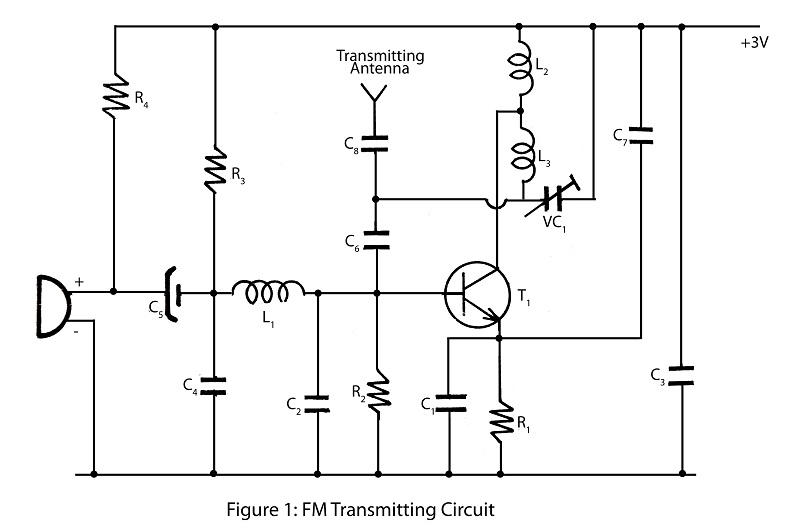 Here is a very interesting and simple FM transmitter used to transmit audio in the wide range up to 100M using only one transistor. The entire circuit of FM transmitter is divided into three major stages oscillator, modulator and amplifier. The transmitting frequency of 88-108 MHz is generated by adjusting VC1. The input audio generated by microphone is changed into electric signal and is given to base of transistor T1. Transistor T1 is used as oscillator which oscillates the frequency of 88-108 MHz. The oscillated frequency depends upon the value R2, C2, L2 and L3. Transmitted audio from FM transmitter circuit can be received by standard FM receiver.
Posted on Monday, December 9, 2013 • Category: Audio DAC
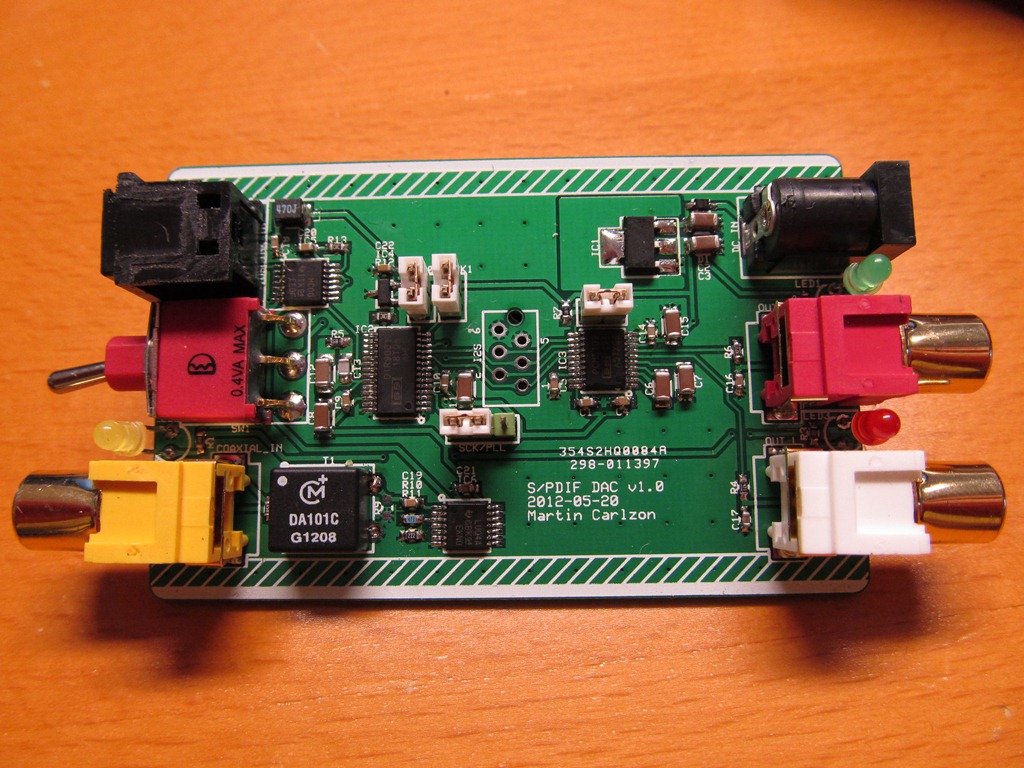 This DAC is based on latest 32bit/384K PCM5102 DAC chip and DIR9001 from Texas Instruments. Sound quality produced by PCM5102 DAC is surprisingly good, very smooth and airy, with great dynamics and excellent soundstage. It features both S/PDIF and optical inputs connected to DIR9001 low jitter digital receiver. PCM5102 uses a next generation architecture based on the PCM1792/4 TI's flagship DACs. It has 112dB SNR, with an integrated negative rail charge pump and line driver, so you don't need no opamps at the end or dual split supplies. Just a simple RC low pass filter is all that is needed. In addition, there's a fancy PLL involved that will autodetect I2S rate, configure the device, and generate it's own internal master clock so no need for external clock. Entire DAC is powered by only 3.3V from 1117-33 regulator and consumes only 20mA of power. Although PCM5102 DAC can be powered by 4-12V DC voltage, it's recommended to power it from a single 3.7V LIPO battery to achieve the best performance.
Posted on Thursday, November 21, 2013 • Category: FM Transmitters
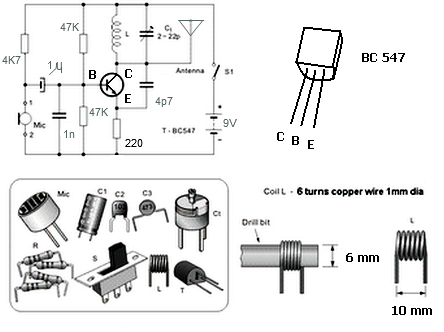 This is simple FM transmitter for FM broadcast band in 88-108 MHz. BC 549 is small signal transistor for wide applications, but usually for AF. You can build simple FM transmitter with one BC549 transistor and several other component parts. Simple FM transmitter with only one transistor is often called “bug”. This project is suitable for beginners in radio amateur, education, or hobbies. As an antenna you can connect 150cm of copper wire.
Posted on Wednesday, October 16, 2013 • Category: FM Transmitters
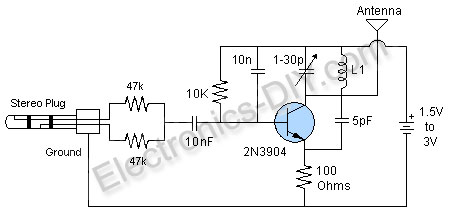 A simple MP3 FM transmitter circuit shown here can be built easily in few minutes if all parts are available to you. All the components used in this transmitter circuit are general purpose and low cost. The circuit will work as a best FM transmitter for simply broadcasting your music around your house and yard, and can be used to broadcast the output of any equipment like mp3 player, ipod, satellite, etc.
Posted on Sunday, October 6, 2013 • Category: Remote Control
 This little project will demonstrate how you can use NEC IR protocol based TV, DVD or VCR remote control to control you home appliances like fan bulb or virtually anything. There are lots of projects out there to accomplish this task but i have to write my own code because of too many requests on IR infrared Remote Control Relay Board with PIC12F675 Microcontroller. There are a number of consumer Infrared protocols out there and they have been used for every single purpose possible, like PDA laptops and other consumer appliances. RC-5 & RC-6 by Phillips, RCA are few examples of consumer IR protocols.
Posted on Thursday, September 26, 2013 • Category: FM Radio / Receivers
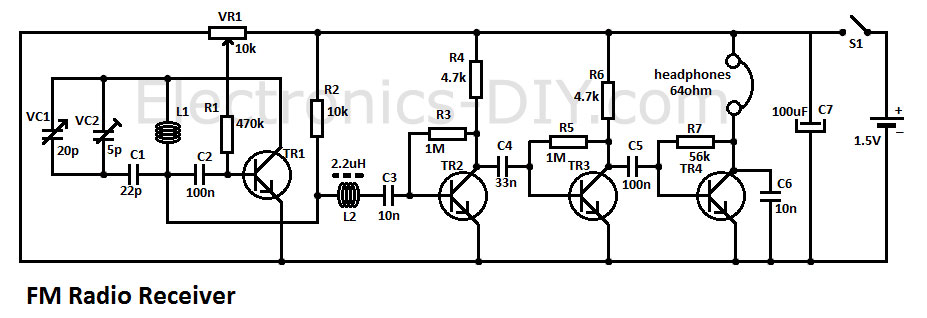 This FM radio receiver circuit is very simple to build and is powered by just a single 1.5V battery cell. Receiver consists of a regenerative rf stage, TR1, followed by a two of three-stage audio amplifier, TR2 to TR4. In some areas 3 stages of audio amplification may not be necessary, in which case TR3 and its associated components can be omitted and the free end of capacitor C5 connected to the collector of TR2.
The critical part of the fm radio receiver is the first stage, TR1/VC1, where the wirings must be kept as short as possible. Coil L1 is formed by winding 8 turns of 1mm (20 swg) enamelled copper wire on a 6 mm diameter former, which is then removed. After that L1 should be stretched carefully and evenly to a length of about 13mm.
Posted on Monday, September 23, 2013 • Category: FM Transmitters
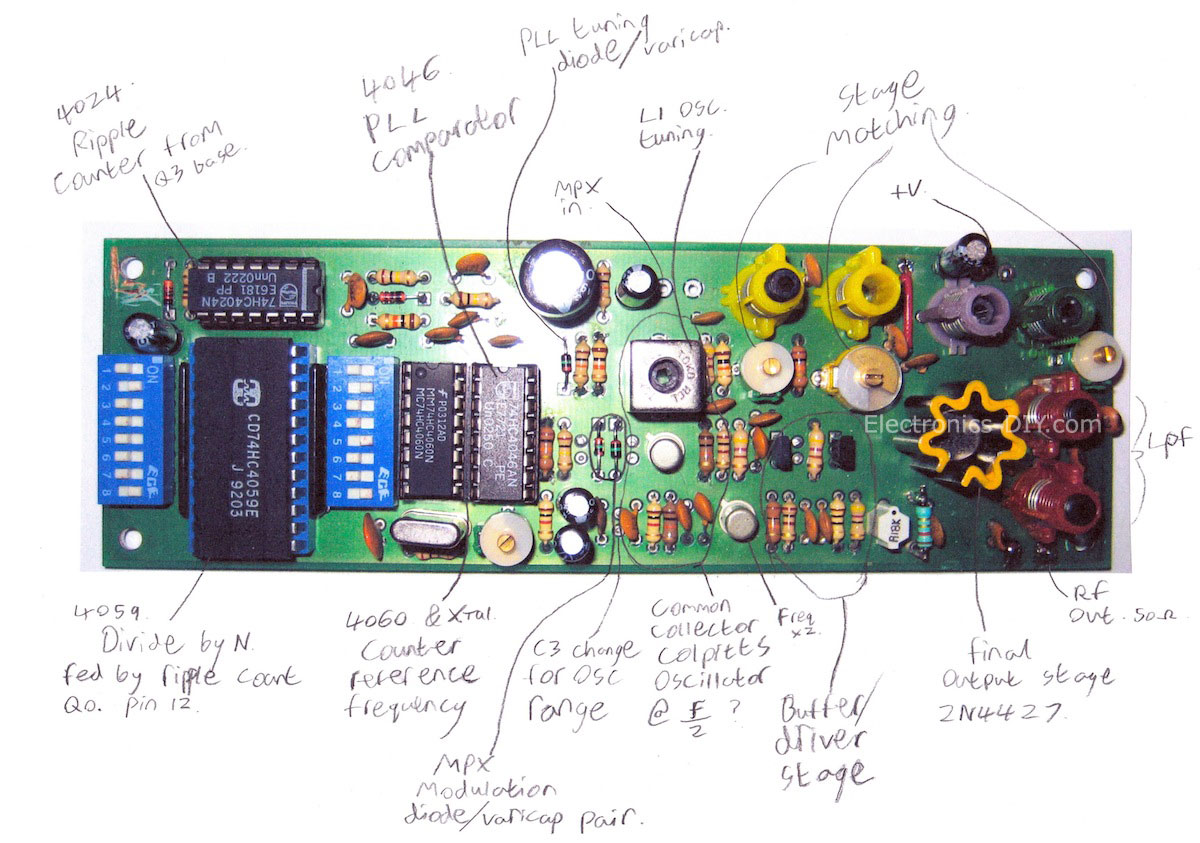 This is a 1 Watt PLL FM broadcast transmitter. The RF output varies from 500mW to about 1.2W depending on the frequency selected and RF output transistor used. Motorola 2N4427 always seems to work well. Transmitter uses CMOS PLL VCO that prevents the frequency drifts. The frequency is selected via DIP switches. The transmitter is supplied by 12V DC and can also be powered from the battery.
Posted on Friday, September 20, 2013 • Category: Arduino
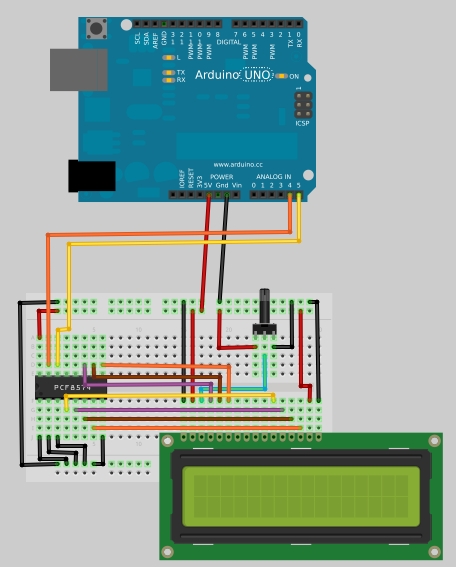 In this tutorial you will learn how to build a simple serial 16x2 LCD display that is controlled via Arduino board by only two wires. The magic behind is done by the PCF8574 chip, an I/O expander that communicates with the micro-controller by using I2C protocol. The PCF8574 is a quick and easy solution to extending and adding output/input ports to Arduino. The chip connects to a standard I2C bus and adds an additional 8 output ports. A total of 8 LCD displays can be connected to the same two wire I2C bus with each board having a different address.
Posted on Friday, September 13, 2013 • Category: FM Transmitters
 This FM transmitter is about the simplest and most basic FM transmitter it is possible to build and have a useful
transmitting range. It is surprisingly powerful despite its small component count and 3V operating voltage. It will
easily penetrate over three floors of an apartment building and go over 300 meters in the open air. The circuit
we use is based on a proven Australian design. It may be tuned anywhere in the FM band. Or it may be tuned
outside the commercial M band for greater privacy. (Of course this means you must modify your FM radio to
be able to receive the transmission or have a broad-band FM receiver.) The output power of this FM Tx is below
the legal limits of many countries (eg, USA and Australia). However, some countries may ban ALL wireless transmissions without a license. It is the responsibility of the builder to check the legal requirements for the operation of this circuit and to obey them.
Posted on Sunday, September 1, 2013 • Category: FM Transmitters
 This portable FM Transmitter is easy to build. I have used a pair of BC548 transistors in this circuit. Although not strictly RF transistors, they still give good range. Transmitter is powered by 9V battery. The coil L1 consists of 7 turns on a quarter inch plastic former with a tuning slug. The tuning slug is adjusted to tune the transmitter. Actual range on my prototype tuned from 70MHz to around 120MHz. The aerial is a few inches of wire. Lengths of antenna wire should be 1 - 2 feet. The circuit is basically a radio frequency (RF) oscillator that operates around 70-120 MHz. Audio from audio jack is fed into the audio amplifier stage built around the first transistor. Output from the collector is fed into the base of the second transistor where it modulates the resonant frequency of the tank circuit by varying the junction capacitance of the transistor. Junction capacitance is a function of the potential difference applied to the base of the transistor. The tank circuit is connected in a Colpitts oscillator circuit.
Posted on Friday, July 19, 2013 • Category: FM Transmitters
 This circuit provides an FM modulated signal with an output power of around 500mW. The input microphone pre-amp is built around a couple of 2N3904 transistors (Q1/Q2), and audio gain is limited by the 5k preset trim potentiometer. The oscillator is a colpitt stage, frequency of oscillation governed by the tank circuit made from two 5pF ceramic capacitors and the L2 inductor. The output stage operates as a 'Class D' amplifier, no direct bias is applied but the RF signal developed across the 3.9uH inductor is sufficient to drive this stage. The emitter resistor and 1k base resistor prevent instability and thermal runaway in this stage.
Posted on Sunday, May 19, 2013 • Category: FM Transmitters
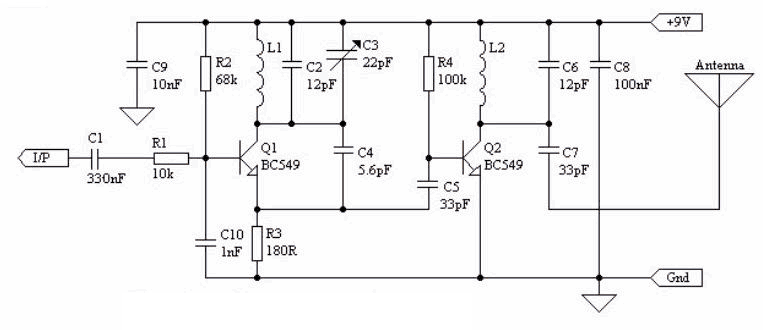 This low power fm transmitter is designed to use an input from another sound source and transmits on the commercial FM band. This low power fm radio transmitter it is actually quite powerful.
The first stage is the oscillator, and is tuned with the variable capacitor. Select an unused frequency, and carefully adjust C3 until the background noise is removed.
Posted on Wednesday, May 15, 2013 • Category: FM Radio / Receivers
 Here's a portable FM broadcast radio receiver for reception of FM broadcast band based around FET transistor. The topology is a classic grounded-gate FET VHF Hartley oscillator. The drain resonator inductance is centre-tapped with feedback to the source through a small capacitance. By tapping down towards the cold-end of the coil the feedback isn't as critical as your usual source-drain capacitor feedback and it tends to be far less difficult to get to work across a broad range of frequencies. The RFC to an RC source circuit to implement self-quenching is very traditional for super-regenerative detectors. The quench gets frequency-modulated somewhat by the drain current, so it varies with signal strength and the recovered modulation, this is typical for self-quenched circuits.
Posted on Saturday, May 11, 2013 • Category: FM Transmitters
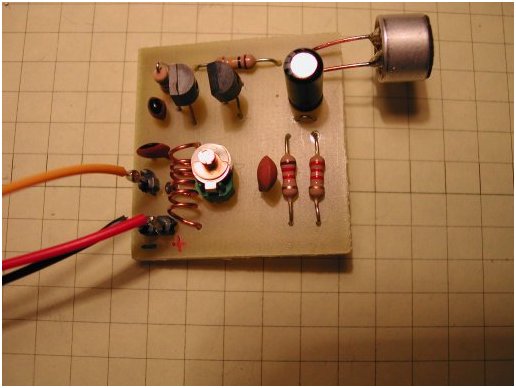 This article shows you how to build a very simple FM transmitter from thirteen components, a Printed Circuit Board (PCB) and a 9v battery.
This project was designed to be mounted on a PCB, however you don’t have to. You could construct the project on Vero board (strip board) or any other 0.1” pitch style of project board. If you just want to experiment with this circuit, you don’t even need a board; you can just solder the component s together and let the completed project just rest on the work top. No matter which style you choose, try to keep all component leads nice and short.
You could also make the PCB much smaller than the one shown here which is approx. 3 cm square. This is a good size to keep the unit small but nicer to work on for beginners. If you wanted to make one really small, you could use all SMT parts.
Posted on Thursday, May 9, 2013 • Category: Sensors
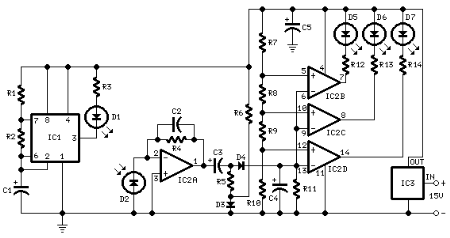 Park Assist circuit was designed as an aid in parking the car near the garage wall when backing up. LED D7 illuminates when bumper-wall distance is about 20 cm., D7+D6 illuminate at about 10 cm. and D7+D6+D5 at about 6 cm. In this manner you are alerted when approaching too close to the wall. All distances mentioned before can vary, depending on infra-red transmitting and receiving LEDs used and are mostly affected by the color of the reflecting surface. Black surfaces lower greatly the device sensitivity. Obviously, you can use this circuit in other applications like liquids level detection, proximity devices etc.
Posted on Monday, May 6, 2013 • Category: Test and Measurement
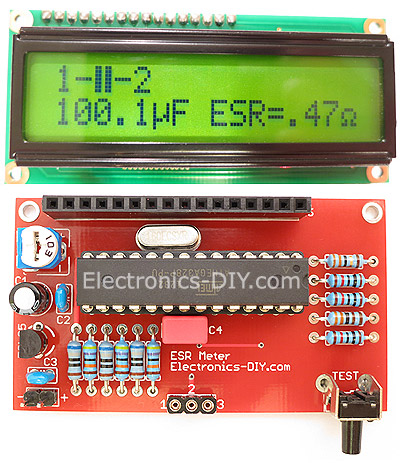 ESR Meter is an irreplaceable tool for troubleshooting and repairing electronic equipment by determining performance and health of electrolytic capacitors. Unlike other ESR Meters that only measure ESR value this one measures capacitor's ESR value as well as its capacitance all at the same time. Additionally, ESR Meter also tests and identifies PINs of all transistors such as Bipolar (NPN, PNP), FETs, MOSFETs (N-Channel, P-Channel, enhancement-mode and depletion-mode MOSFETs), Thyristors, SCRs and Triacs. Tests and identifies PINs and voltage of diodes, dual diodes, varicap diodes (and their capacity), zener diodes (test voltage up to 5V) and LEDs. It measures resistance of resistors, power resistors, coils starting from just 0.1Ω up to 20MΩ.
Posted on Thursday, May 2, 2013 • Category: Remote Control
 If you want control the DVD or TV/AV system that located in your living room via the remote control when you sleeping in your Bedroom. this IR extender will achieve this for you. Basically, it works as a repeater that moves the IR signal to a different location. This is an improved IR remote control extender circuit. It has high noise immunity, is resistant to ambient and reflected light and has an increased range from remote control to the extender circuit of about 7 meters. It should work with any domestic apparatus that use 36-38kHz for the IR carrier frequency.
Posted on Friday, April 26, 2013 • Category: Power Supplies
 Modern power supplies are known as "switching regulator power supplies."
In most switching supplies, the 110 volt AC input is first rectified by
two diodes and filtered by a pair of capacitors. This creates two high-
voltage sources; one positive and the other negative.
A pair of transistors is then used to switch these high voltage supplies
across the primary winding of a transformer. This switching action is
very fast. A typical switching speed is around 40,000 cycles per second
or 40KHz. An integrated circuit is commonly used to control the
transistors. This IC not only controls the speed at which the
transistors are switched, but also controls the amount of time that each
transistor is energized. The output voltage of the power supply is
determined by the "on" time of the transistors. If the transistors are
keep on for a longer period of time, the output voltage of the supply
will rise, while shorter times lower the output voltage. This is known
as "pulse-width modulation."
Posted on Sunday, April 21, 2013 • Category: Motor Controllers
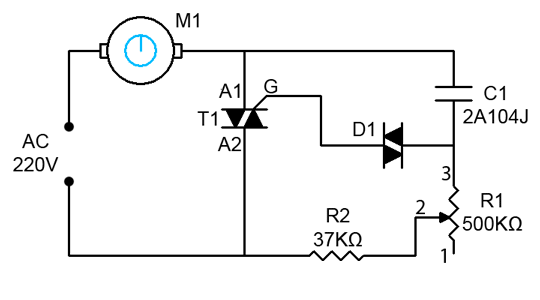 This triac based AC motor speed controller circuit is designed for controlling the speed of AC motors like drill machines, fans, vacuums, etc. The speed of the motor can be controlled by changing the setting of P1 potentiometer. The setting of P1 determines the phase of the trigger pulse that fires the triac. The circuit incorporates a self-stabilizing technique that maintains the speed of the motor even when it is loaded.
Posted on Tuesday, April 16, 2013 • Category: FM Transmitters
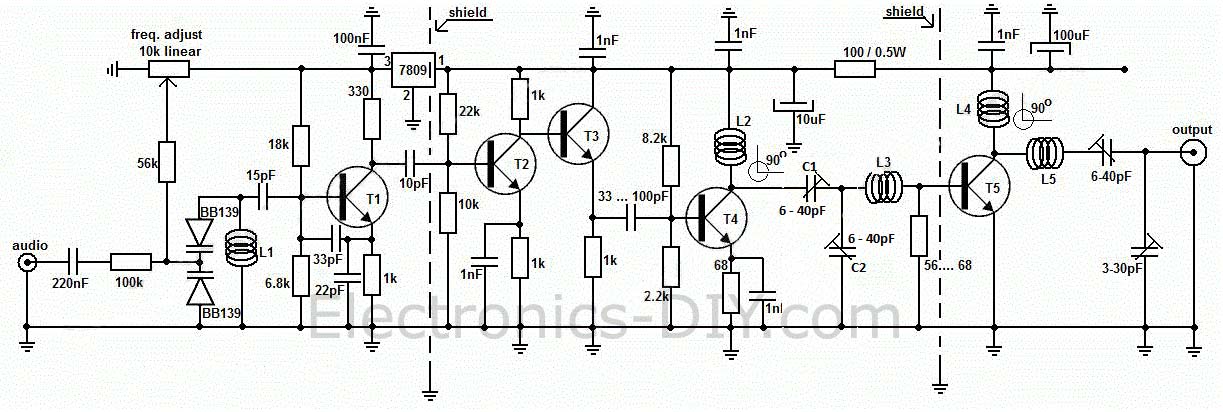 Long range, very stable, harmonic free, FM transmitter circuit which can be used for FM frequencies between 88 and 108 MHz. With good antenna transmitter can cover 5km range. It has a very stable oscillator because it uses LM7809 voltage regulator which is a 9V stabilized power supply for T1 transistor. Frequency adjustment is achieved by using the 10K linear potentiometer. The output power of this long range RF transmitter is around 1W but can be higher if you use transistors like KT920A, BLX65, BLY81, 2N3553, 2SC1970 or 2SC1971.
Posted on Friday, April 12, 2013 • Category: FM Transmitters
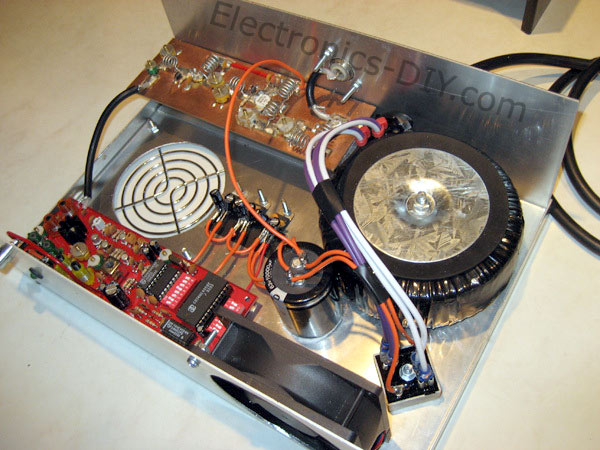 Building two stage 40 Watt FM Transmitter Amplifier. RF input power should be between 0.5 and 1 watt. Amplifier is powered by 28V power supply. The diagram shows a 2N3375 driving a 2N5643 but there are many other transistors that will work. I used these two transistors just because they were cheap at the time. If any of the variable capacitors are at full capacitance you can pad them out with a fixed ceramic capacitor of suitable value. Extra capacitance also might be needed on the base of the transistors (i had to add 3 100pF capacitors on the base of the 2N5643). The transistors are bolted to a piece of right angle aluminum which is fixed to the metal chassis to dissipate heat effectively.
Posted on Thursday, April 4, 2013 • Category: Frequency Wave Generators
 Presented here is XR2206 function generator with multiple waveform selection and a frequency readout display. The diagram on the right shows the internal workings of the XR2206 in the form of a block diagram. Essentially the chip contains A VCO (voltage controller oscillator), wave shaper and buffer. The XR2206 frequency generator diagram frequency of the VCO is set with a capacitor and a resistor. The capacitor sets the frequency range whilst a variable resistor can be used to vary the frequency in the set range. The frequency is defined by ƒ = 1/(RC). For a starting point for the design of the frequency generator I used the test circuit from the XR2206 datasheet. I built this on bread board and experimented with the timing resistor and capacitor and managed to get the frequency up to 4MHz.
Posted on Saturday, March 30, 2013 • Category: FM Transmitters
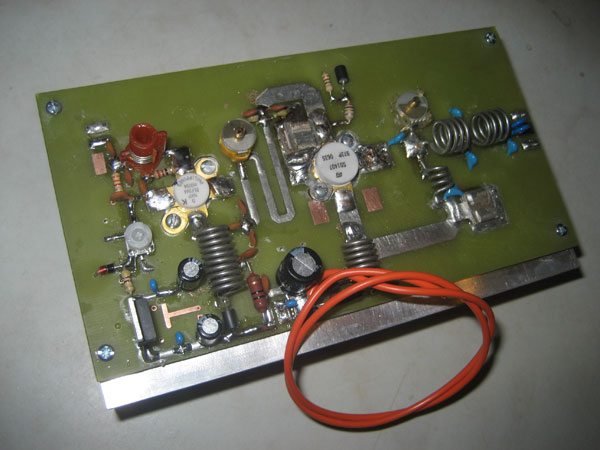 This is 150W FM transmitter amplifier for 88-108MHz band. The amplifier has two stages using BLF244 mosfet transistor for the first stage which requires 0.5 - 1Watt of RF input to get about 20watts to drive the final stage SD1407 which can push nearly 200 Watts on this design.
This design is more or less broadband however I added two variable capacitors after each stage for optimum matching and power output. Make sure the trimmer and the capacitors after the final stage SD1407 are a high voltage types with at least 200V rating. The power on this amplifier can be varied by adjusting the bias voltage using the white pot to the BLF244 mosfet. I added a zener diode onto the bias supply to protect the transistor from too much bias voltage.
Posted on Sunday, March 24, 2013 • Category: Power Supplies
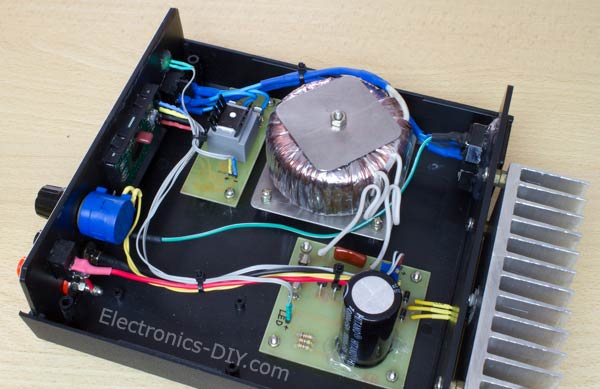 Here's how to build your own adjustable power supply based on LM317. The IC LM317 is so versatile that an almost unlimited number of different, small, high grade power supply circuits can be built using it. The configurations can be introduced for different applications for upgrading an existing unit with features that would virtually make it indestructible.
A few useful application circuits using IC LM317, collected from National Semiconductor's PDF datasheet are meticulously explained in this section with the help of the relevant circuit diagrams. All the circuits discussed below require an unregulated input voltage (max. 35 Volts) from any standard transformer/bridge/capacitor network.
Posted on Wednesday, March 20, 2013 • Category: FM Transmitters
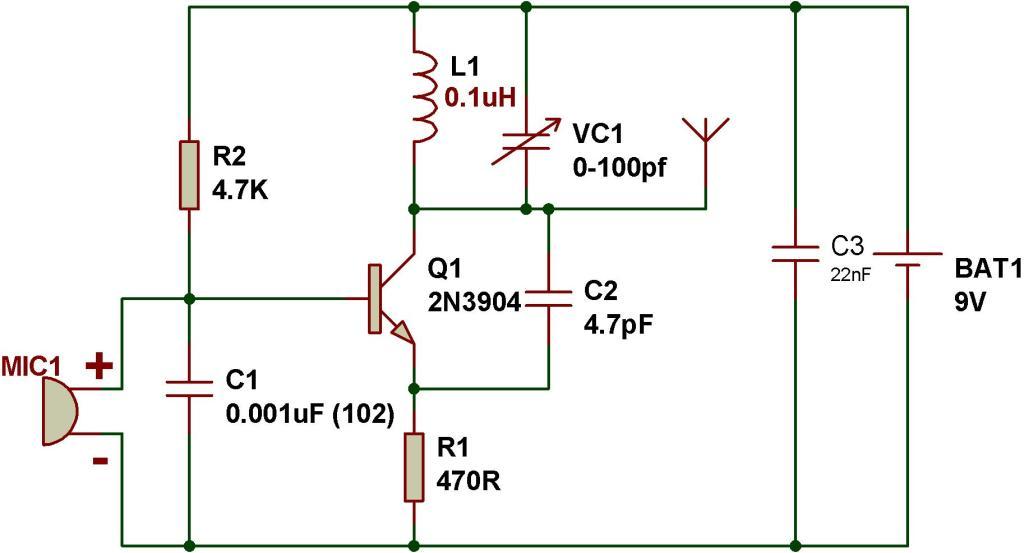 This tutorial is for making simplest FM transmitter using only one transistor. VC1 is a small, screw-adjustable, trimmer capacitor and its rating should be around 10-100pF. Set your FM receiver for a clear, blank station. Then, with a non-conductive tool, adjust the capacitor for the clearest reception, rotate it till the receiver receives a sound from the microphone of transmitter. Use the following formula for determining the frequency.
Posted on Friday, March 15, 2013 • Category: AM Radio
 VHF FM Aircraft Receiver is a superregenative receiver developed for listening to FM transmitters but also tunes the aircraft band and the top portion of the FM broadcast band. Receives both AM and FM (107mHz to 135 MHz). You can use this receiver with the any FM transmitter. The receiver is amazingly simple using only one transistor for the receiver section and one IC for the audio section. This circuit is a self-quenching regenerative RF receiver also known as a superregenerative receiver. A superregenerative receiver performs two basic functions. First it feeds back a portion of the received signal from it’s output in phase to its input; and second a super audible quenching oscillator drives the amplifier through the point of oscillation and maximum sensitivity and then quenches the oscillation repeatedly. This keeps the feedback from driving the circuit into self-oscillation and allows the signal to be regenerated over and over again. In this version of the circuit, both functions are performed by the circuitry associated with Q1.
The rest of the circuit, shown to the right of L3 in the schematic, comprise the audio amplification circuit and are centered on the LM386 Audio Amp IC. In this configuration the LM386 is set at a gain of 200 and feeds it’s output to a standard 1/8-inch diameter stereo phone jack. The audio can then be heard by plugging any standard stereo headset into the jack.
Posted on Monday, February 25, 2013 • Category: FM Transmitters
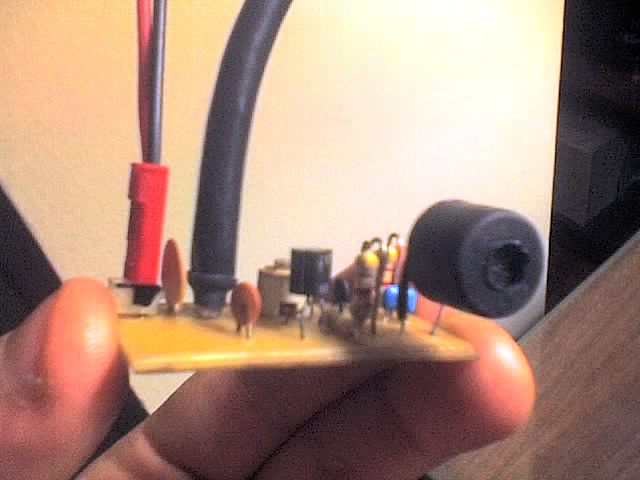 For months I’ve been looking for a simple FM BUG project, the ones online require inductors which you either have to acquire or build, if you don’t have a LCR meter it becomes rather hard to get the circuit working, specially if you’re a beginner without an oscilloscope! – Sometimes they don’t even tell you which inductance is required and you have to calculate an estimate, which is the main reason why many high frequency RF projects fail in the first place. This circuit on the other hand performs pretty well, even if you’re manipulating the board or touching the coax it will stay within the tuned frequency (unless you touch the transistor or timing capacitor!).
Posted on Saturday, February 16, 2013 • Category: FM Transmitters
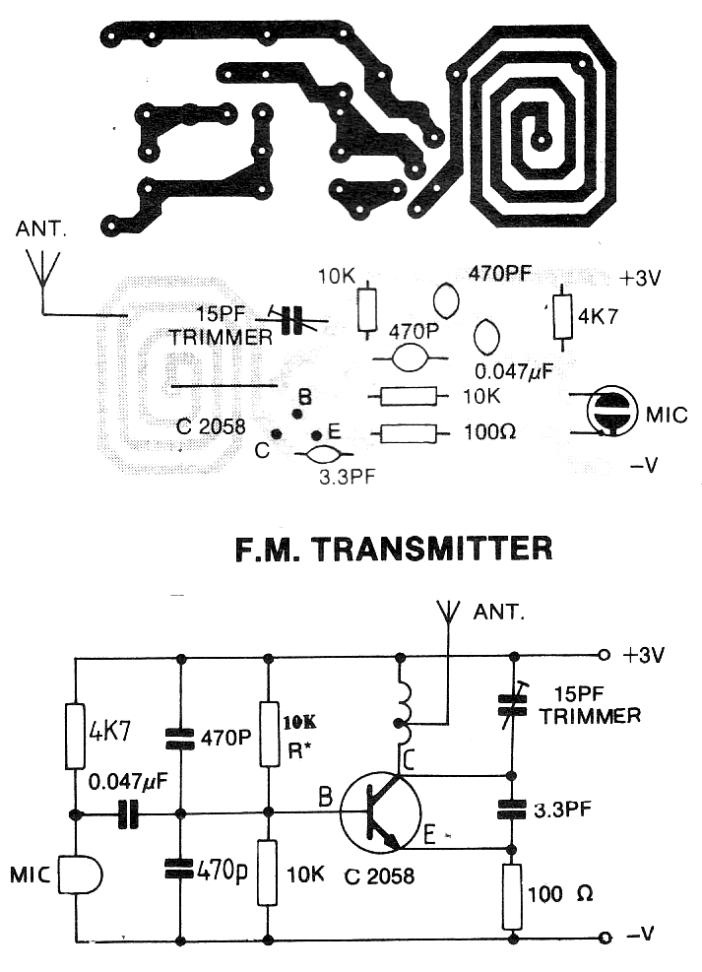 The objective of this 3V FM Transmitter design is to provide a simple low-power transmitter solution for broadcasting audio from various audio sources. This transmitter transmits audio using small sensitive microphone. Transmitter's frequency, as built is tunable via 15pF trimmer to the desired frequency, and the coil is embedded on the circuit board. This implementation is adapted to rebroadcast the output of a CD player, television receiver, or radio receiver. I use this transmitter so that I can move about the house and listen to my favorite programs without disturbing others. Within and the house, I find that I can get 50 to 100 meters away from the transmitter with the small pocket FM receiver I carry in my shirt pocket.
Posted on Sunday, February 10, 2013 • Category: FM Transmitters
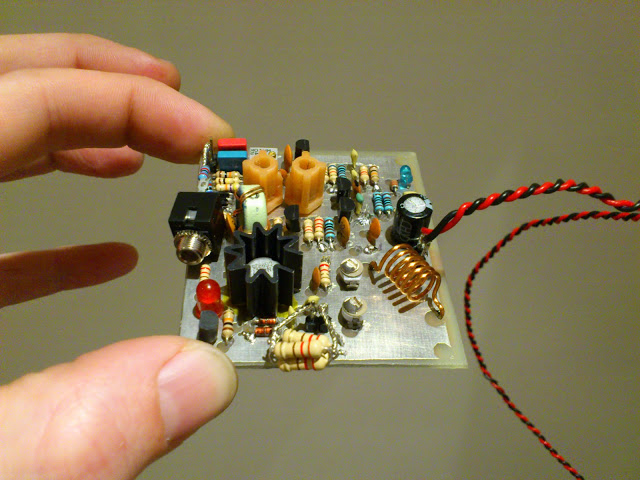 This little broadcast FM transmitter has 500mW of RF output power and runs of 12-15V battery or power supply. DC whose signal modulated by FM using four transistors. Transmitter includes four transmitter stages and draws around 100-150mA of current. Using the values of the circuit components, the frequency will be around 100 MHz but can be changed via coil. Through the 5 pF capacitor and 10K ohm resistor, the modulation of audio signal is supplied to the tank circuit. The amount of modulation is being managed by the 1N4002, a general purpose rectifier diode. FM Transmitter's output stage is functioning as a class D amplifier where the output transistors act as a switch.
Posted on Tuesday, January 29, 2013 • Category: Test and Measurement
 This is high quality function generator system using the XR2206 chip. Waveform function generator capable of producing AM/FM modulated sine wave outputs find a wide range of applications in electrical measurement and laboratory instrumentation. This application note describes the design, construction and the performance of such a complete function generator system suitable for laboratory usage or hobbyist applications. The entire function generator is comprised of a single XR2206 monolithic IC and a limited number of passive circuit components. It provides the engineer, student, or hobbyist with highly versatile laboratory instrument for waveform generation at a very small fraction of the cost of conventional function generators available today.
Posted on Thursday, January 24, 2013 • Category: Power Supplies
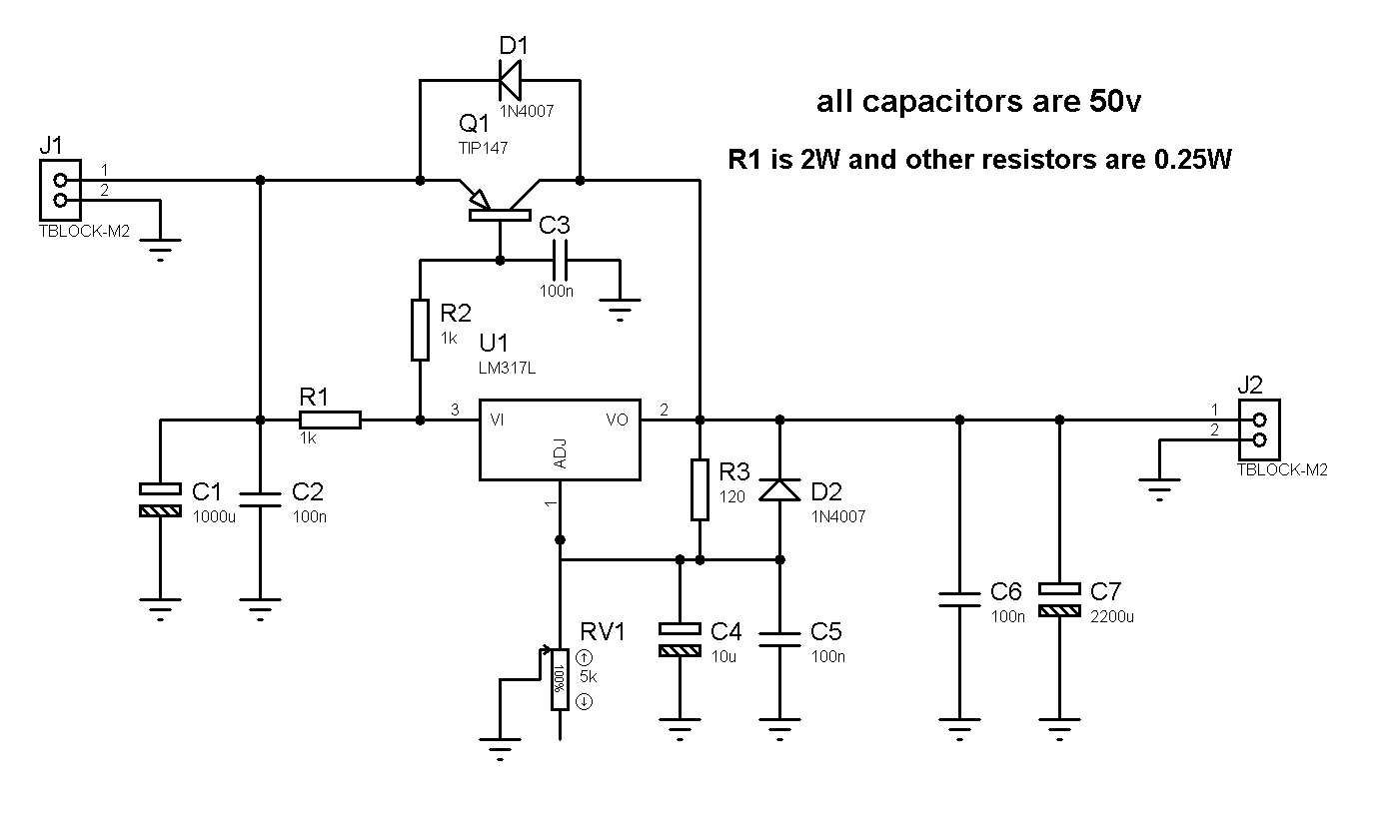 This is very simple 1.2 - 36V adjustable bench power supply with 5A of output current. Max input voltage is 37V and output is adjustable via potentiometer between 1.2 up to 36 volts. TIP147 PNP darlington transistor boosts the current of LM317 from 100mA to 5A. LM317 is the most useful and inexpensive adjustable regulator and for this circuit you can also use LM317L that can give 100mA, that's enough for transistor bias. D1 and D2 are protection diodes because when you turn the circuit off the output capacitors are discharging and can damage the transistor or regulator. 100nf capacitors are in parallel with electrolytic capacitors to remove high frequency noise because large value electrolytic have large ESR and ESL and can't remove high frequency noise.
Posted on Wednesday, January 16, 2013 • Category: FM Transmitters
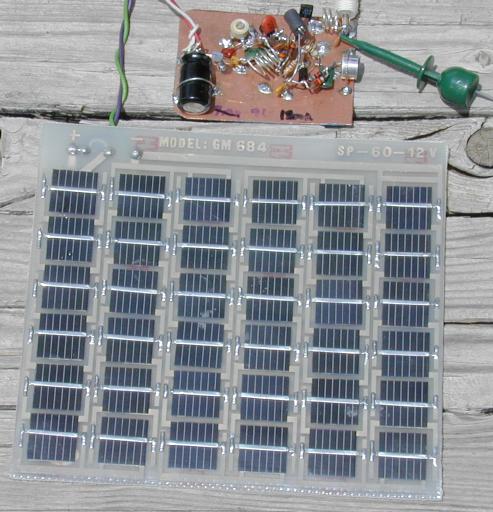 There are many miniature FM transmitter bug circuits online, this one is unique in that it runs completely on solar power. No battery is required. As long as the sun is shining on the PV panel, the transmitter will transmit. The transmitter bug is useful as a "remote ear", and can be used for anything from listening birds to surveillance work. The mic preamp and oscillator circuits were borrowed from a common circuit found around the Internet, a regulated solar power supply and an RF amp that extends the range of transmitter and improves frequency stability were added.
Posted on Sunday, January 6, 2013 • Category: Power Supplies
 12V dual power supply has symmetrical voltage output +12V and -12V with limited current to 100mA. It has been built to power three OPA627 opamps of Audio DAC I am building with PCM1792 & PCM1794 chips. Circuit has on the primary side only fuse. I couldn't find smaller than 50mA. We can connect power cord directly to the X1 connector or via power switch on the chassis. On the secondary side of transformer are connected two fuses 100mA and after them is bridge rectifier. For filtering of rectified voltage there are C1 and C2. Next are positive and negative voltage regulators 78L12 and 79L12 with decoupling capacitors C3 to C6 close to regulators. Next are small filter capacitors and also signaling LEDs connected via resistors. Output voltages are connected to 3 pin connector. For signaling of presence of voltage is enough only one LED. We can also use 2 pin connectors for LED connecting.
Posted on Sunday, December 23, 2012 • Category: FM Transmitters
 Build your own simple mini FM transmitter. This fun project will show you how to build a mini broadcasting transmitter that can transmit an audio signal up to a quarter mile to any FM receiver. It's easy to build and a good learning experience. It serves as a hands-on learning tool for students or anybody interested in electronics. Having a range of up to a quarter mile, it's great for a house security system, baby monitoring device or simply a listening gadget that you can place anywhere!
Posted on Tuesday, December 4, 2012 • Category: FM Transmitters
 The power output of many transmitter circuits are very low because no power amplifier stages are incorporated. The transmitter circuit described here has an extra RF power amplifier stage using 2N3866 RF power transistor after the oscillator stage to increase output power to 250 milliwatts. With a good matching 50-ohm ground plane antenna or multi-element Yagi antenna, this transmitter can provide reasonably good signal strength up to a distance of about 2 kilometers. Transmitter's oscillator is built around BF494 transistor T1. It is a basic low-power variable-frequency VHF oscillator. A varicap diode circuit is included to tune the frequency of the transmitter and to provide frequency modulation by audio signals. The output of the oscillator is about 50 milliwatts. 2N3866 transistor T2 forms a VHF-class A power amplifier. It boosts the oscillator signal power four to five times. Thus 250mW of power is generated at the collector of transistor T2.
Posted on Friday, November 30, 2012 • Category: Test and Measurement
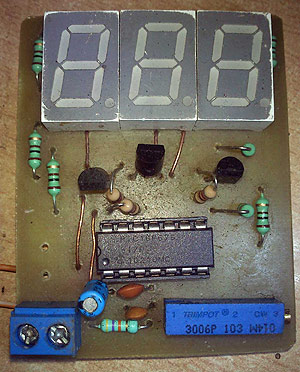 This is a simple 30V volt meter using PIC16F676 micro controller with 10-bit ADC (analog to digital converter) and three 7 segment LED displays. You can use this circuit to measure up to 30V DC. The possible applications are on bench power supply or as a digital panel meter in various systems. PIC16F676 is the heart and brain of this circuit. The internal adc of the mcu with a resistor network voltage divider is used to measure the input voltage. Then 3 digits of comm anode 7 segment display is used to display final converted voltage. As you can see in the schematic the displays are multiplexed with each other. It means we switch on one display and put the corresponding digit on this while other two displays are off this cycle goes for each of the displays.
Posted on Sunday, November 18, 2012 • Category: FM Transmitters
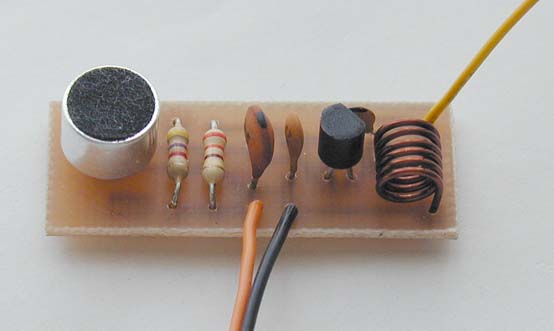 Presented FM transmitter bug is built using BF414 / BF324 / BF606 transistor. The 30cm antenna has a range of about 30m in the building, more in the open field. Power supply 2x AAA batteries have been used with voltage of 2.75 V. I added resistor 10K in parallel with 1.5pF capacitor so that the system works well when connected to an external source (mp3 player / computer). On the computer I had to reduce sound to about 35% of capacity, so that I do not have clipping. I managed to improve transmitter stability with simple shielding. The coil is 5 turns of enameled copper wire wound on 1 mm ø = 5 mm.
Posted on Wednesday, November 7, 2012 • Category: Battery Chargers
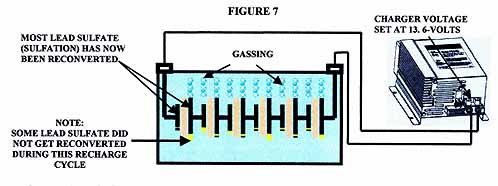 Lead Acid batteries have changed little since the 1880's although improvements in materials and manufacturing methods continue to bring improvements in energy density, life and reliability. All lead acid batteries consist of flat lead plates immersed in a pool of electrolyte. Regular water addition is required for most types of lead acid batteries although low-maintenance types come with excess electrolyte calculated to compensate for water loss during a normal lifetime.
Lead acid batteries used in the RV and Marine Industries usually consist of two 6-volt batteries in series, or a single 12-volt battery. These batteries are constructed of several single cells connected in series each cell produces approximately 2.1 volts. A six-volt battery has three single cells, which when fully charged produce an output voltage of 6.3 volts. A twelve-volt battery has six single cells in series producing a fully charged output voltage of 12.6 volts.
Posted on Friday, October 26, 2012 • Category: FM Transmitters
 BA1404 transmitter includes onboard RF amplifier for increased transmitting range. Operating voltage range is 1-3V, the circuit contains FM stereo mixer, 38KHZ oscillator, FM modulator and high-frequency amplifier monolithic integrated circuit. As the "electronic newspaper" BBS there are many users requiring detailed information on the FM stereo transmitter, so I re-collect the relevant information on the simple discrete, merge, integrated FM stereo transmitter experiment, that BA1404 with μpc1651 mix of the most easy to make and debug, and very high frequency stability (relative to the previous circuit BA1404), transmission power is increased by UPC1651RF amplifier.
Posted on Tuesday, October 16, 2012 • Category: Test and Measurement
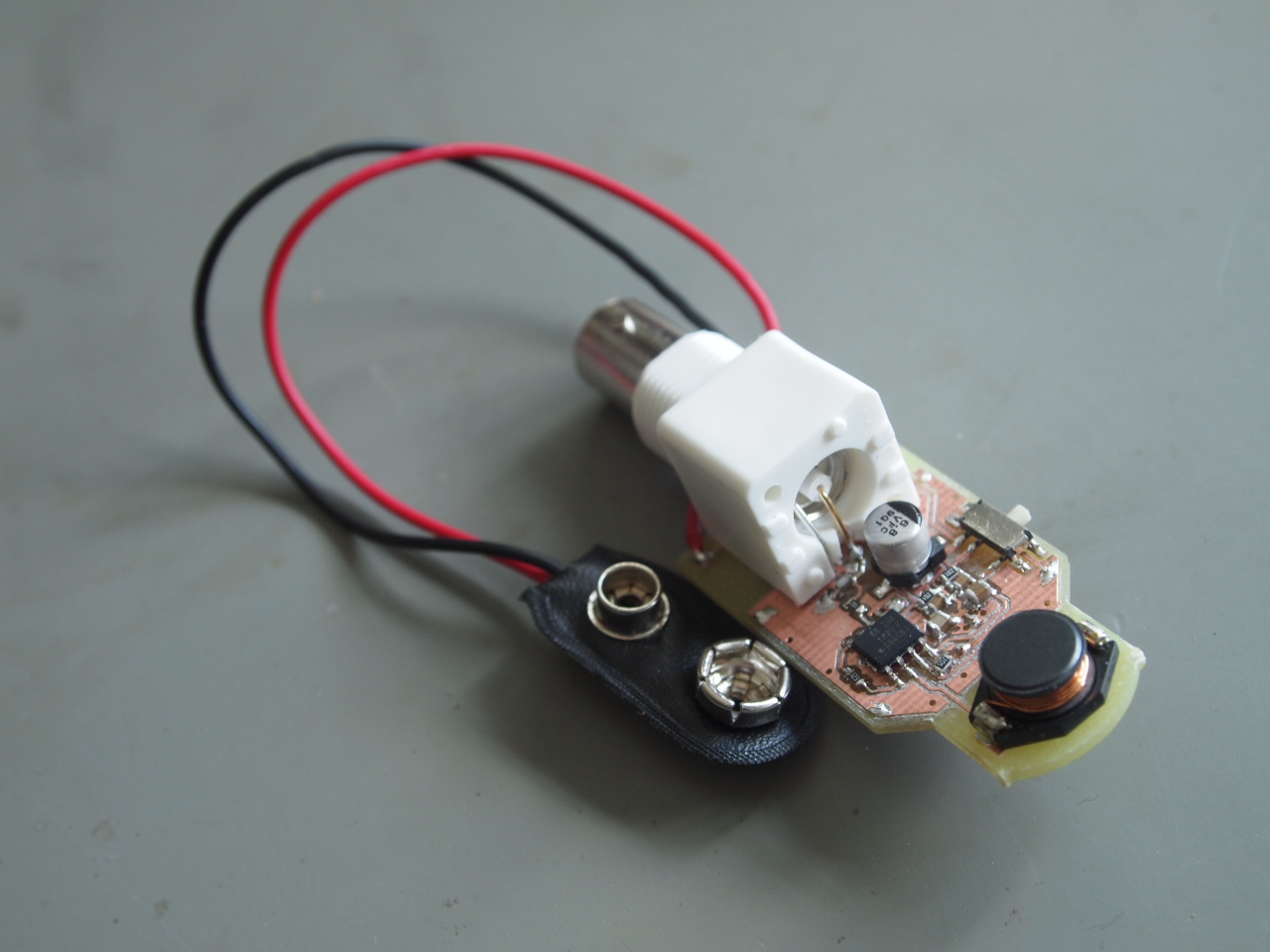 There's something fascinating about electromagnetic fields. Thanks to the modern world and the prevalence of electronics and electricity, they're all around us these days. But because of the extremely limited array of senses that we humans have, we spend most of the time completely oblivious of them. Wouldn't it be cool to make something simple that could not just detect them, but would allow you look at the waveforms on an oscilloscope. An EMF probe in other words.
Posted on Sunday, October 7, 2012 • Category: FM Transmitters
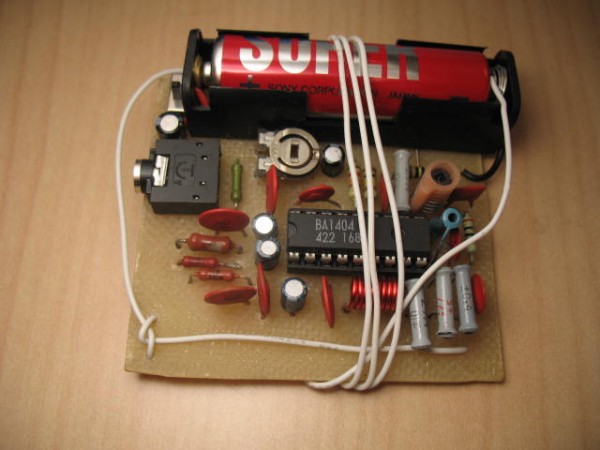 A high quality stereo FM transmitter circuit is shown here. The circuit is based on the IC BA1404 from ROHM Semiconductors. BA1404 is a monolithic FM stereo modulator that has built in stereo modulator, FM modulator, RF amplifier circuitry. BA1404 FM transmitter can be operated from 76 to 108MHz and power supply for the circuit can be anything between 1.25 to 3 volts.
Posted on Tuesday, October 2, 2012 • Category: Antennas
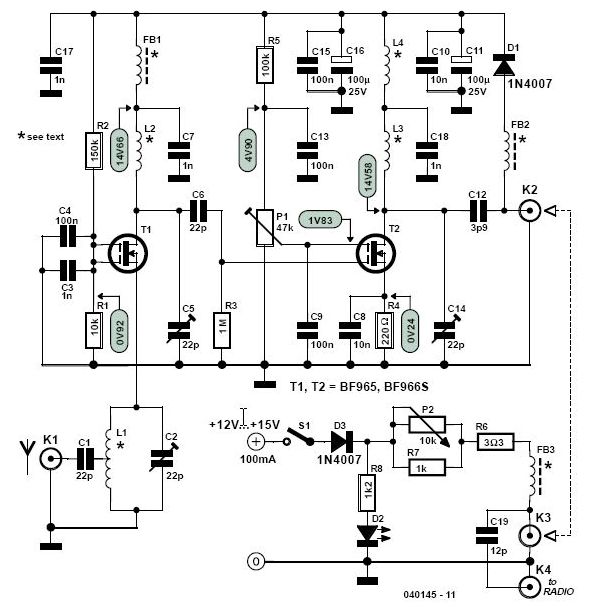 Together with a good directional antenna this high performance two-stage antenna amplifier for the VHF FM broadcast band will enable you to receive distant radio stations. VHF FM Antenna booster will also drastically improve reception of FM signals you’ve come to accept as marginal and noisy in your area. Antenna booster is also great for extending transmission range of low power VHF / FM transmitters.
Posted on Sunday, September 16, 2012 • Category: FM Transmitters
 Here is a simple USB FM transmitter that could be used to play audio files from an MP3 player or computer on a standard VHF FM radio by connecting it to an USB port. The circuit use no coils that have to be wound. This USB transmitter can be used to listen to your own music throughout your home. To keep the fm transmitter circuit simple as well as compact, it was decided to use a chip made by Maxim Integrated Products, the MAX2606. This IC from the MAX2605-MAX2609 series has been specifically designed for low-noise RF applications with a fixed frequency. The VCO (Voltage Controlled Oscillator) in this IC uses a Colpitts oscillator circuit. The variable-capacitance (varicap) diode and feedback capacitors for the tuning have also been integrated on this chip, so that you only need an external inductor to fix the central oscillator frequency.
Posted on Monday, August 20, 2012 • Category: FM Transmitters
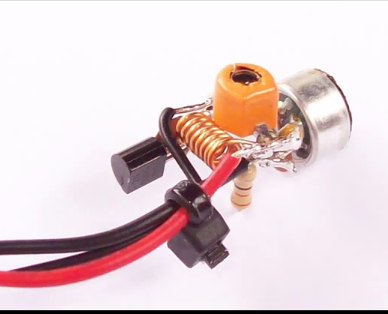 This easy to build FM transmitter bug can transmit voice to exceptionally good range. Tune trimmer to hear the signal to your near radio. Transmitter frequency range is 88-108 MHz. Max current consumption is 30mA. You can power the fm transmitter bug with a 9Volt Battery, or you can plug a power supply to feed in 9-12 Volts. That bug will pick even a low whisper or even the sound of a breath well far from the microphone. Great spy transmitter equipment.
Posted on Saturday, June 23, 2012 • Category: FM Transmitters
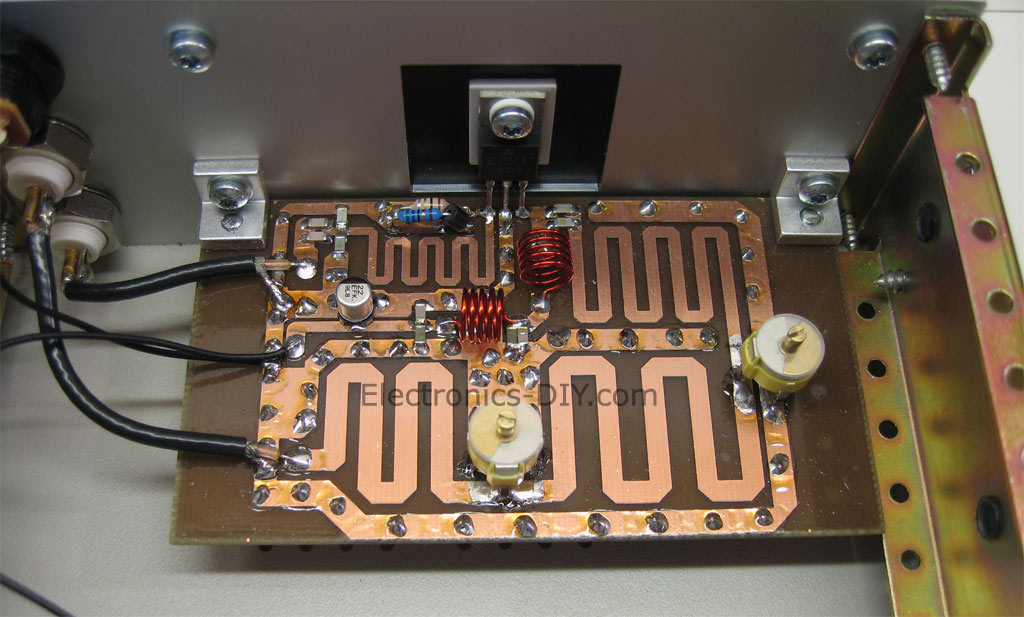 After building FM transmitter I decided to build a 6W RF Transmitter amplifier for the FM band to get more power and we chose to copy a 6 Watt design built around 2SC1971 RF power transistor. We were not satisfied with finished result and decided to replace the fixed capacitors around the pcb inductors with variable capacitors, this is much better and possible to tune to your transmitter frequency.
Posted on Friday, June 15, 2012 • Category: Antennas
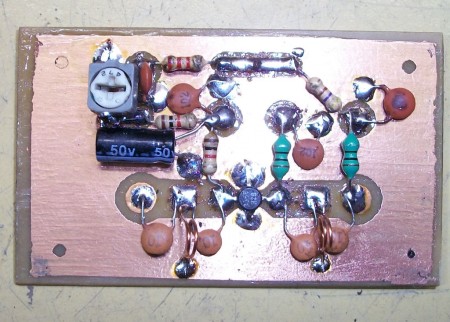 This HD TV UHF wideband amplifier(Ultra High Frequency amplifier) has a total gain of 10 to 15 dB in the 400 – 850 MHz domain frequency so it can be used where the tv signal is weak.
For this UHF antenna tv amplifier to work correctly you need to cut the components pins as short as possible. C1, C2, C6, C7 are SMD type ( surface mounted ). This antenna tv amplifier or uhf wideband amplifier need to be build inside of a metal box and then connected close to the tv antenna.
Posted on Sunday, June 10, 2012 • Category: Amplifiers
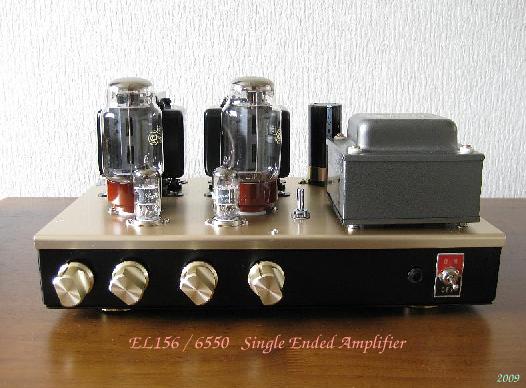 Single Ended Valve Triode Amplifier has not same tone with Push Psu Amplifier. Over 90% of Amplifiers are push pull, and push pull amplifier does not 2nd harmonic and off course
does not get 2nd 4th, 6th harmonic vs SE has 2nd, 4th, 6th harmonic. Push pull has minor distortion than SE Amplifier.2nd harmonic is make good tone for Music.not too much and not less than.feel good sound get from Single Ended Amplifiers with high efficiency speakers from 88dB/m to 100dB/m. I means Single Ended Amplifier
is almost Single Ended Triode Amplifier.or Penthode but wired Triode. Tone is Different.good for Jazz and
small room Classic.
Posted on Friday, June 8, 2012 • Category: FM Transmitters
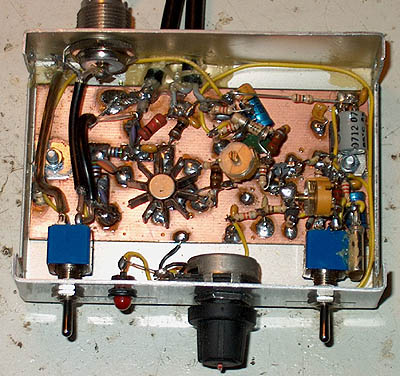 The 1 watt 20 meter QRP transmitter with VXO. This is a nice QRP transmitter that can be used in combination of one of the simple receivers.
Normally these designs have only two transistors: one is the X-tal oscillator and the second the final amplifier. A good example is my first QRP rig that is also described somewhere on this site. Here the VXO (Variabele X-tal Oscillator) has a tuning range of 16 kHz. This VXO is buffered with an extra driver stage for a better frequency stability and a varicap diode is used instead of a variabele capacitor. An extra transistor is added for keying the transmitter with a low keying current.
What you can do with such a simple 1 watt QRP power transmitter.
This is a real low power transmitter, so do not expect that you can do everything with it but...
When conditions are normal, you can easily make many QSO's during one afternoon with stations with distances upto 2000 km with a simple inverted V wire dipole antenna! From Europe, I did even make QSO's across the Ocean!
Posted on Tuesday, May 29, 2012 • Category: FM Transmitters
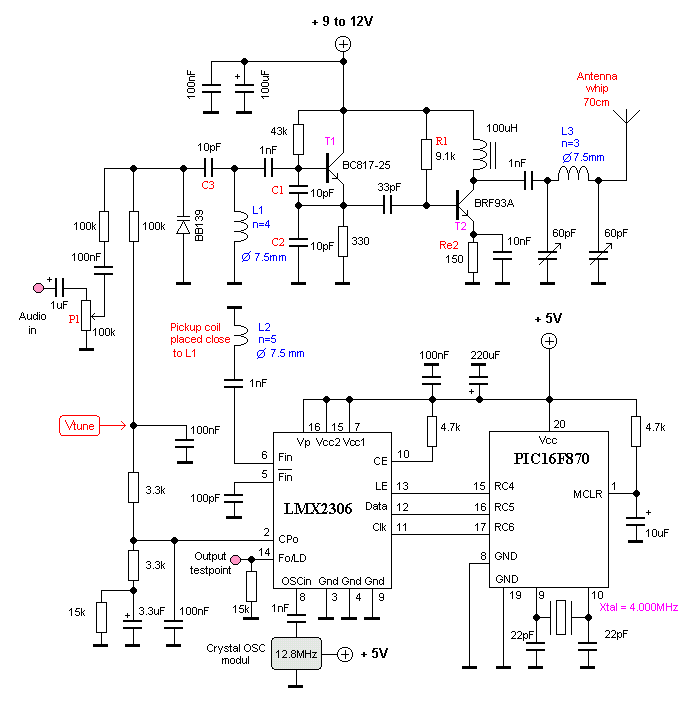 This PLL transmitter is controlled and the frequency is very stable and can be programmed digitally. Transmitter will work 88-108 MHz and output power up to 500mW. With a small change can set the frequency of 50-150 MHz. The output power is often set to several watts with transistors. So therefore I decided to build a simple transmitter with great performances. The frequency of this transmitter can easily be changed by software and space / compress air coil. This transmitter is the oscillator colpitts. Oscillator is a VCO (voltage controlled oscillator) which is set by the PLL circuit and PIC micro controller. This oscillator is called the Colpitts oscillator and voltage controlled to achieve the FM (frequency modulation) and PLL control.
Posted on Wednesday, May 23, 2012 • Category: Test and Measurement
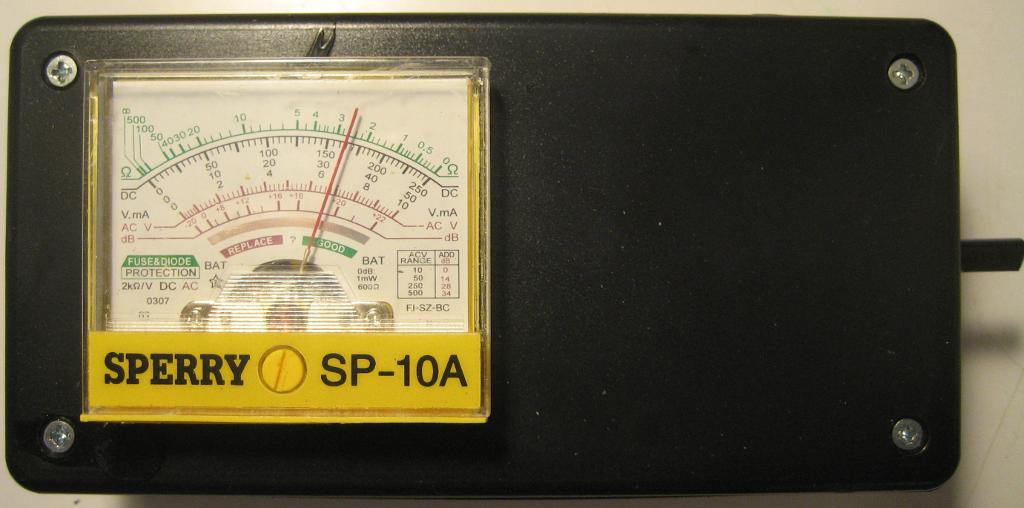 Field strength meter is extremely useful when working with RF devices. It can be used to quickly diagnose whether a transmitter circuit is working, and can be used to detect RF signals in the environment. The simplest field strength meter could be built with a tuned LC circuit and a germanium diode, just like the way of a building a crystal radio except replacing the ear piece with a high sensitivity current meter. While this approach fits the needs of most simple applications, it has a pretty narrow frequency range (~100 MHz) and requires tuning the LC circuit to the correct frequency before measurements can be made and the design can become complicated if wider frequency range tuning is desired.
Posted on Monday, May 21, 2012 • Category: Power Supplies
 An 50v bench power supply can be made using electronic diagram below which is designed using LM10 op amp and 2n3055 transistors. This LM10 2n3055 50v bench power supply allows an output voltage regulation in a range between 0 and 50 volts and the output current can be limited to a maximum of 2A. Output voltage increases linearly with the amount of resistance potentiometer P1, while the current can be adjusted linear using potentiometer P3. Potentiometer P2 serves to regulate maximum output current (maximum value is 2A).
Posted on Wednesday, May 16, 2012 • Category: Amplifiers
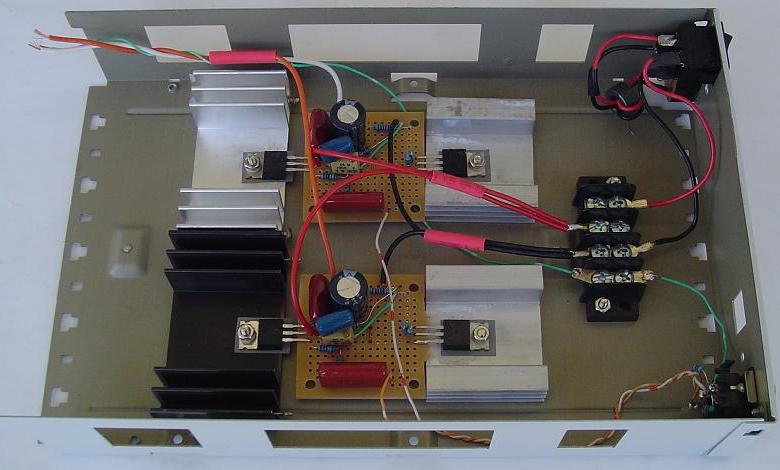 Not thrilled with how a computer soundcard drove my 32ohm headphones so I decided to build myself class-A mosfet headphone amplifier. As with most of my projects, the goal was to keep it simple, keep cost down and try use some salvaged parts. This is a simple do-it-yourself (DIY) headphone amplifier project that is fashioned primarily after the Class A MOSFET Headphone Driver project by Greg Szekeres and to some extent Mark's DIY Class A 2SK1058 MOSFET Amplifier Project. The amplifier concept is simple and follows a typical single-ended class A circuit utilizing an active constant current source (CCS) in place of a passive resistor. A CCS doubles the efficiency of the circuit over that where a passive load resistor is used, bringing it to a maximum of 25%.
Posted on Sunday, May 13, 2012 • Category: Power Supplies
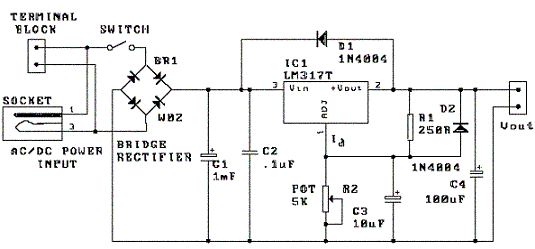 This is a basic universal variable Power Supply voltage regulator circuit using an LM317, 3-terminal regulator in a TO-220package. The Universal Power Supply output voltage can be set to anywhere in the range 1.5V to 30V by selecting two resistances. By using a potentiometer, R2, as one of the resistors you can dial up the output voltage wanted. Either AC or DC input can be supplied to the PCB via a socket or terminal block. Connection can be either way around. This is because we have provided a bridge rectifier on board. The input DC voltage to the regulator must be at least 2.5V above the required output voltage. An off/on switch is provided.
For many applications (say 12V at 60mA) a heat sink will not be necessary. The LM317 will provide slightly higher output voltages than 30 volts. However, for most hobbyists over 30V will not be needed. So to make a small PCB we have used some electrolytic capacitors rated to 35 volts. To be safe for continuous operation the maximun input DC voltage to the regulator should not be over 33V. With a 2.5V to 3.0V drop across the regulator this will give a regulated output of 30V. You can draw up to 1.5A from the LM317. If you need higher then use an LM338T rated to 5A.
Posted on Tuesday, May 8, 2012 • Category: Amplifiers
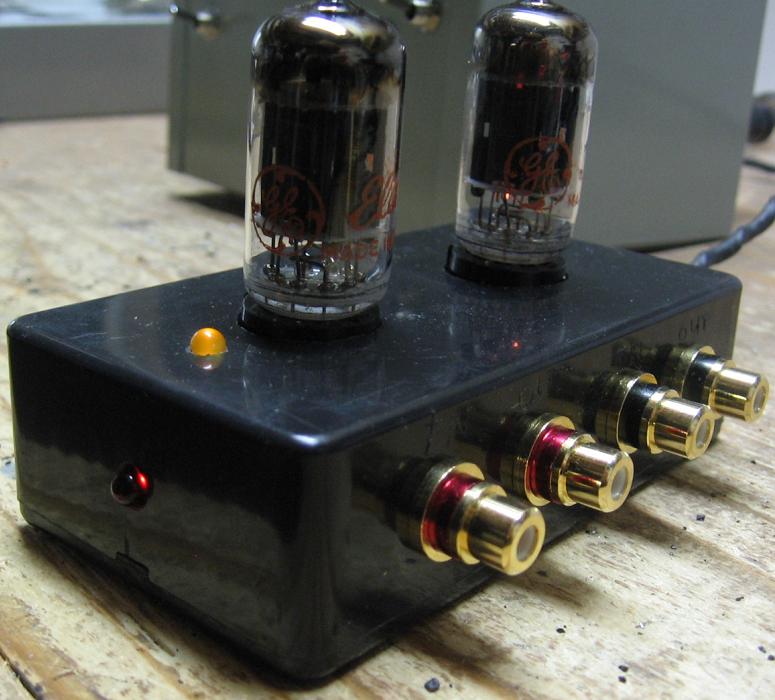 I'm not sure what motivated me to decide on building a high-gain tube preamp of this sort. Maybe it was the tube computer sound card idea I have seen, or the fact that I have enough junk to fill a dump truck. What ever it was, it all started with a cute little plastic Hammond enclosure that had been on my shelf for a couple of years. I originally thought I might use it for a tube headphone amp, but in the end realized there would not be enough space for the three tubes needed to make a head amp. This is a high gain preamplifier that is suitable for use where a lot of gain is required - to drive a power amplifier that needs plenty of gain or perhaps for use with instruments, like a guitar or microphone. If you need less gain, take a look at the RCA 12AU7 / ECC82 Cathode Follower Tube Preamp Schematic which has a gain of about 8.
Posted on Wednesday, May 2, 2012 • Category: FM Transmitters
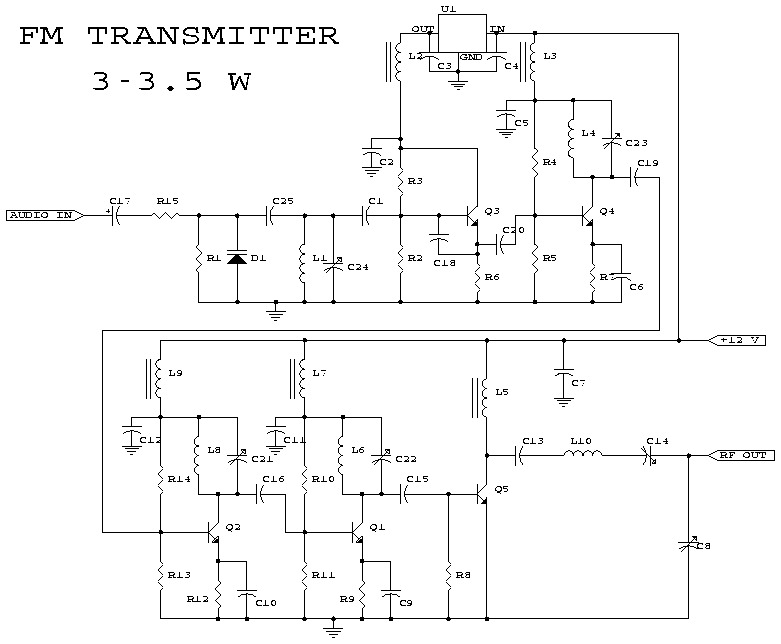 This is the schematic for an FM transmitter with 3 to 3.5 W output power that can be used between 90 and 110 MHz. Stability of this transmitter is not bad and PLL circuit can be added on.
This is a circuit that I've build a few years ago for a friend, who used it in combination with the BLY88 amplifier to obtain 20 W output power. From the notes that I made at the original schematic, it worked fine with a SWR of 1 : 1.05 (quite normal at my place with my antenna).
Posted on Friday, April 27, 2012 • Category: Headphone Amplifiers
 This is simple to build audiophile class-A tube headphone amplifier. It is based around 12AU7 / ECC82 audiophile vacuum tube that provides warm, rich and smooth sound expected from audiophile amplifiers. The 12AU7 (ECC82) is a Twin Triode vacuum tube, it is very popular in the audio world because it is rather rugged and can be operated at lower voltages. Headphone amplifier and 12AU7 tube is powered by just 12V DC voltage. This is great news for those new to vacuum tubes that want experience and learn more about them. Typically vacuum tubes operate at high and dangerous voltages so you must have some experience and know what you are doing. On the other hand this headphone amplifier operates at low 12V voltage so it is safe to build and experiment.
Posted on Monday, April 16, 2012 • Category: Headphone Amplifiers
 Simple Hybrid Headphone Amplifier DIY Audio Project. Rogers has put together a very simple hybrid headphone amplifier. The head amp uses a 12AU7/ECC82 vacuum tube for voltage gain stage and a IRF612 MOSFET follower biased in Class A with a passive CCS. What is nice about the project is that both the tube and MOSFET operate off of a 24V external switch mode power supply. Read on for more details about 12AU7 Tube / IRF610 MOSFET Hybrid Headphone Amplifier.
Posted on Sunday, April 15, 2012 • Category: Headphone Amplifiers
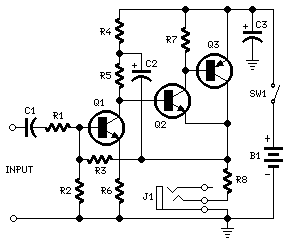 Portable Headphone Amplifier powered by just 3 Volts.
Notes:
* Can be directly connected to CD players, tuners and tape recorders.
* Tested with several headphone models of different impedance: 32, 100, 245, 300, 600 & 2000 Ohm.
* Schematic shows left channel only.
* B1, SW1, J1 & C3 are common to both channels.
* R3 value was calculated for headphone impedance up to 300 Ohm. Using 600 Ohm loads or higher, change R3 value to 100K.
Posted on Tuesday, April 10, 2012 • Category: Amplifiers
 This Class-A Push-Pull Tube Power Amplifier uses a Pair of Push-Pull Class A, Ultra Linear Mono Block Tube Amplifiers that can be used with several different vacuum tubes including KT77 / 6L6GC / KT88 with a 12SL7 driver and 6NO30 tubes. The amplifier stage is based on the Compact Hi-Fi Power Amplifier. One thing about DIY audio is that it is a journey, not a destination, it never ends. One project leads to another. The only limits are time and money. DIY audio is a lot about perfection. While I was quite happy with my previous tube amplifier projects, I felt there was room to improve (here comes the journey again). I like to be involved in the music. If anything sticks out, it will degrade the experience. So I tend to like smooth response, lots of detail, wide soundstage and full spectrum of sound. These amps deliver all that in quantity. Regardless of what tubes I used for outputs, the sound is "silky" and refined.
Posted on Sunday, April 1, 2012 • Category: FM Transmitters
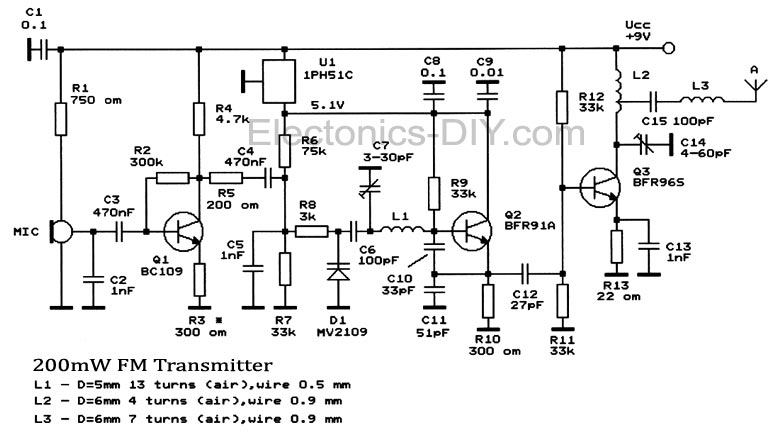 A simple 200mW FM Transmitter circuit which covers frequencies from 88 to 108 MHz. It is built with 3 transistors: BC109, BFR91A and BFR96S. It is quite stable and the output power is around 200mW.
The first stage of transmitter is a mic amplifier but if you connect this radio transmitter directly to an audio source you can remove this stage and connect the audio signal to R5.
U1, 1PH51C can be replaced with LM7805. You must use a stabilized power source for oscillator stage to prevent frequency variation. You can remove C7 and use a linear potentiometer instead of R6 with the median connector to C4, one pin to ground and the other one to +. FM Transmitter uses MV2109 varicap diode and C7 for frequency tuning.
Posted on Saturday, March 31, 2012 • Category: Amplifiers
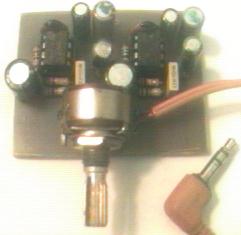 A general purpose audio power amplifier is a must have for the electronics amateur. It's not a good thing to use your HiFi set for an experiment, when there's a risk of blowing it's transistor out. Amplifier for your experiments should be simple in construction, durable, and easy to repair. Also a portable, low power consumption and battery powered.
Taking the considerations above, I gave you the PCB design for the TBA820M based amplifier. It is rated for 2Watts of RMS power output (16W PMPO) but gives even two times more if you cool it well by some tricks. I've been using this circuit for over ten years and personally still surprised by it's durability, thinking of how many short circuits and overdrives it is subjected.
Posted on Friday, March 23, 2012 • Category: Test and Measurement
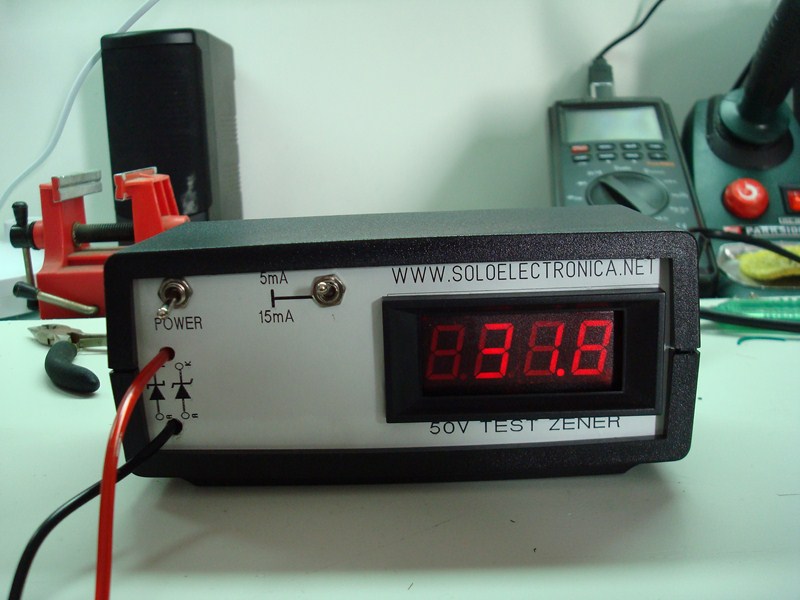 Presented here is zener diode meter for testing voltage value of an unknown zener diode. The zener diode or diode voltage regulator is a special diode, Unlike normal diodes these diodes are intended to work in the breakdown voltage and an essential part of the voltage regulator circuits.
These components maintain constant voltage at its terminals suffer variations even when substantial current, its connection with reverse bias is normal also to work in the zener voltage of the source Vs must be greater than the rupture Vz, as always condition using a resistance Rs in series to limit current to a value always less than its maximum power.
Posted on Tuesday, March 20, 2012 • Category: FM Transmitters
 The RF oscillator using the inverter N2 and 10.7Mhz ceramic filter is driving the parallel combination of N4 to N6 through N3.Since these inverters are in parallel the output impedance will be low so that it can directly drive an aerial of 1/4th wavelength. Since the output of N4-N6 is square wave there will be a lot of harmonics in it. The 9th harmonics of 10.7Mhz (96.3Mhz) will hence be at the center of the FM band. N1 is working as an audio amplifier. The audio signals from the microphone are amplified and fed to the varicap diode. The signal varies the capacitance of the varicap and hence varies the oscillator frequency which produce Frequency Modulation.
Posted on Monday, February 20, 2012 • Category: Power Supplies
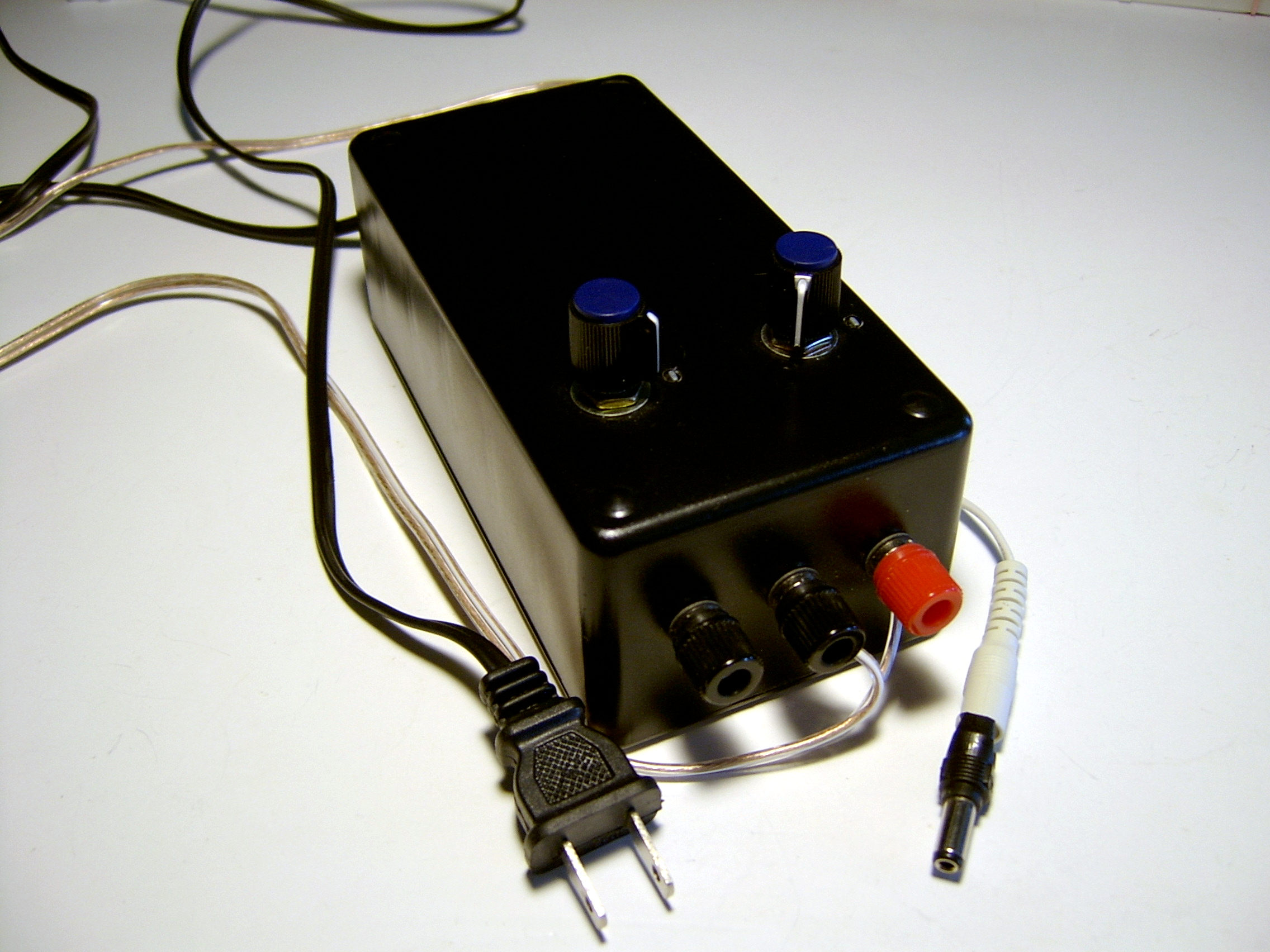 Split power supply provides a stable regulated bipolar voltage in the range ±1.5V to ±17V. It is based on LM317/LM337 linear voltage regulators that also have a short circuit protection. Most parts are easily accessible, including a 6"x3"x2" project box, 12V 1.2A center tap transformer, pots, knobs, etc. Power supply schematic shows how to wire LM317/LM337 to get +/- split voltage output.
Posted on Wednesday, February 15, 2012 • Category: FM Transmitters
 With this circuit you can build a very small tracking transmitter that can be tracked using a FM broadcast band radio receiver. The transmitter can be powered from any 1.5V volt battery or power supply. Transmitter has a range up to 1 mile depending on battery voltage, height above ground, receiver sensitivity, and antenna length. Under certain conditions distances of 1 mile have been achieved. It is recommended that this transmitter be used with FM radios that can tune continuously across the dial. The better the receiver and receiver antenna system the greater the practical range of the transmitter, however good functionality can be achieved with the least expensive radios and using only the standard telescoping antenna included with most radios.
Posted on Tuesday, February 14, 2012 • Category: Battery Chargers
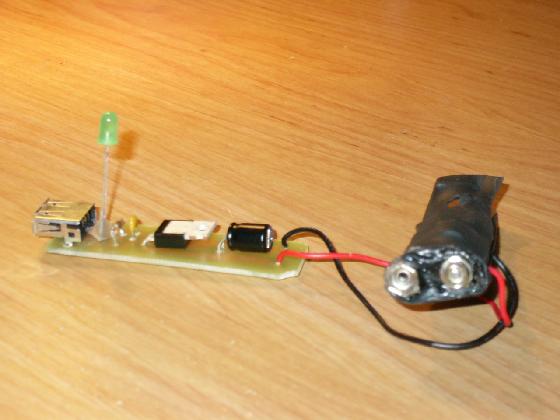 Portable USB Charger is a device that will charge things like Ipods, PDAs, that accepts charge from a USB port. It runs off a 9-V battery, and through the simple circuit, out comes a regulated 5-V perfect for a USB port. Portable USB chargers will always be handy, lets face it these days every gadget around us has USB charging capabilities. This is a very basic and simple project, and cheap too. Maybe its time for you to build your own diy portable USB charger.
Posted on Tuesday, February 7, 2012 • Category: FM Transmitters
 Here's BH1417 USB FM Transmitter with built-in PLL circuit. Its low-frequency signal is converted into high-frequency, which can take any audio device with FM radio (stereo, car CD, MP3, DVD player, etc.), as a normal radio station. Transmitter power is sufficient for reliable reception of its signal within a few tens of meters. The basis of the device is a chip BH1417F, included in a typical scheme. This device contains all the necessary circuitry to generate a composite stereo signal c of the pilot tone, the RF generator with PLL and power amplifier. A detailed description is given in.
Posted on Wednesday, February 1, 2012 • Category: FM Transmitters
 Here's a long range 300mW FM Transmitter for the 88MHz to 108MHz band. This particular TX is of special interest to those wishing to build low power Power Amplifiers for the VHF bands since it used impedance matching, power amplifier and antenna filtering, all of which should be used by radio constructors, whether it be for amateur radio or any other form of radio. The features of this project are: Higher output power - 150mW min (at 9v) and 300mW+ (at 12.5v). Very pure output signal due to careful design and filtering. VARICAP modulation - possibility to add a synthesizer. Single sided Printed Circuit Board, only 40mm x 72mm. Covers the domestic FM band - 88MHz to 108MHz. Easy to build, but coil winding experience IS required
Posted on Tuesday, January 24, 2012 • Category: LED
 Here is a circuit for simulating breathing / pulsing LED with the 555 timer chip. It became very popular and i received many comments and emails with people that made this circuit and worked fine, as well as comments with people that had troubles converting it to operate at 12 volts supply. It was designed to operate with 5 volts, because i plan to use it for a future PC mod. Since the PC power supply has 5 volts output, and since the LEDs that i plan to use require 3.8 volts to operate, choosing 5 volts for supply was the best choice to minimize power dissipation on the transistor.
Posted on Tuesday, January 17, 2012 • Category: FM Transmitters
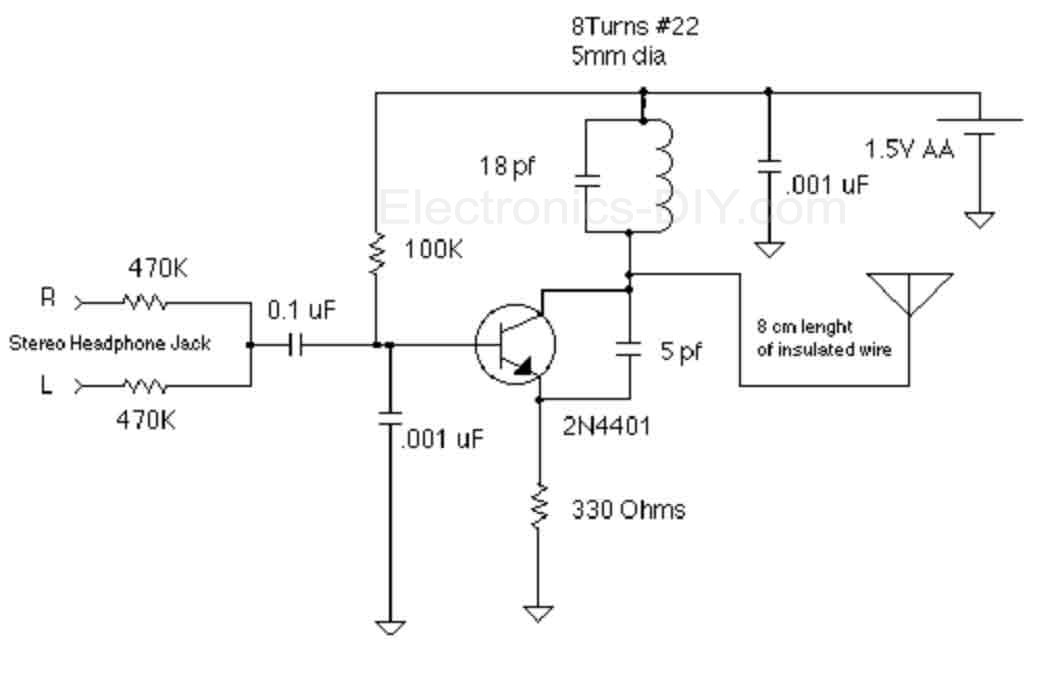 The objective of this 1.5V FM Broadcast Transmitter design is to provide a simple low-power transmitter solution for broadcasting audio from various audio sources. This transmitter accepts stereo input via two 470K resistors. Since there is no audio level control on the input, the audio level out from the source needs to be adjusted. Or, you can just add a 10k as an input level control. Transmitter's frequency, as built is tunable via spreading or compressing the coil to the desired frequency, and the coil can be glued down. If you want to make one that's tunable, it might be easiest to reduce the 18 pf capacitor and put a small trimmer capacitor in parallel with the inductor (across the reduced value capacitor). Voltage variable capacitors would be an nice alternative to a mechanical variable capacitor but they don't offer much tuning range with only a 1.5V power supply.
Posted on Sunday, January 8, 2012 • Category: FM Transmitters
 This FM Broadcast Transmitter circuit will transmit a continuous audio tone on the FM broadcast band (88-108 MHz) which could used for remote control or security purposes. Circuit draws about 30 mA from a 6-9 volt battery and can be received to about 100 yards. A 555 timer is used to produce the tone (about 600 Hz) which frequency modulates a Hartley oscillator. A second JFET transistor buffer stage is used to isolate the oscillator from the antenna so that the antenna position and length has less effect on the frequency. Fine frequency adjustment can be made by adjusting the 200 ohm resistor in series with the battery. Oscillator frequency is set by a 5 turn tapped inductor and 13 pF capacitor.
Posted on Wednesday, January 4, 2012 • Category: TV Transmitters
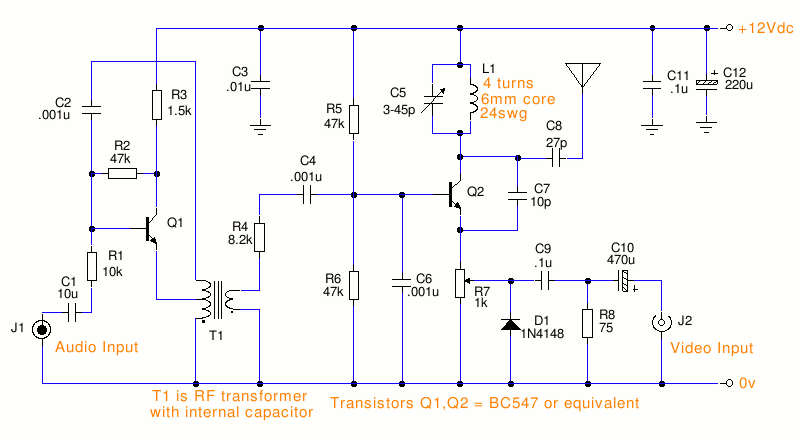 This is a small TV transmitter circuit which transmits in VHF band, negative sound modulation and PAL video modulation. It is suitable in countries where the B and G system is used.
Posted on Tuesday, January 3, 2012 • Category: Test and Measurement
 RF laboratory often requires capacitance meter for small capacitors in pF range. Such a device can easily be built by yourself. Here, a measurement converter for PC serial port is presented. The frequency of an oscillator is reduced by the target and measured on a PC. The appropriate conversion then allows the direct display of the capacity. The input uses a short and low capacitance probe tip. The opposite pole is clamped to ground cable with a crocodile.
The NE555 precision timer receives its operating voltage directly from the serial interface and produces a measurement object without C is a square wave with a frequency of 3.5 kHz. The signal is processed via the CTS input of the interface.
Posted on Saturday, December 31, 2011 • Category: Test and Measurement
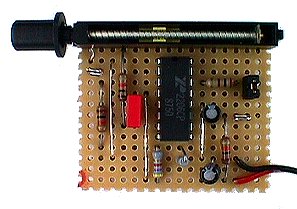 For measurement purposes in the electronics laboratory is needed again and again signals of different frequency and waveforms. A common function generator provides sine, for example, triangular and square waves. The frequency must be adjustable and at least cover the low frequency range.
The low-cost IC XR2206 provides a very simple function generator with only a few external components. XR2206 data sheet provides complete basic circuit for a simple function generator. It requires an operating voltage of 12 V and delivers sine and square wave signals. Instead of the sine wave output is obtained after opening of S1 a triangular output wave. XR2206 IC contains an internal VCO (Voltage Controlled Oscillator, Voltage Controlled Oscillator) with triangular and rectangular output. The capacitor C and the power to determine the frequency at pin 7. With a pot of 2 megohms and a fixed resistor of 1 kOhm variation gives a ratio of 1 to 2000 and may include a range of 10 Hz to 20 kHz sweep.
Posted on Friday, December 30, 2011 • Category: FM Transmitters
 Here is a very simple telephone broadcaster transmitter which can be used to eavesdrop on a telephone conversation. The circuit can also be used as a wireless telephone amplifier.
One important feature of this phone transmitter is that the circuit derives its power directly from the active telephone lines, and thus avoids use of any external battery or other power supplies.
Posted on Wednesday, December 28, 2011 • Category: FM Transmitters
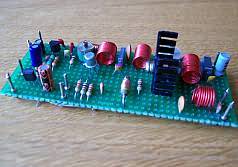 In this project, you will make a simple 3-stage low-power broadcast-type circuit, using a crystal oscillator integrated circuit and an a collector modulated AM oscillator with amplifier. You can connect the circuit to the an electred microphone or amplified dynamic microphone. Using an electred microphone is shown (in gray) in the diagram below. (no amplified dynamic microphone has a to low output voltage to work. at least 100mv is needed). You could also add a LF preamp stage of one transistor to allow connecting a dynamic microphone directly.
You'll see that you can receive the signal through the air with almost any AM radio receiver. Although the circuits used in radio stations for AM receiving are far more complicated, this nevertheless gives a basic idea of the concept behind a principle transmitter. Plus it is a lot of fun when you actually have it working!
Remember that transmitting on the 10 meter band you'll need a valid radioamateur license!!
A wide range of different circuits have been used for AM, but one of the simplest circuits uses collector modulation applied via (for example) a transformer, while it is perfectly possible to create good designs using solid-state electronics as I applied here (T1 BC557).
The transmitter is build as a Colpitts Oscillator with a BSX20 transistor. HF-output of the oscillator is approx. 50 mW, depending on the supply voltage of 6 to 15 Volts. This is amplified by the BD135 and brings the power up to approx. 1 watt @ 12volts. The transmit frequency is stabilized with the 28Mhz crystal. A slight detuning of approx 1kc is possible when using a 120pF trimmer capacitor for C8. The oscillator signal is taken from the collector of T2 and guided to the input of T3 which output is lead via an L-filter and low-pass PII filter circuit cleaning up the signal pretty good and ensuring spectral purity. The oscillator is keyed by T1 and the morse key (S). By keying the morse-key T1 is not been used for modulation and is biased, hence lets T2 freely oscillate.
Posted on Friday, December 23, 2011 • Category: AC / DC Innveters
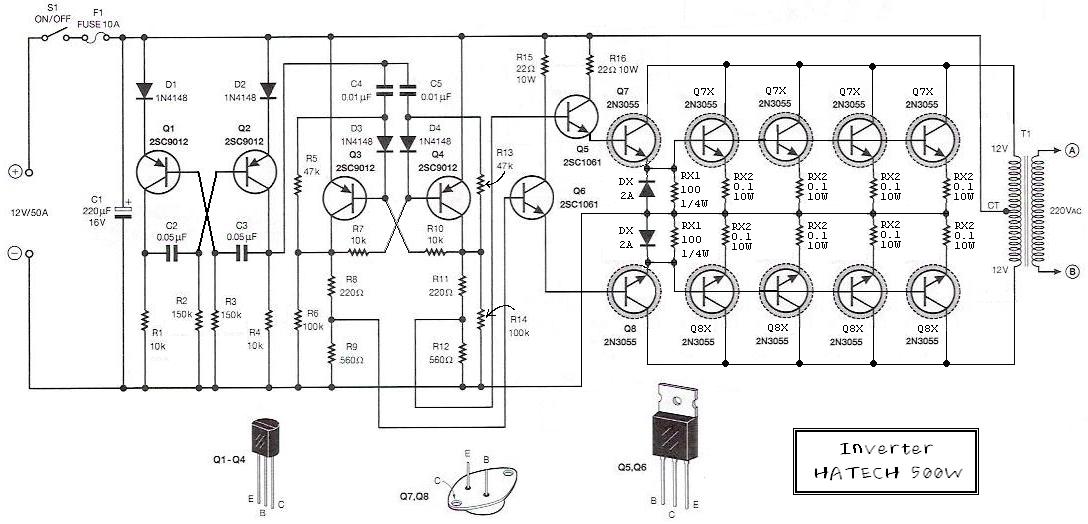 This is a 500W DC-to-AC inverter circuit diagram which produces an AC output at line frequency and voltage. 12VDC to 220V 50Hz inverter circuit will power 220V or 110V appliances from 12V car battery. The circuit is easy to make and is low cost. Use proper transformer. The output (in watts) is up to you by selecting different power rating transformer and power transistor rating. If you load electronic device which require 120V AC, then use transformer with 120V in output.
Posted on Monday, December 19, 2011 • Category: PIC
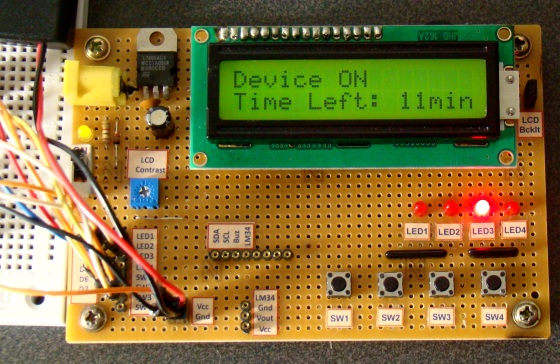 Here is 0 to 99 minutes relay timer using PIC16F628 microcontroller and 16 character LCD display. The microcontroller is PIC16F628A running at 4.0 MHz clock using an external crystal. An HD44780 based 16×2 character LCD is the main display unit of the project where you can watch and set the timer duration using tact switch inputs. There are three tact switches connected to RB0 (Start/Stop), RB1 (Unit), and RB2 (Ten) pins. You can select the timer interval from 0-99 min using Unit and Ten minute switches. The Start/Stop switch is for toggling the timer ON and OFF. When the timer gets ON, a logic high signal appears on the RA3 pin, which can be used to switch on a Relay. The circuit diagram of this project is described below.
Posted on Thursday, December 15, 2011 • Category: FM Transmitters
 This small FM transmitter with a range of about 50 meters designed for hoby. With lots of mini-transmitters then you have a comprehensive, action-packed radio program. Due to the power supply via the USB port of a high frequency stability is achieved. Alternatively, the receiver, a battery 5 to 12 volts to operate.
Posted on Monday, December 12, 2011 • Category: Sensors
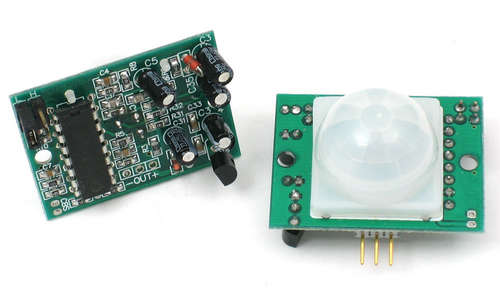 Presented schematic shows how to build simple PIR motion detector sensor. PIR sensors allow you to sense motion, almost always used to detect whether a human has moved in or out of the sensors range. They are small, inexpensive, low-power, easy to use and don't wear out. For that reason they are commonly found in appliances and gadgets used in homes or businesses. They are often referred to as PIR, "Passive Infrared", "Pyroelectric", or "IR motion" sensors.
PIRs are basically made of a pyroelectric sensor (which you can see above as the round metal can with a rectangular crystal in the center), which can detect levels of infrared radiation. Everything emits some low level radiation, and the hotter something is, the more radiation is emitted. The sensor in a motion detector is actually split in two halves. The reason for that is that we are looking to detect motion (change) not average IR levels. The two halves are wired up so that they cancel each other out. If one half sees more or less IR radiation than the other, the output will swing high or low.
Posted on Tuesday, December 6, 2011 • Category: FM Transmitters
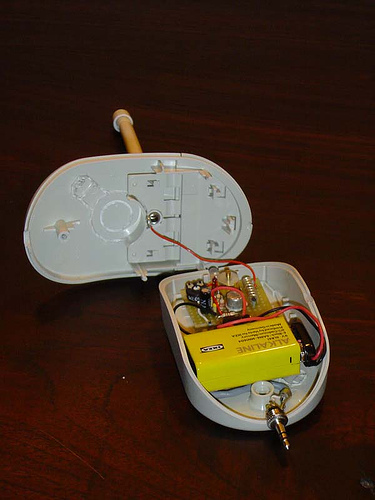 Here are instructions for building your own ipod FM radio transmitter. It works quite easy, there is a power switch on the bottom to turn it on and tune your radio and transmitter to the right frequency. For the antenna you can use a copper wire of 70 cm. The range of this FM transmitter is about 100 to 150 meters (500 feet). With R5 you can adjust the input signal and with C6 you can tune your frequency. Transmitter is supplied by 9V battery.
Posted on Friday, December 2, 2011 • Category: FM Transmitters
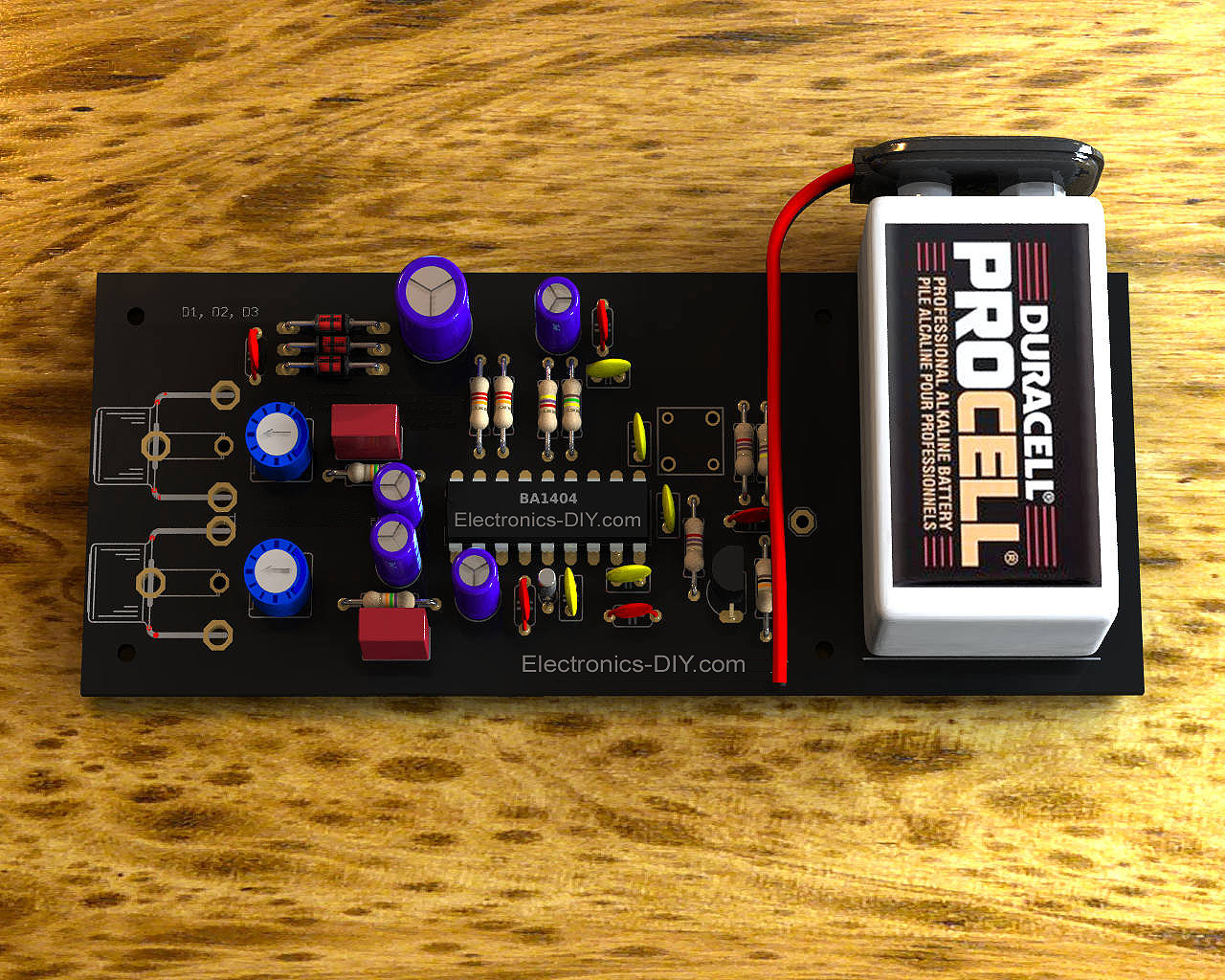 With this Stereo FM Transmitter with BA1404 you will be able to create a mini stereo FM station and broadcast to your entire home, a simple way to have an audio link wireless with ease. With the FM transmitter BA1404 Hifi Stereo you can stream your music from your iPod MP3, satellite receiver, computer, DVD player, Mobile Phone, MP4 player and MP3 and other audio source directly to an FM receiver with crystal clear sound.
Posted on Monday, November 28, 2011 • Category: Amplifiers
 LM3886 power amplifier with 150W audio output power. Three LM3886 amplifiers are bridged together to achieve 150W. Power supply is +/- 30V. LM3886 amplifier maintains an excellent signal-to-noise ratio of greater than 92dB with a typical low noise floor of 2.0µV. It exhibits extremely low THD+N values of 0.03% at the rated output into the rated load over the audio spectrum, and provides excellent linearity with an IMD (SMPTE) typical rating of 0.004%
Posted on Friday, November 18, 2011 • Category: FM Transmitters
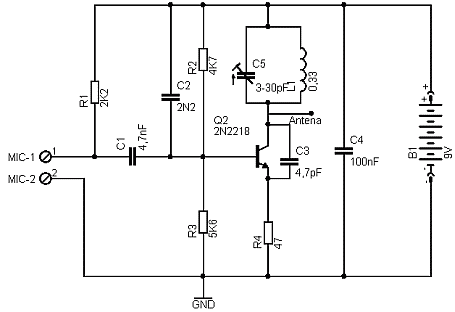 Here's simple FM transmitter circuit using medium power 2N2218 transistor. Micropohone is of electret type that connects to two input terminals and the antenna should be a copper wire from 15 to 40 cm. Below is schematic circuit of the fm transmitter.
Posted on Sunday, November 13, 2011 • Category: AM Radio
 AM radio built around 555 timer chip. The only active device (silicon, germanium, or otherwise) is the LM555. The tuning is accomplished with an inductor and a capacitor, and the LM555 acts as an AM demodulator and class-D power amplifier to drive the speaker. You may be wondering how all this is accomplished with a 555. Here’s how the circuit works: The AM radio signal is tuned by inductor L, which is 300 turns of wire on a 1/2 inch diameter cardboard tube made out of a paper roll, along with the 100pF variable capacitor. One end of the parallel configuration of L and C connects to an antenna (surprisingly long!) and the other end connects to a ground wire which is tied to the AC outlet ground (old books tell you to ground it to a water pipe). So far this is exactly like an AM crystal radio.
The 555 timer is configured as a pulse width modulator in a non-traditional configuration. If I used the standard approach and connected the input to the CV pin, the low impedance of the pin would prevent the circuit from receiving any radio signals. I had to invert the circuit and tie both high impedance analog pins, Threshold and Trigger to the radio signal input. This is the reason why the CMOS version of the 555 timer performs much better than the standard bipolar, which has higher input bias current.
Posted on Friday, November 4, 2011 • Category: Antennas
 This is a simple active antenna booster. This amplifier will pull in all distant FM stations clearly. The circuits is configured as a common-emitter tuned RF preamplifier wired around VHF/UHF transistor Q1. Input coil L1 consists of four turns of 20SWG enameled copper wire (slightly space wound) over 5mm diameter former. It is tapped at the first turn from ground lead side. Coil L2 is similar to L1, but has only three turns. Pin configuration of transistor 2SC2570 is shown in the fm antenna booster schematic. Adjust input/output trimmers (VC1/VC2) for maximum gain.
Posted on Friday, November 4, 2011 • Category: Amplifiers
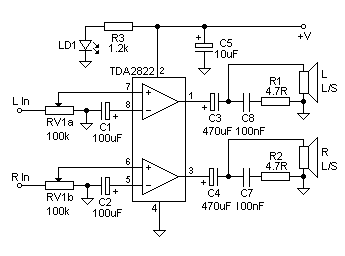 Here's low power stereo amplifier built around TDA2822 chip. Many people may have heard of the TDA2822 before, but for those who haven't, it is a small power amplifier that will drive two channels. It is usually in an 8-pin DIL package, but older versions I have seen are 14-pin or similar (there are datasheets for both variants). For simplicity though, my circuits show schematics for the 8-pin DIL package. The datasheet is here, provided by ST. This article is based along the usage of the TDA2822M variant of the chip series as it is commonly available. The TDA2822 is similar, but has slightly more pins so is less used.
Posted on Friday, October 28, 2011 • Category: FM Transmitters
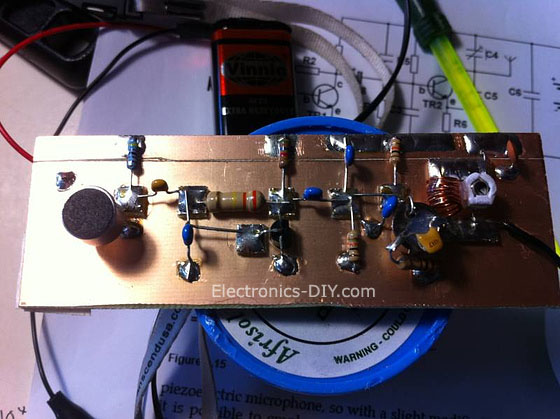 Here's 1W RF Amplifier is for boosting small fm transmitters and bugs. It use two Philips 2N4427 and its power is about 1Watt. At the output you can drive any linear with BGY133 or BLY87 and so on. Its power supply has to give 500mA current at 12 Volts. More voltage can boost the distance but the transistors will be burned much earlier than usual.! In any case do not exceed the 15Volts. The Amp offers 15 dB in the area of 80Mhz to 110 Mhz. L4, L5, and L6 are 5mm diameter air coils, 8 turns, with wire 1mm wire diameter.An easy project, with great results.
Posted on Thursday, October 27, 2011 • Category: Amplifiers
 I built my first power amplifier when I was still in secondary school. The circuit was made of transistors, didn't provide much power and had an ugly PCB.
Around the same time I got access to a datasheet of TDA1524, a tone/volume control circuit, and I decided to use it to build a pre-amplifier, to improve the quality of the sound coming out of the amplifer. Both circuits worked well for almost a decade but the old amplifier was never up to my expectations.
In 2006 I decided that it was time to build a real power amplifier, this time based on an integrated circuit to reduce the number of external components and cost.
Posted on Sunday, October 23, 2011 • Category: FM Transmitters
 A high quality stereo FM transmitter circuit is shown here. The circuit is based on the IC BA1404 from ROHM Semiconductors. BA1404 is a monolithic FM stereo modulator that has built in stereo modulator, FM modulator and RF amplifier. The FM modulator can be operated from 76 to 108MHz and power supply for the circuit can be anything between 1.25 to 3 volts.
In the circuit R7, C16, C14 and R6, C15, C13 forms the pre-emphasis network for the right and left channels respectively. This is done for matching the frequency response of the FM transmitter with the FM receiver. Inductor L1 and capacitor C5 is used to set the oscillator frequency. Network C9,C10, R4,R5 improves the channel separation. 38kHz crystal X1 is connected between pins 5 and 6 of the IC. Composite stereo signal is created by the stereo modulator circuit using the 38kHz quartz controlled frequency.
Posted on Sunday, October 23, 2011 • Category: Power Supplies
 This is an add-on over voltage protection circuit for LM317 voltage regulator. It is a voltage regulator that allows a 6V portable supply to be derived from the 12V car battery. You can add a 6.2V zener diode and a LED to warn you when the input supply is overvoltage. If you could find a relay that would operate from 6.2V right up to 12v that you could connect in such a way that if over voltage occurred, then the relay would automatically switch off the output preventing damage to any connected equipment.
Such a relay would be quite difficult to find, so I designed this, it is a simple two transistor circuit which will switch off the output should the voltage raise above 6.2v this can be changed by selecting a different value of zener diode.
Posted on Tuesday, October 18, 2011 • Category: FM Transmitters
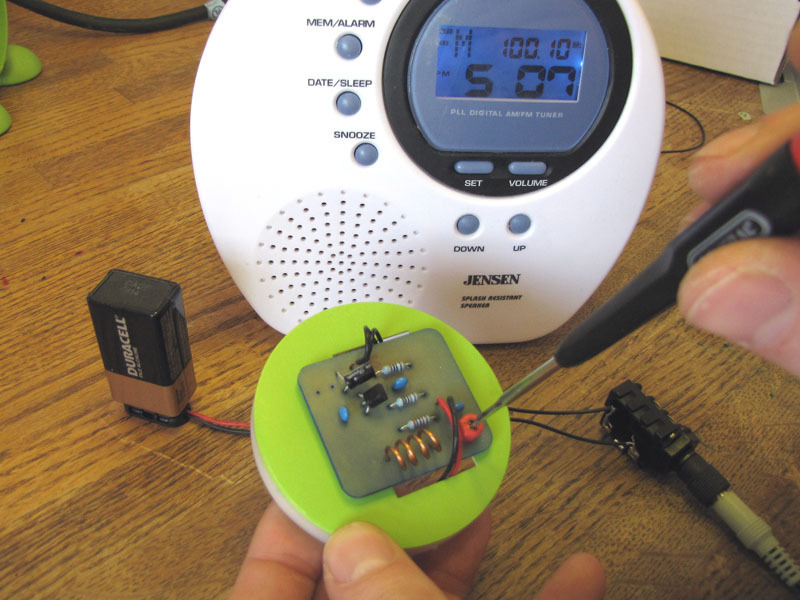 This simple FM Transmitter takes audio input through a 1/4" phono jack and, constructed as shown, without the optional antenna connections, will broadcast an FM radio signal about 30 feet. This is the standard model of simplest FM transmitters includes a trim capacitor to adjust the transmitting frequency. It can be powered by a 9V battery and uses a hand-turned copper coil. The circuit is extraordinarily simple and could be built on perfboard or on a panel almost as easily.
Posted on Wednesday, October 12, 2011 • Category: FM Transmitters
 This is a simple design of a small FM Transmitter Bug that's perfect for transmitting and eavesdropping purposes. Due to the high sensitivity, even the ticking of the clock to hear. The range is estimated at anything from 50 meters. With a small piece of wire as an antenna to get at least the whole house. L1 and L2 are two equal air pools. They each consist of 5 turns at a diameter of about 4 mm. The thickness of the wire does not matter, 0.5 mm works perfectly. C4 is the frequency adjustment. Tune an FM radio in an empty area of the FM band and C4 to turn your silence or hear a whistle. From what you can precisely adjust the radio and the transmitter installed in a room somewhere to intercept. Note: Because these transmitter bugs inherently unstable, you better read the short legs of the components keep the circuit mechanically tightly together up. Also placing a 1 nF capacitor (C6) will benefit stability.
R1, R3, R4: 4K7
R2: 100K
R5: 10K
R6: 270 Ohms
C1, C2: 10 uF
C3, C6: 1 nF
C4: 2-18 pF trimmer
C5: 5.6 pF
L1, L2: air puddle windings on May 4 mm in diameter (see text)
T1, T2: 547 BC
Condenser microphone
Original Text:
Ook het plaatsen van een 1 nF condensatortje (C6) over de voedingsaanluitingen komt de werking ten goede. [Origineel TinyCAD ontwerp]
Show alternative translations
Posted on Saturday, October 8, 2011 • Category: Power Supplies
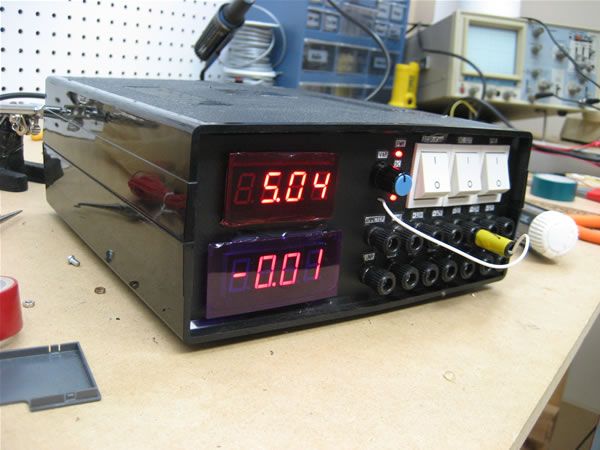 Presented here is a circuit for 30V 10A variable bench power supply that offers variable voltage and current adjustment. Power supply is based around a LM723 voltage regulator chip and has current limiting. I often end up with the power clips shorting out on the bench and with no problems. I have had this circuit in use now for over 20 years and has never let me down and is one of the most handiest gadgets i have built. The 2N3055 transistors are a well proven high current transistor. More 2N3055 transistors can be connected together for more output current. The transistors will need to be mounted on a good size heatsink.
Posted on Friday, September 23, 2011 • Category: FM Transmitters
 The circuit shown here is of a good Stereo FM transmitter that can transmit high quality signals up to a range of 70 feet. The circuit is based on BH1417 PLL stereo transmitter IC from Rhom semiconductors. The IC has separate audio processing sections for the left and right channels, pre emphasis circuit for improving signal to noise ratio, crystal control circuitry for accurate frequency locking, multiplex circuit for making sum ( left plus right) and difference ( left minus right) {see this article for better understanding Stereo decoder circuit} etc. Another important feature of this IC is that the transmission frequency can be set using a 4 channel DIP switch. The IC can be powered from anything between 4 to 6V DC and has an output power around 20mW. At full output power the circuit consumes only 20mA and has a channel separation of 40dB.There are 14 possible preset transmission frequencies, starting from 88.7MHz and incrementing in steps of 0.2MHz that can be selected using the DIP switch. The PLL circuitry of the IC is so precise that there is practically no frequency drift.
Posted on Sunday, September 11, 2011 • Category: Test and Measurement
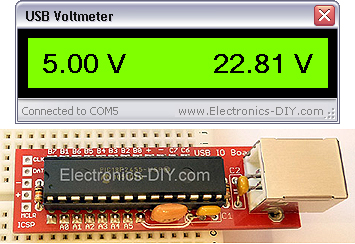 USB Voltmeter is a PC based dual channel voltmeter built around PIC18F2455 / PIC18F2550 microcontroller that measures voltage from 0.00V up to 500.00V with 10mV resolution. USB Voltmeter sends measured data to PC via standard USB connection displaying data on a computer monitor. USB Voltmeter is self-powered drawing very little current from USB port. Voltage readings are displayed via included USB Voltmeter software.
Posted on Thursday, August 25, 2011 • Category: FM Transmitters
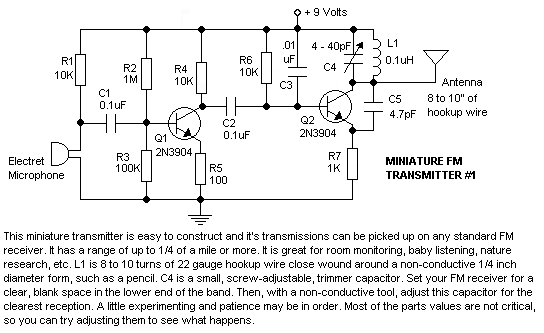 This miniature transmitter is easy to construct and it's transmissions can be picked up on any standard FM receiver. It has a range of up to 1/4 of a mile or more. It is great for room monitoring, baby listening, nature research, etc. L1 is 8 to 10 turns of 22 gauge hookup wire close wound around a non-conductive 1/4 inch diameter form, such as a pencil. C4 is a small, screw-adjustable, trimmer capacitor. Set your FM receiver for a clear, blank space in the lower end of the band. Then, with a non-conductive tool, adjust this capacitor for the clearest reception. A little experimenting and patience may be in order. Most of the parts' values are not critical, so you can try adjusting them to see what happens.
Posted on Monday, August 22, 2011 • Category: Amplifiers
 Several years ago, National Semiconductor came up with some very high performance, easy to use audio power amplifier LM3886 circuits. I needed an extra amp so I can bi-amp some of my homemade electrostatic speakers so I tried the LM3886 chip. LM3886 amplifier was chosen because of ease of use, performance, low distortion and a built-in protection against short circuits and thermal instability. There is not much to remove a power amp, than asking. When driving electrostatic speakers, you can not be much protection.
There are people who have “golden ears” and the feeling, provided that no application note scheme is never good enough for it to “Optimize” to “improvements” to make a claim. The problem is that most of them do not engineers and have no idea what the possible consequences of their “improvements” can be. For example, for a few years if these chips were popular with the audiophile crowd, it was all the rage at minimum power filter caps for “Best Sound” to use. We are talking about 500 uF on each power rail for each chip used LM3886 amplifier. This is clearly insufficient and leads to a distortion in the volume low enough that the power supply sags under load. The problem was that some of the golden ears of the large power supply rejection IC spec saw and thought it meant that the chip could tolerate the 10V power supply ripple. The pendulum has swung the other way, and now many music lovers are sufficient amounts of energy storage in the diet.
Posted on Friday, August 12, 2011 • Category: TV Transmitters
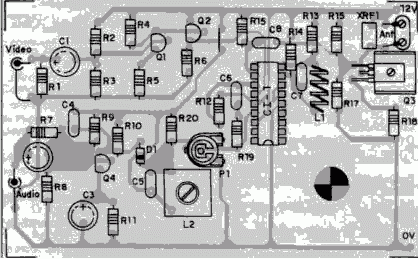 This TV transmitter transmits audio and video signal from Camcoder Camera, DVD, VHS, Satellite, video game, etc. Playing them in a channel free from the strip of VHF.
These signal can be radiated with a common antenna and captured in an it distances of until about 500 meters that it is the most appropriate for urban areas, reminding that and necessary to be a lot of caution and careful for not interfering in frequencies of other issuing, as well as to emergency services. Depending on the local conditions (existence or not of obstacles). Fed with tensions from 12 to 15 Volts, the circuit has excellent I carry out so much in the emission of monochrome signal, as in colors. An important point of this project ‚the easiness with that he can be set up and adjusted, since only two coils are used. Ideal to be used with surveillance cameras turning the without thread.
As it Works the tv video and audio transmitter with lm1889n
The heart of this circuit transmitter ‚is the integrated circuit LM1889N of National Semiconductor, that consists of a Modulator of Video for TV in an involucres of 18 pins DIL.
Posted on Wednesday, August 10, 2011 • Category: Test and Measurement
 Even if the digital multimeter have dominated in a lot of applications, in the measurement, exist the need for existence of instruments of clue in various appliances, voltage and current, as in power supply or elsewhere. The circuits that give make this precisely the work, measure the voltage in terminal a circuit and the current that passes in his. The circuit does not present particular difficulties for somebody that has a small experience. The two circuits are the himself, with a small difference only in their input, when they have they measure voltage or current and in connection that concern decimal point [ dp ]. In the department of input IC1 and IC3, exist the CA3161E, that is a A/D Converter for 3-Digit Display. In the drive of Display IC2 and IC4, exist CA3161E, that is a BCD the Seven Segment Decoder/ Driver. As it appear in Fig.1, that concern the voltmeter in input [ + IN ], exist in series a what resistor R1 in combination with the R3 create a voltage divider. On the contrary in the Fig.2 that it concern the ampere meter, this resistor does not exist, because the circuit is connected differently, thus the current pass through the R5, creating a fall of voltage, in her terminal, proportional current that it pass from this.
Posted on Monday, August 8, 2011 • Category: FM Transmitters
 Here is the circuit diagram of the simple FM transmitter using a transistor. Great performance or range is not guaranteed here, because this is an elementary design. General purpose radio frequency transistor BF 494 (Q1) is used here for obtaining FM modulation. A condenser mic is used here to pickup the sound.The condenser mic converts the sound to electrical variations and this variations are fed to the base of Q1 , which performs the amplification as well as modulation.The capacitor C2 and L1 determines the frequency of transmission.The circuit can be powered from a 9V transistor radio battery.
Posted on Saturday, August 6, 2011 • Category: Test and Measurement
 I wanted a digital AC voltmeter to measure the output range from 0 to 150VAC with reasonable accuracy. Sure I could buy some premade DVM packages or use a microcontroller with a built-in ADC, but I wanted to make one from scratch myself using readily available parts I had on hand. I aimed for reasonable accuracy so I chose to have a 2 and a half display for the voltage, meaning the meter reads from 000 to 199. Below is the schematic of the AC DVM.
Posted on Thursday, August 4, 2011 • Category: FM Transmitters
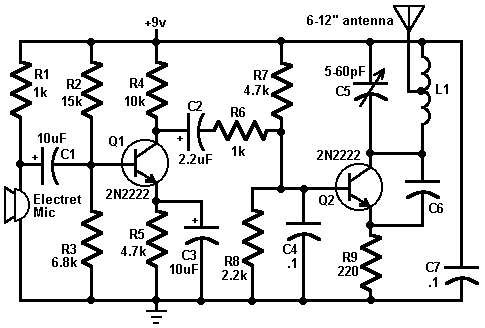 FM transmitter or often called fm transmitter uses 2 transistors in this article uses 2 transistors 2n2222. If the fm transmitter is in use voltage supply of 9 volt battery and use an antenna whose length is less than 12 inches, then this fm transmitter will be within FCC limits.
Signals from the microphone in the fm transmitter is reinforced by Q1, Q2 with carrier frequency generator is determined by the C5 and L1. The frequency of the FM transmitter is in the range 80 MHz - 108 MHz. L1 can be made with as many as 24 e-mail wire wrap and 6 wrap. The following is a picture series for the fm transmitter fm transmitter referred to in article 2 of this transistor.
Posted on Thursday, August 4, 2011 • Category: FM Radio / Receivers
 FM Radio Receiver IC TDA 7012T is very simple, but Radio This FM receiver has good sensitivity and selectivity. Single Chip TDA 7012T FM Receiver is to build an FM receiver requires a few additional components.
Feature contained in FM receiver IC TDA 7012T is quite tempting to an FM receiver. Among features an FM receiver TDA 7012T is a low-voltage applications micro affability arrangement (MTS), Frequency Locked Loop (PLL) to 76 KHz range and selectivity of FM receiver with RC Filter. In an article by FM Radio Receiver IC TDA 7012T can be seen in the FM receiver circuit which can be made.
Posted on Wednesday, August 3, 2011 • Category: Test and Measurement
 Here's hygrometer thermometer that simultaneously monitors both humidity and temperature on large LCD display which can be read from across the room. It's great for labs, chemical storage areas, clean rooms, stock rooms, warehouses, factories, greenhouses, and outdoors. Monitor humidity and temperature in your room, kitchen, desiccators, incubators, refrigerators, and fume hoods. Comes with AG13/LR44 battery. Temperature range -10 C to 50 C (14 F to 122 F). Humidity range 20% RH to 95% RH.
Posted on Monday, August 1, 2011 • Category: FM Transmitters
 If you want to be independent of the local radio stations for testing VHF receivers, you need a frequency-modulated oscillator that covers the range of 89.5 to 108 MHz — but building such an oscillator using discrete components is not that easy. Maxim now has available a series of five integrated oscillator building blocks in the MAX260x series which cover the frequency range between 45 and 650 MHz. The only other thing you need is a suitable external coil, dimensioned for the midrange frequency.
Posted on Saturday, July 30, 2011 • Category: AVR
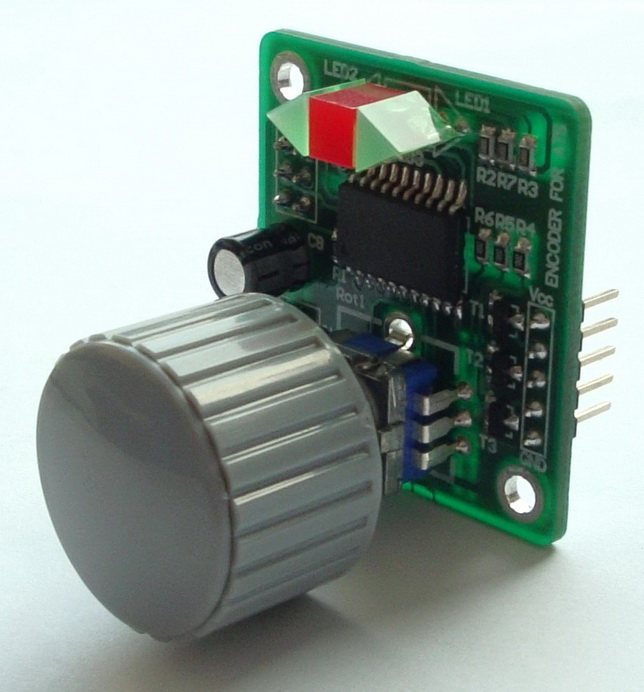 This equipment is dedicated for an easier control of the popular mini-transceiver AT Sprint known by ham radio operators as ATS (series ATS-2, ATS-3, A, B, B.1 compatible). Originally the ATS has just four push buttons on the top cover and in combination with the paddle it is possible to send all commands to ATS including the tuning, scanning etc. After connecting the rotary encoder accessory module an easy tune, scan and other functions are available as same as on the big size desktop transceivers. Comfort and operation is much higher even with this mini transceiver.
Posted on Wednesday, July 27, 2011 • Category: FM Transmitters
 A very good 1 watt fm transmitter circuit, very easy to build circuit. It has 4 transistors, one is a very stable oscillator, followed by a buffer stage to prevent frequency variation when you adjust the transmitter. Next is a resonance stage and the final stage built with a minimum 1W transistor which must have a heatsink. You must use a LM7805 stabilizer for the oscillator diodes and one LM7809 for powering up the T1 oscillator stage. This will give you a very stable transmitter frequency.
Posted on Monday, July 25, 2011 • Category: FM Radio / Receivers
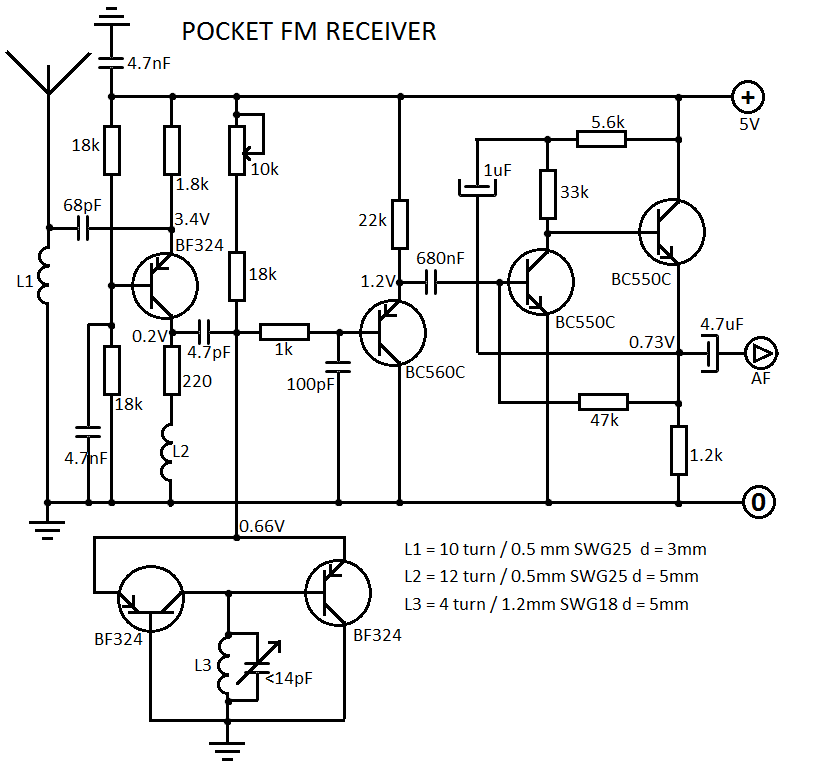 This is the most simple fm radio receiver with good performances that works great even if the sensitivity is not too high. The working principle of this fm receiver may seem a little unusual. It is made of an oscillator (T2 and T3) that is synchronized with the received frequency of T1. This transistor works as a broadband preamplifier in VHF range.
Posted on Friday, July 22, 2011 • Category: FM Radio / Receivers
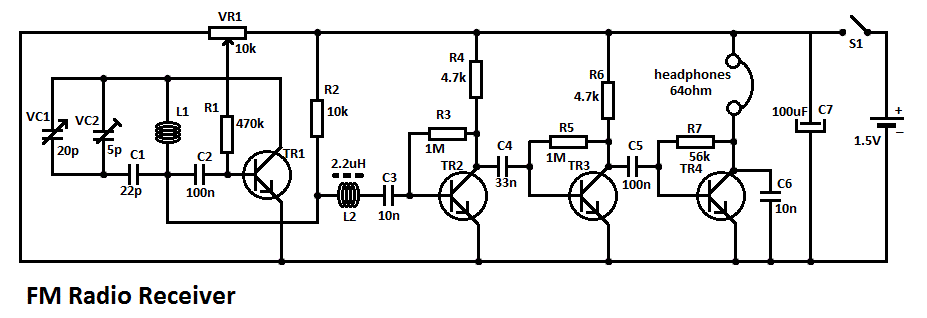 This simple fm radio receiver circuit consists of a regenerative rf stage, TR1, followed by a two of three-stage audio amplifier, TR2 to TR4. In some areas 3 stages of audio amplification may not be necessary, in which case TR3 and its associated components can be omitted and the free end of capacitor C5 connected to the collector of TR2.
Posted on Tuesday, July 19, 2011 • Category: Antennas
 This is a low cost fm antenna booster that can be used to listen to programs from distant FM radio stations clearly. The antenna fm booster circuit comprises a common-emitter tuned RF preamplifier wired around VHF/UHF transistor 2SC2570 (C2570).
Assemble the circuit on a good-quality PCB (preferably, glass-epoxy). Adjust input/output trimmers (VC1/VC2) for maximum gain.
Posted on Monday, July 18, 2011 • Category: LED
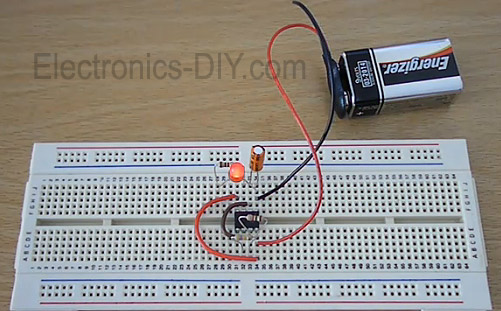 Here's a simple circuit that flashes an LED on and off. This circuit uses the 555 timer in an Astable operating mode which generates a continuous output via Pin 3 in the form of a square wave. This turns the LED (D1) on and off. The speed at which the LED (D1) is turned on and off is set by the values of R1 and R2.
Posted on Monday, July 18, 2011 • Category: FM Transmitters
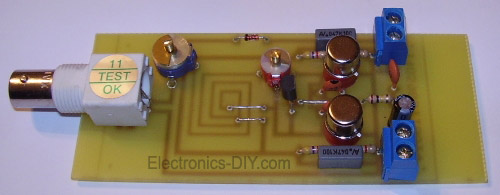 This 2 Watt FM transmitter will provide 10km range in good weather conditions. Use dipole antenna for maximum range. Transmitter can be tuned between 88-108 MHz with c5. BB204 could be replaced with conventional led (big) with reverse bias (no light given in correct polarity). 9v power for 2km transmission with good sound quality and up to 18v for 10km range. 2N3553 RF transistors may be replaced with 2N4427 or 2N3866.
Posted on Monday, July 18, 2011 • Category: AVR
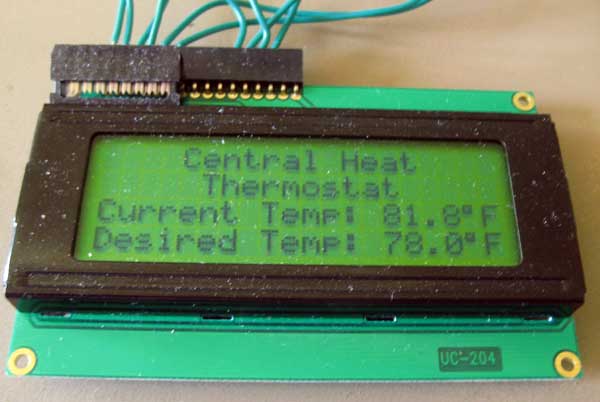 I wanted to share my project of modifying the temperature sensor project and turning it into a thermostat with ATmega168. I added a digital output to drive an LED to "warm" the temperature sensor when the current (actual) temperature falls below the desired temperature.
Two push buttons come in as digital inputs one to ramp the desired temperature up and the other to ramp it down.
The logic is simple bang-bang control to turn the LED on and off based on the relationship of actual temperature to desired temperature. It simulates a thermostat in heater mode. The LED is off when the current temperature is above the desired temperature and turns on once the current temperature falls below.
Posted on Monday, July 18, 2011 • Category: FM Radio / Receivers
 This radio works with solar batteries that provide voltages between 0.5 and 2V. Microphones should be magnetic, high impedance (2k or more). The coil is wrapped around a ferrite rod 1 cm in diameter with 28AWG wire.
Posted on Monday, July 18, 2011 • Category: Miscellaneous
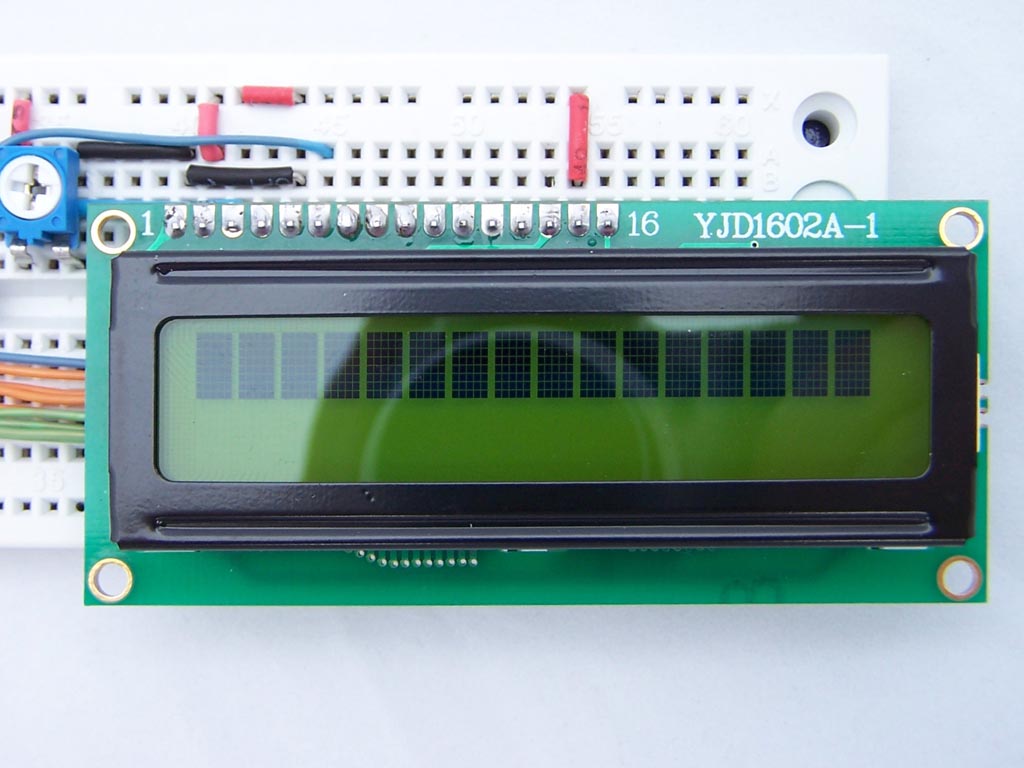 LCD character displays can be found in espresso machines, laser printers, children’s toys and maybe even the odd toaster. The Hitachi HD44780 controller has become an industry standard for these types of displays. This tutorial will teach you the basics of interfacing with a HD44780 compatible display using some DIP switches and a few other components.
Posted on Saturday, July 16, 2011 • Category: AVR
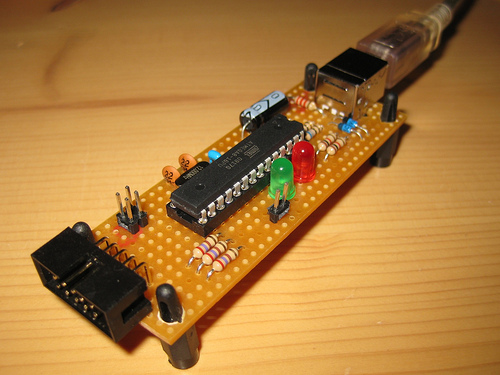 USB AVR Programmer for Atmel AVR microcontrollers. USB AVR Programmer is made of an Atmega8 and few components. The programmer uses a firmware driver that makes this programmer attractive to many amateurs.
Another thin why this programmer is so popular is because it is officially included and supported in WinAVR.
Once again lets see what this programmer is made off and how to set it up.
The core of USB AVR Programmer adapter is Atmega8 microcontroller clocked by 12MHz crystal. Soldered board is ready to be connected via simple USB cable with B type connector (Computer side needs A type of connector). Resistors R2 and R6 are current limiting resistors, that protect computer USB port. Resistor R7 helps computer to recognize device as LS (Low Speed). Diodes D1 and D2 indicates about data transfer. Header SV1 is compatible with STK200/300 just 4 and 6 pins are used for RXD and TXD (may be used for other purposes).
Posted on Friday, July 15, 2011 • Category: Power Supplies
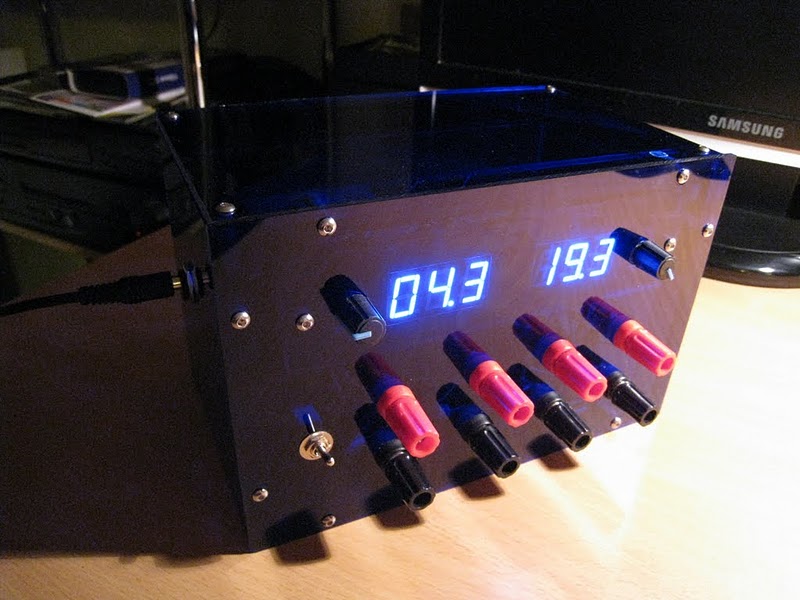 I’ve built myself my own universal, adjustable bench power supply.
This isn’t strictly astro stuff but the main reason I built it is to experiment with TFT backlight panels that I use for my lightboxes.
I needed 5V and 12V to play around with the inverter boards and figure out their pin-out. I considered buying a bench power supply. But prices were too high, especially for ones with adjustable voltages. So I decided to build my own.
This one has 4 outputs. One 5Volt, one 12V and two individually adjustable outputs going from about 1.5V to 19.5V. Each can draw up to 1.5Amp with a total of 3.5A for all together. The input is a standard replacement laptop power supply 20V, 3.5A. With a stronger external power supply the total output current can be higher, up to 1.5A per output. But currently the 3.5A is more than enough.
Each of the adjustable outputs has its own little voltmeter built in.
The fixed voltage regulators are based on a 7805 for the 5V and a 7812 for 12V. The two adjustable regulators are based on one LM317 each.
Posted on Friday, July 15, 2011 • Category: FM Transmitters
 This RF Amplifier designed for FM broadcast using a single 2SC1946 VHF Power Transistor. This 10-30W RF amplifier circuit provides an appropriate power boost with an input of 1-3 watt. Tower are 30 meters high will send signal surrounding air should be around 15 km. The layout of the 2SC1946 28 Watts FM broadcast RF amplifier has been created with Eagle. The pcb outline is 100 x 50 mm (width x height), all bitmaps have a resolution of 600dpi.Use FR-4 single sided photoresist epoxy pcb material for best results.
Posted on Thursday, July 14, 2011 • Category: PIC
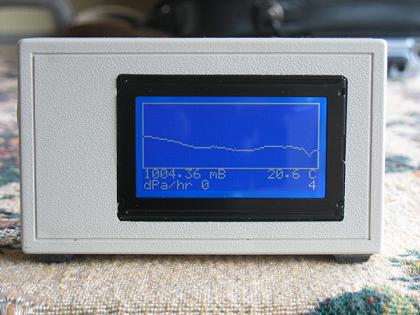 Here's a digital barometer that uses Atmega8 microcontroller and graphical LCD display. This project uses SCP barometer pressure sensor graphical LCD display connected to Atmega8 microcontroller. Graphical LCD displays latest 128 readings while one reading occur once in 20 minutes. You can see information of about two last days. Provided C source code can be customized to your liking.
Posted on Thursday, July 14, 2011 • Category: PIC
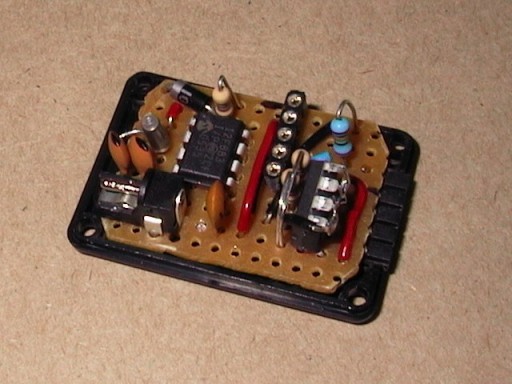 This project uses a Microchip PIC microcontroller, a serial EEPROM and a thermistor to create a temperature recorder.
The temperature is measured and stored at user programmable intervals; this can be from 1 second to 256 seconds. The time interval is set by programming it and the start time into the EEPROM.
Most of the time the PIC will be asleep and the EEPROM IC is inactive. This gives a very low current consumption of approximately 50 uA or about 1 mAh per day.
The EEPROM used is 32kBytes which can store up to 32,000 measurements. This could be one measurement every 30 seconds for 11 days for example.
The combination of thermistor and analogue circuit gives a range of between about -40 °C and +100 °C although the linear range is between about -10 °C and +40 °C.
Posted on Thursday, July 14, 2011 • Category: FM Transmitters
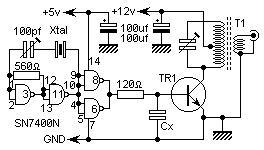 This is a very simple 5 watt CW TX based upon a TTL logic chip. There is just one "tricky" component and this is Cx. This component should have an impedance of about 10 - 50 ohms at the frequency of interest. If you wish to reduce the transmitter power, increase the value of Cx. It is Cx which causes the square wave from the output transistor to approximate a sine waveform. The value of Cx is the price of simplicity in this TX.
Posted on Wednesday, July 13, 2011 • Category: Battery Chargers
 Automatic battery charger automatically starts the charging procedure when battery voltage drops below a certain predefined value and stops after the voltage has risen above the maximum allowed value. Setup can't be easier, just connect two alligator clips to battery terminals and plug the device in mains. This way it can stay connected for months and the battery will never overcharge. This comes very very handy when you have a scooter or a real motorcycle that you don't drive during the winter time. Because we all know what happens to a battery when not used and especially during the winter.
Posted on Wednesday, July 13, 2011 • Category: Power Supplies
 There are many types of power supply. Most are designed to convert high voltage AC mains electricity to a suitable low voltage supply for electronics circuits and other devices. A power supply can by broken down into a series of blocks, each of which performs a particular function. Each of the blocks is described in more detail below:
Transformer - steps down high voltage AC mains to low voltage AC.
Rectifier - converts AC to DC, but the DC output is varying.
Smoothing - smooths the DC from varying greatly to a small ripple.
Regulator - eliminates ripple by setting DC output to a fixed voltage.
Posted on Wednesday, July 13, 2011 • Category: Test and Measurement
 Here is a very simple circuit that can b e used to check the hfe of transistors. Both PNP and NPN transistors can be checked using this circuit. Hfe as high as 1000 can be measured by using this circuit.The circuit is based on two constant current sources build around transistors Q1 and Q2.The Q1 is a PNP transistor and the constant current flows in the emitter lead. The value of constant current can be given by the equation; (V D1 -0.6)/ (R2+R4).The POT R4 can be adjusted to get a constant current of 10uA.
Posted on Tuesday, July 12, 2011 • Category: Power Supplies
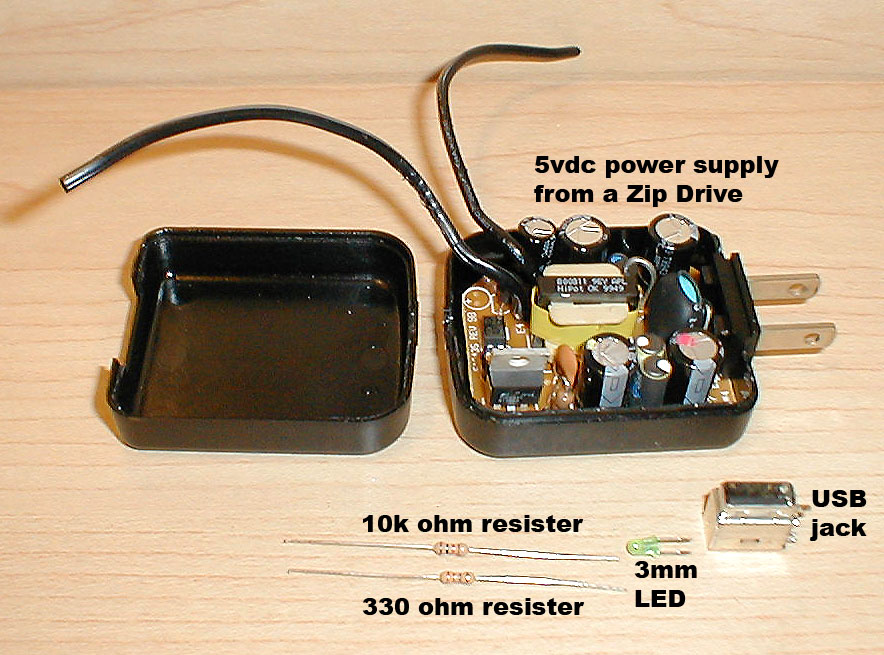 Here is a quick and easy way to make an USB charger / power supply powered by the wall outlet. This can be used to charge / power a PSP, iPod or any other USB device.
First you need to acquire a regulated 5 vdc wall wart rated at 500ma or higher. The one I used is from an IoMega Zip drive. It has a switching regulator with an output of 5vdc @ 1amp. This is a cool way of making an old wall-wart (plug in power supply) into a useful USB power supply and requires very few extra components.
Posted on Tuesday, July 12, 2011 • Category: Sensors
This is a simple water alarm. At the heart of this circuit is a small water sensor. For fabricating this water sensor, you need two foils—an aluminium foil and a plastic foil. You can assemble the sensor by rolling aluminium and plastic foils in the shape of a concentric cylinder. Connect one end of the insulated flexible wire on the aluminium foil and the other end to resistor R2. Now mount this sensor inside the water tap such that water can flow through it uninterrupted. To complete the circuit, connect another wire from the junction of pins 2 and 6 of IC1 to the water pipeline or the water tap itself.
Posted on Monday, July 11, 2011 • Category: FM Transmitters
|
|